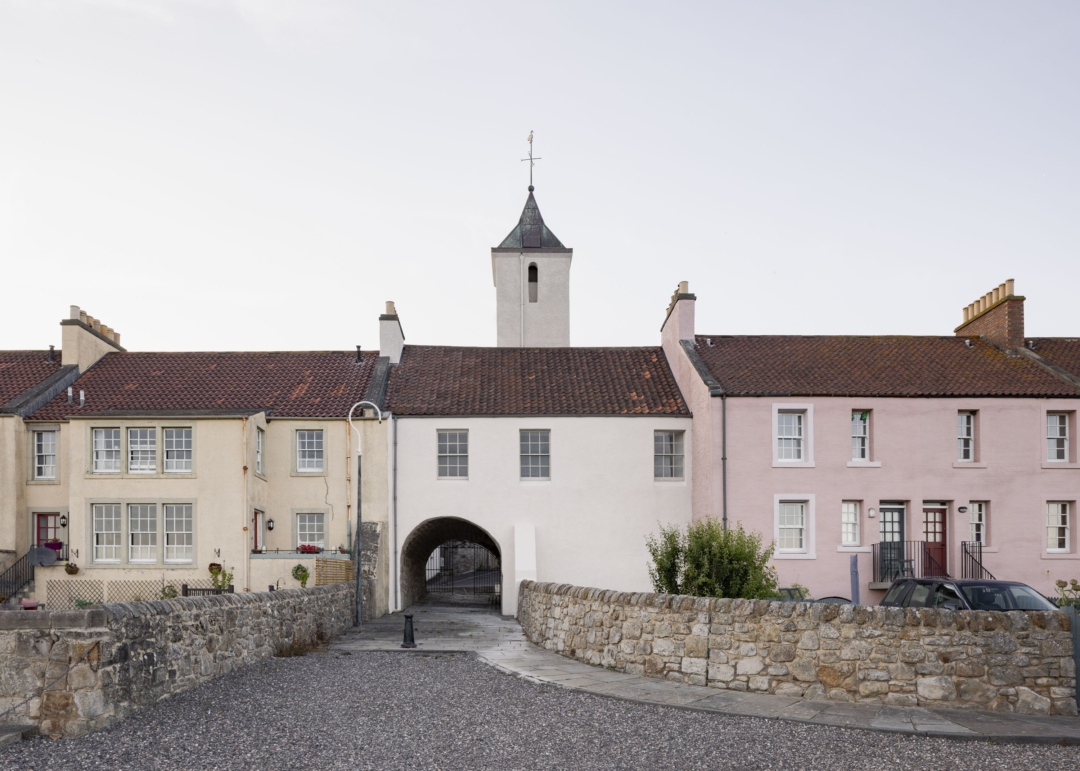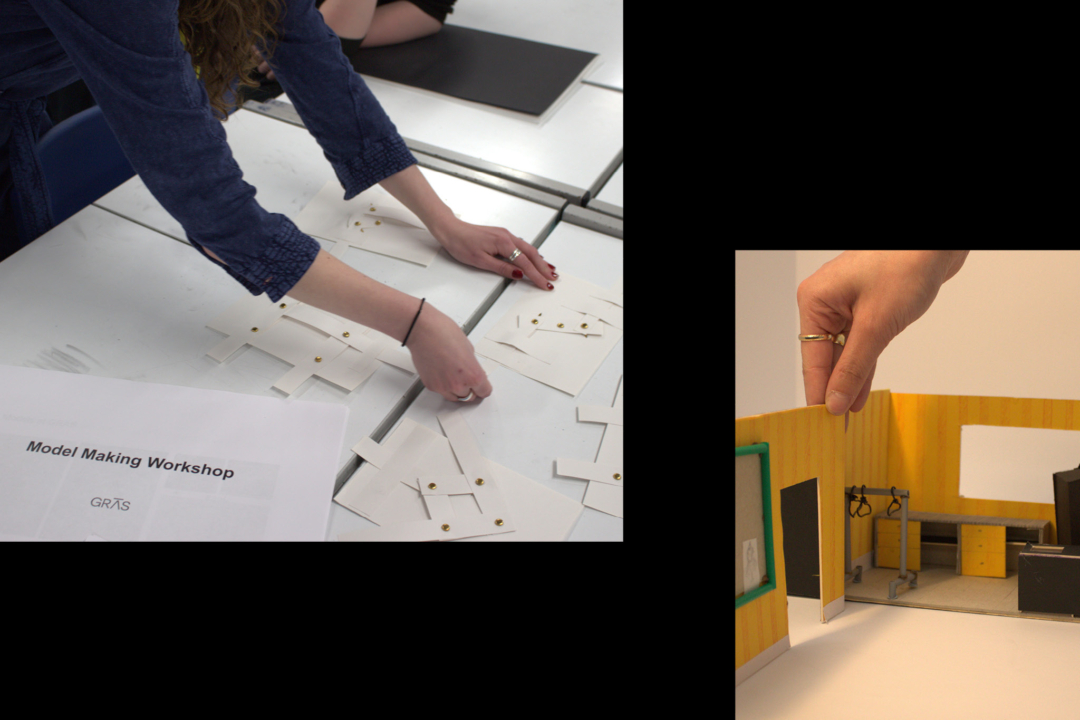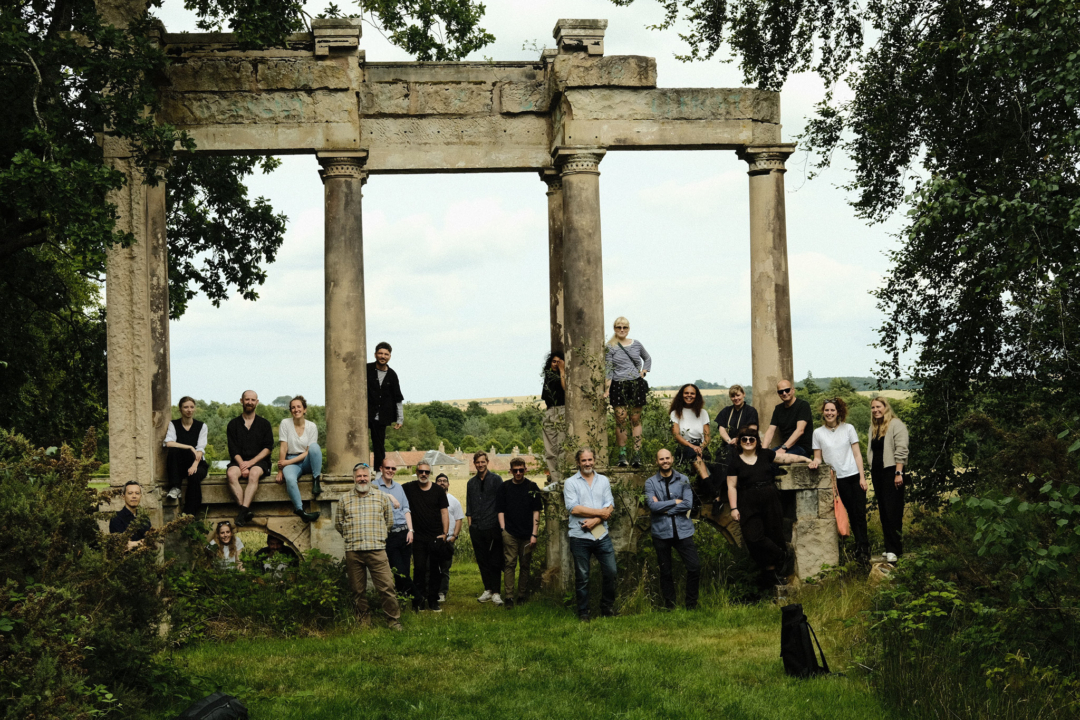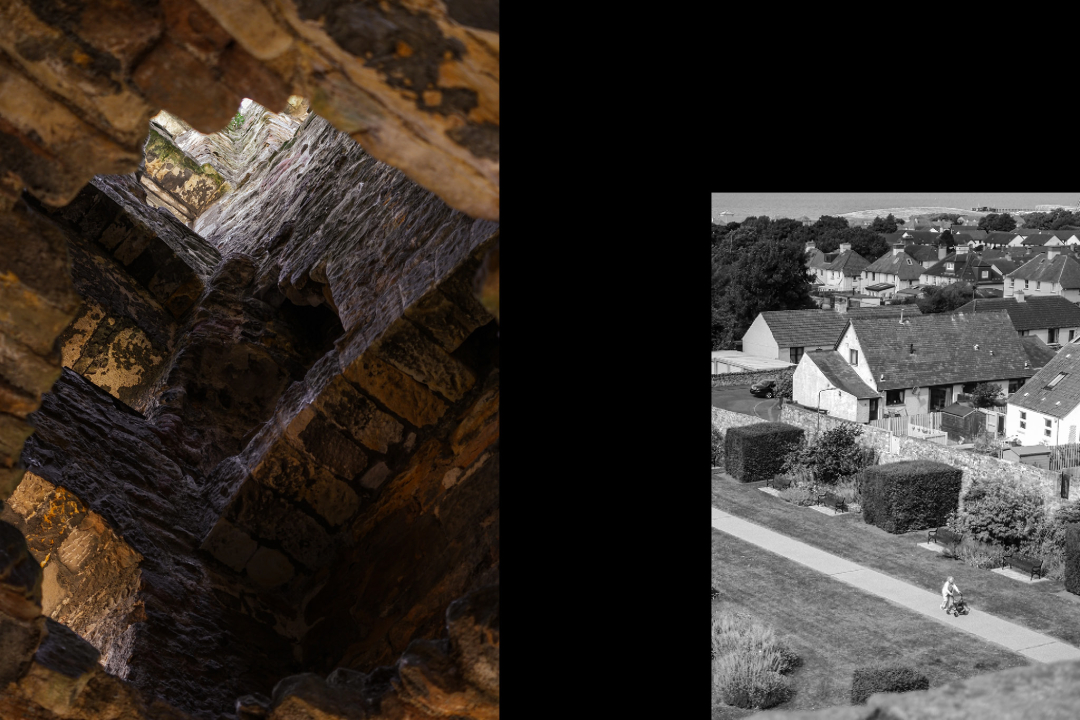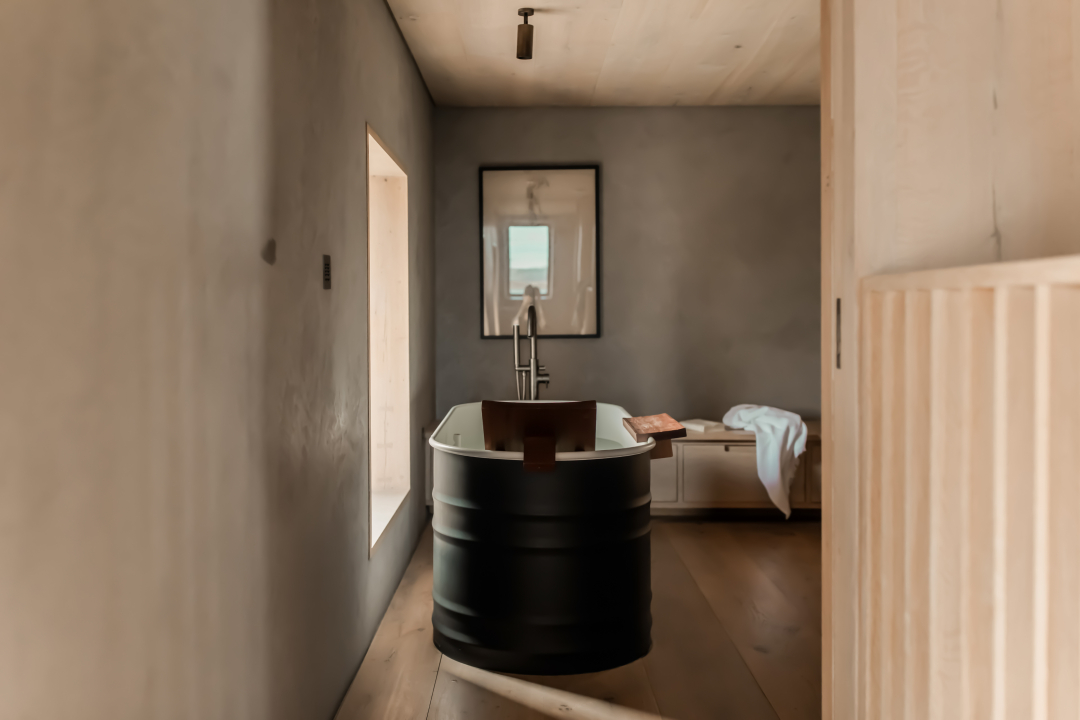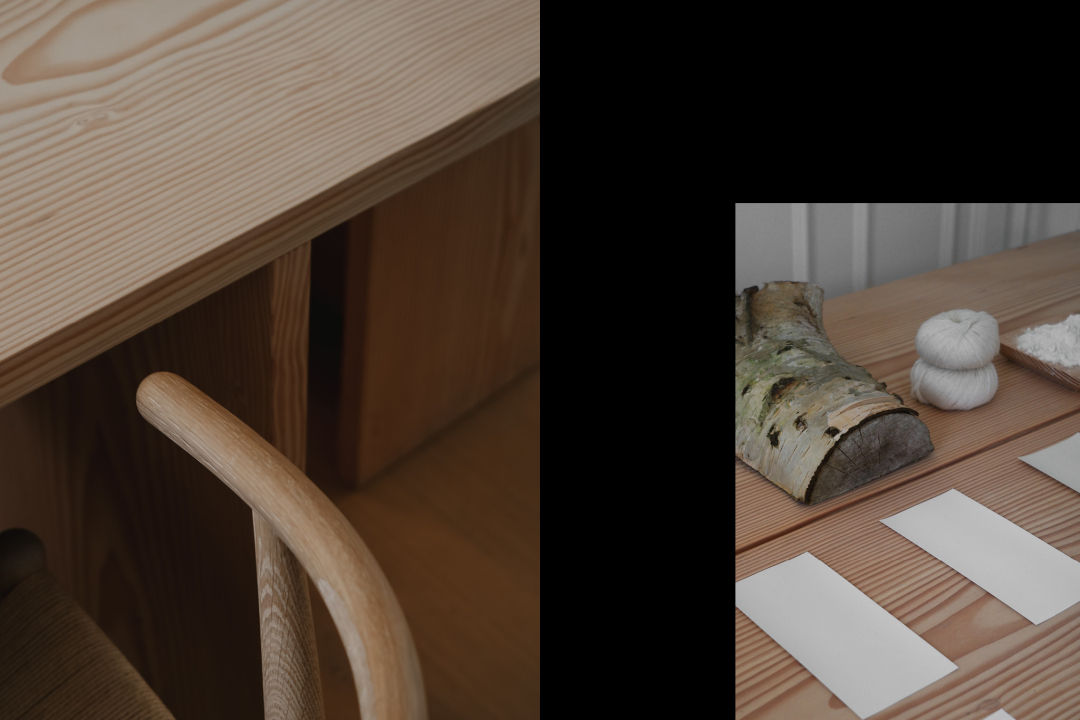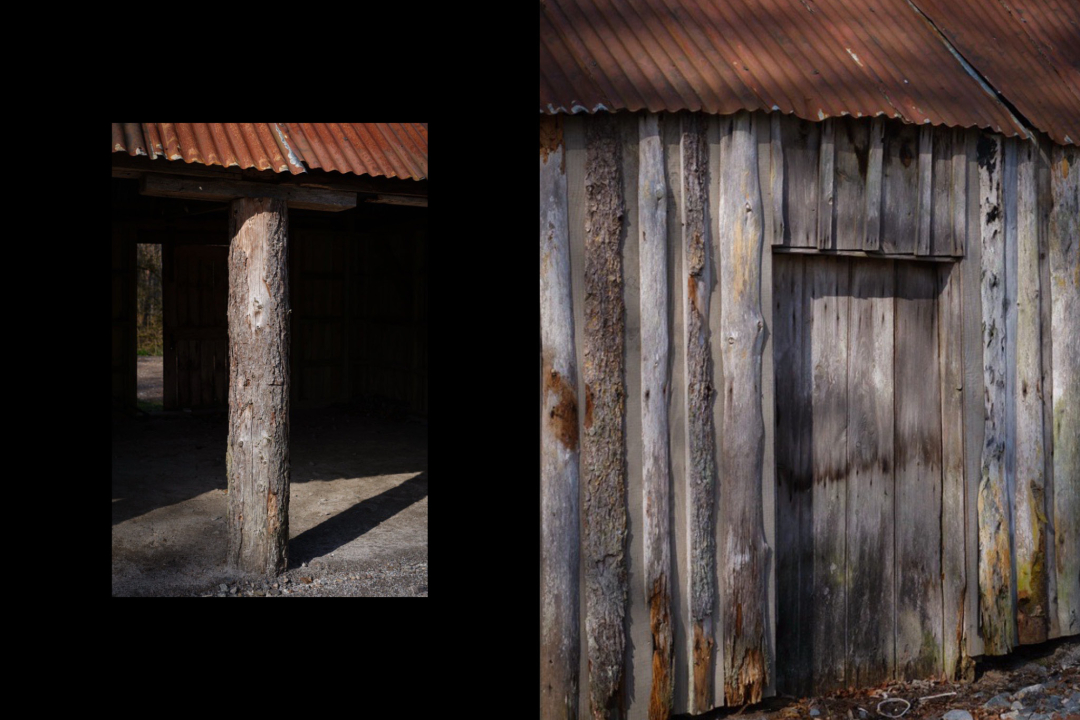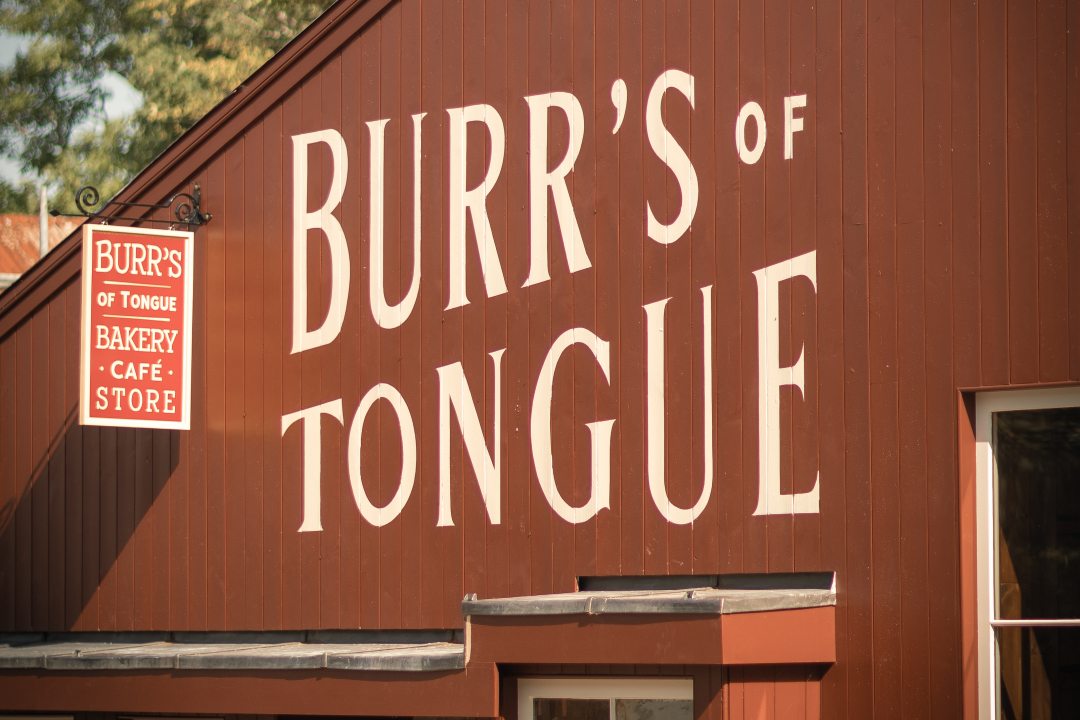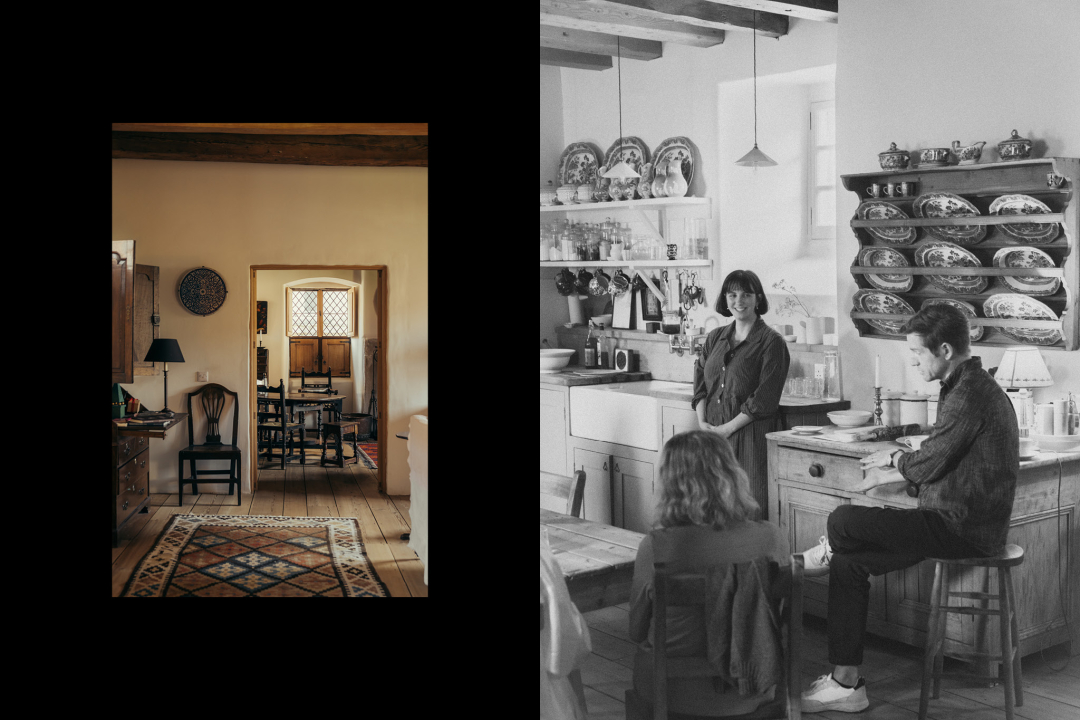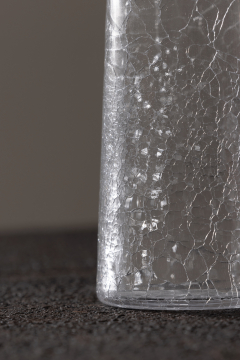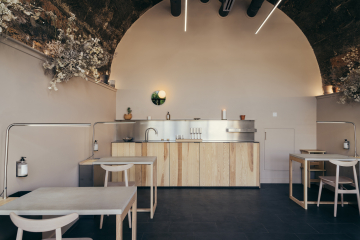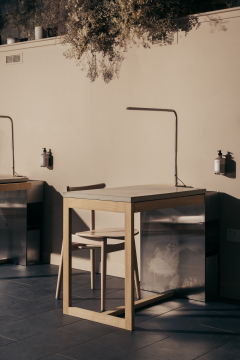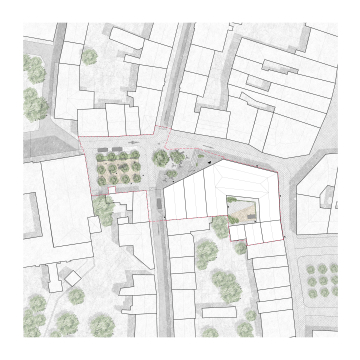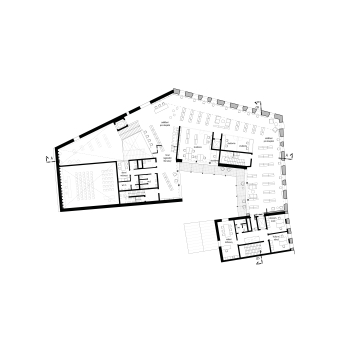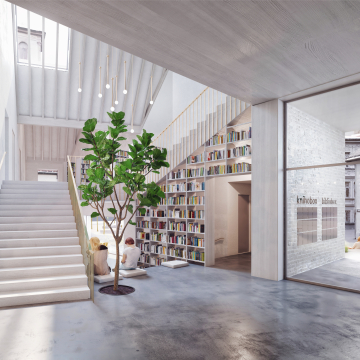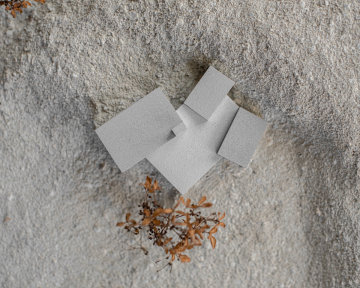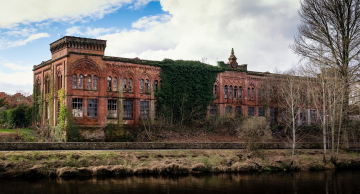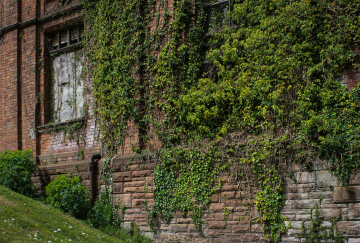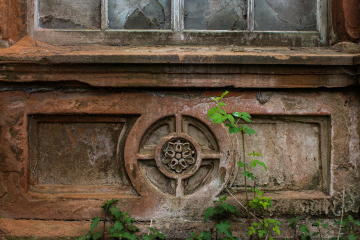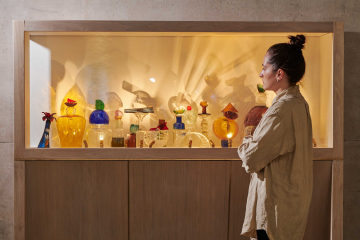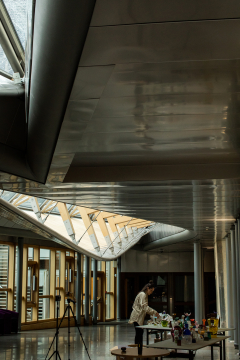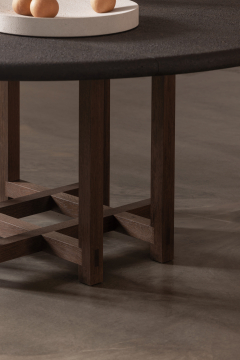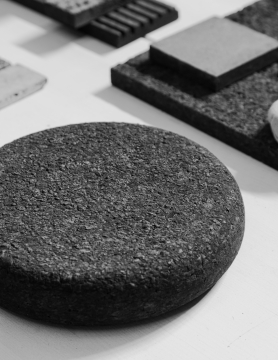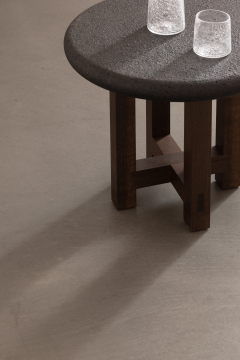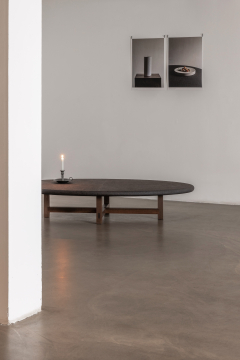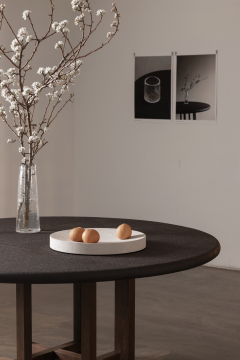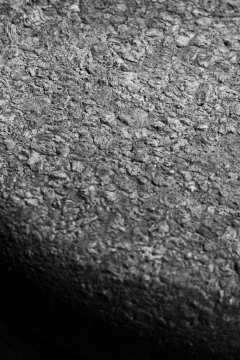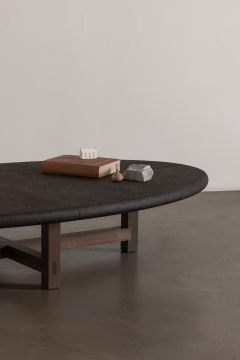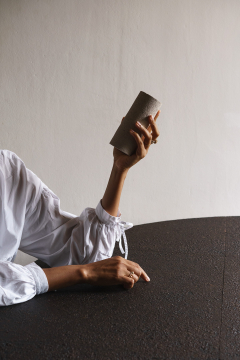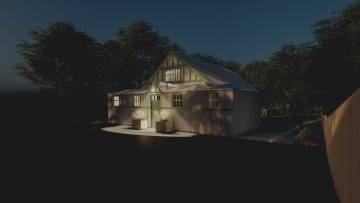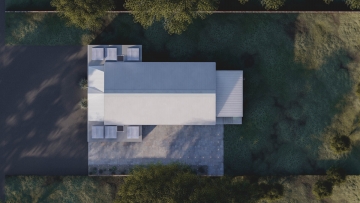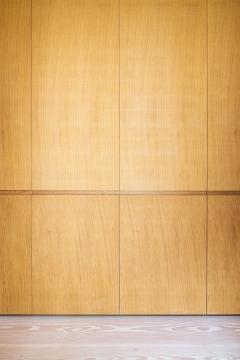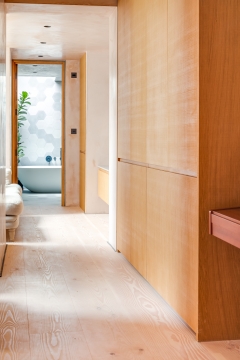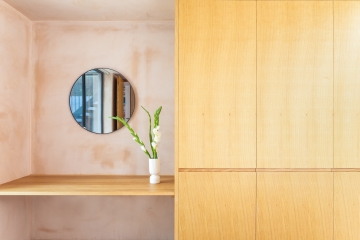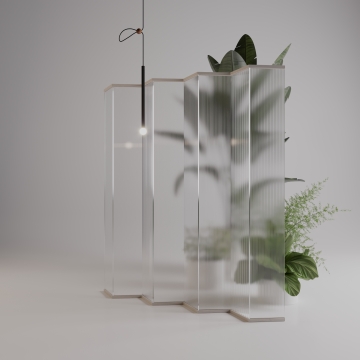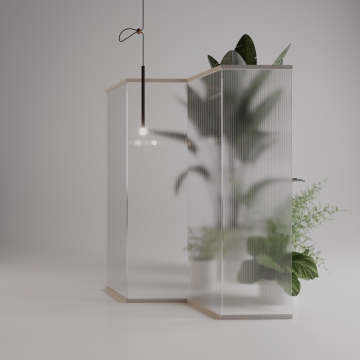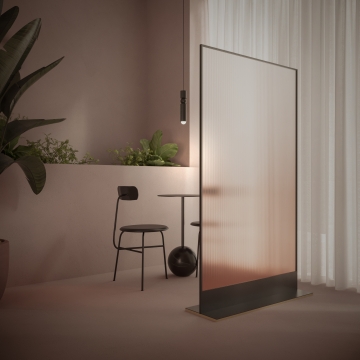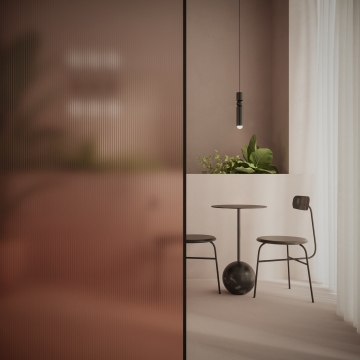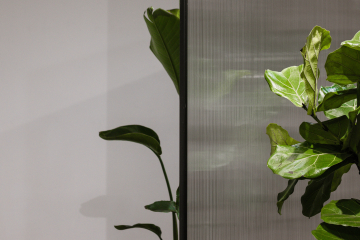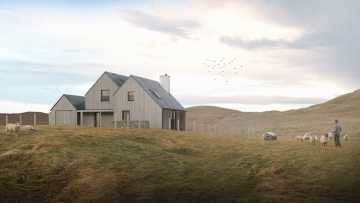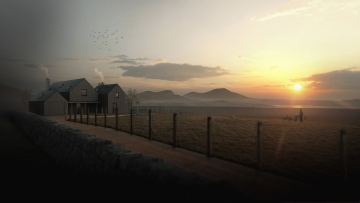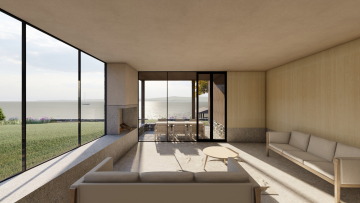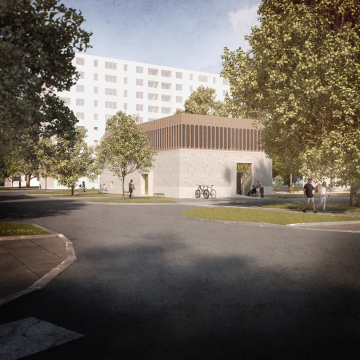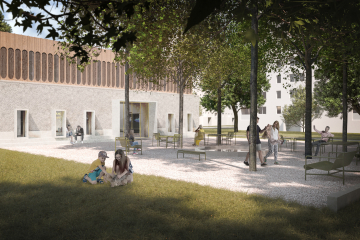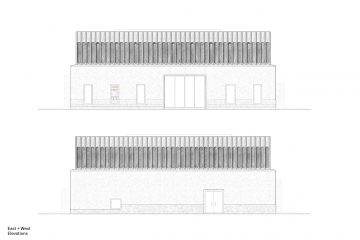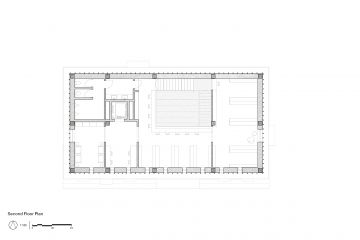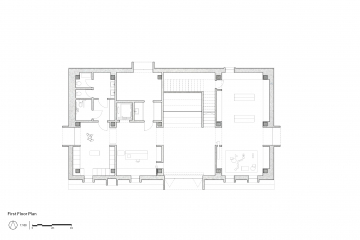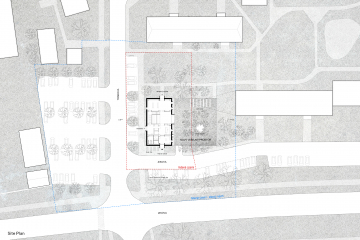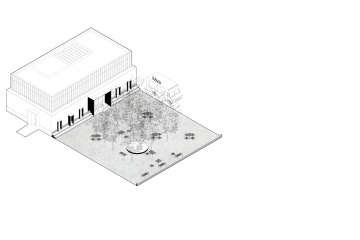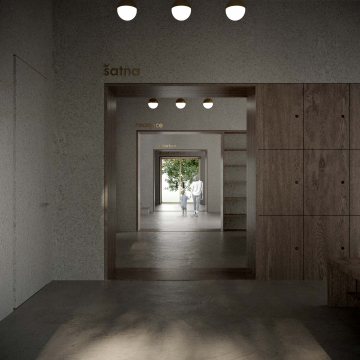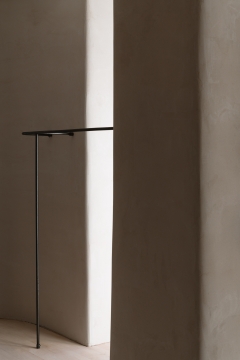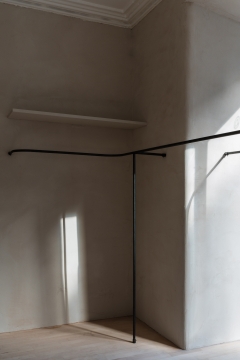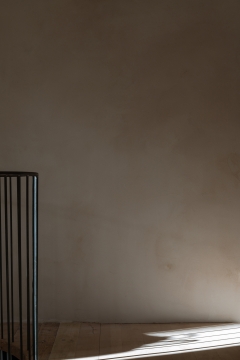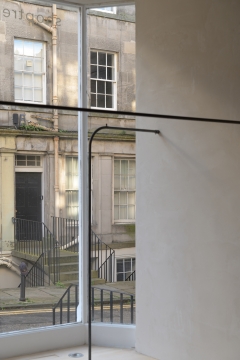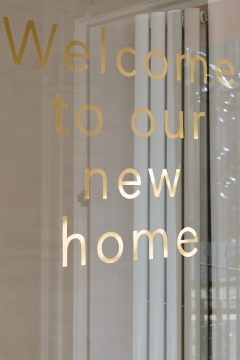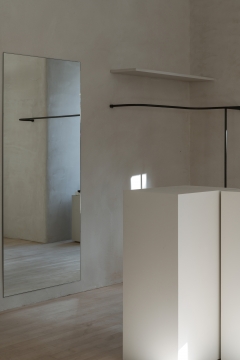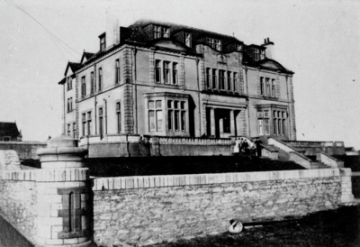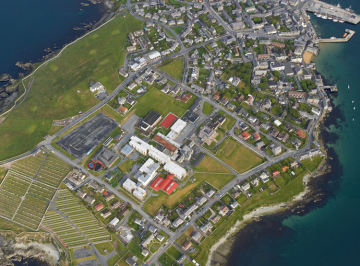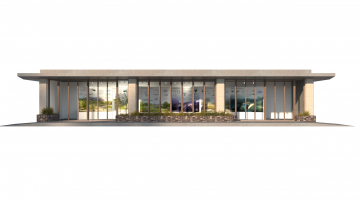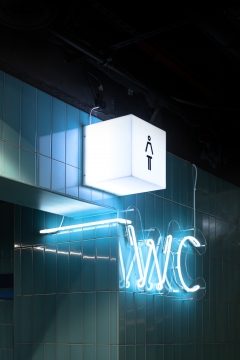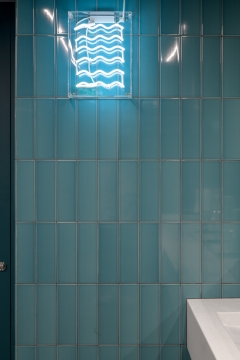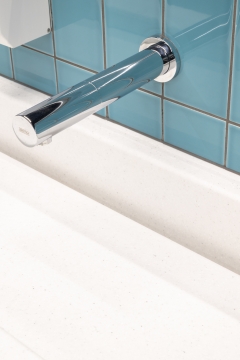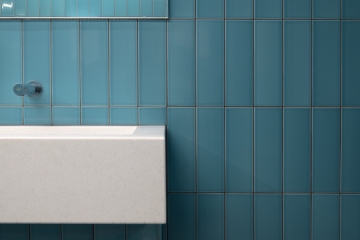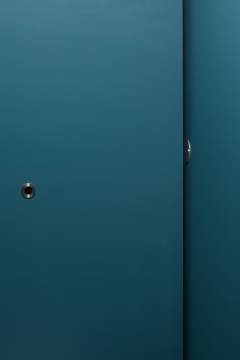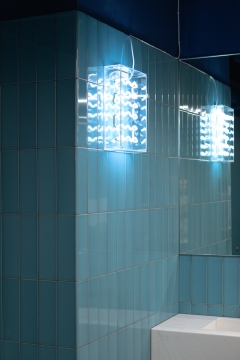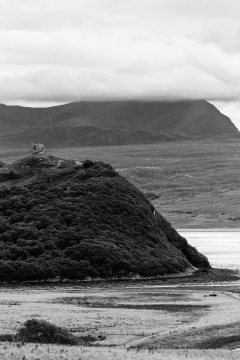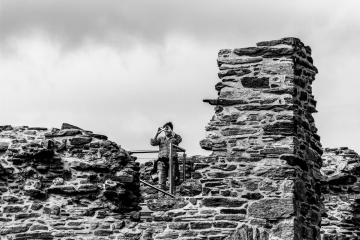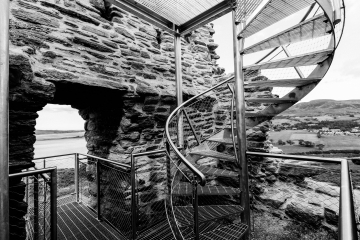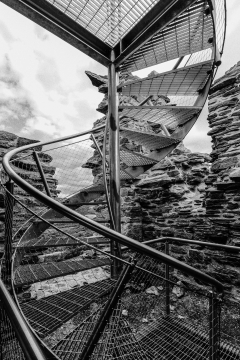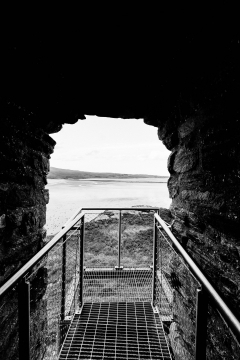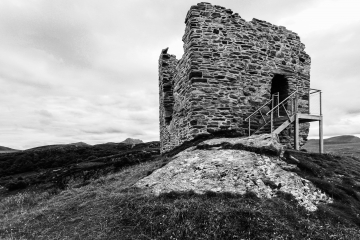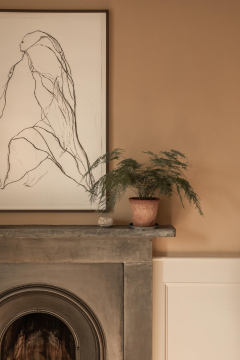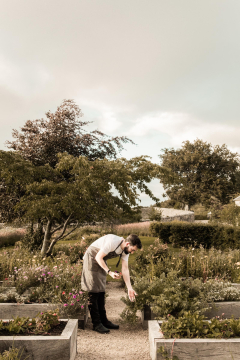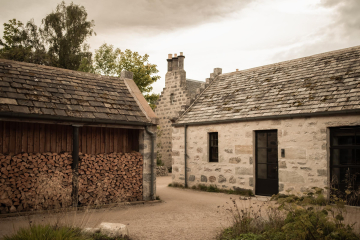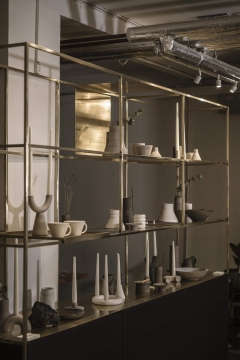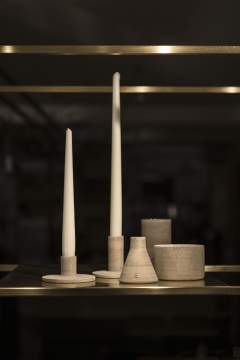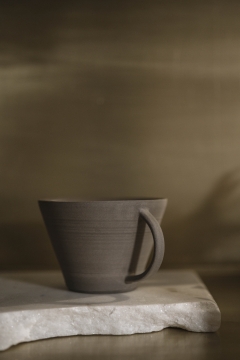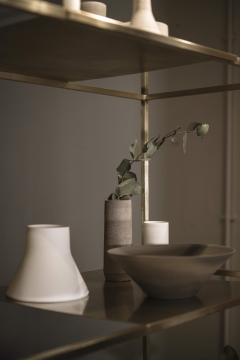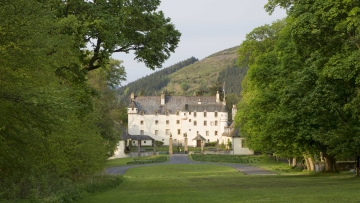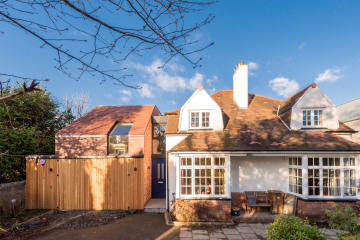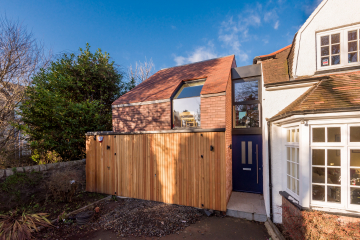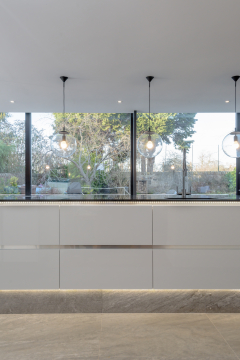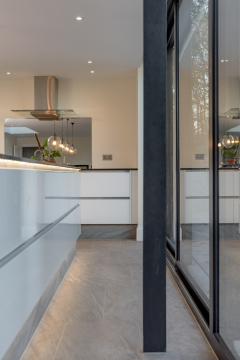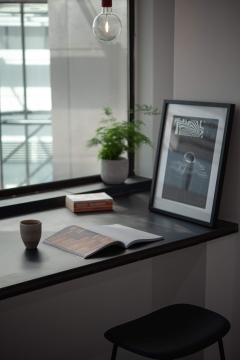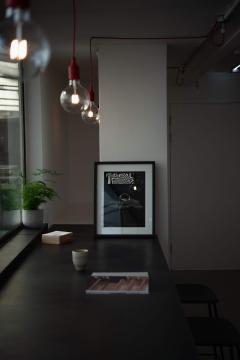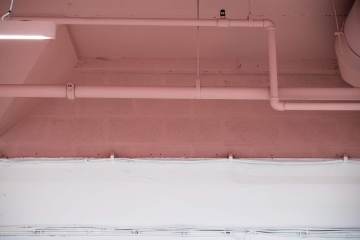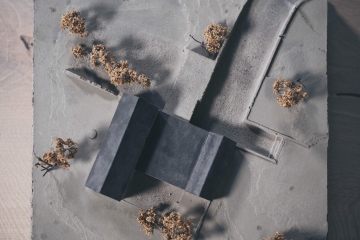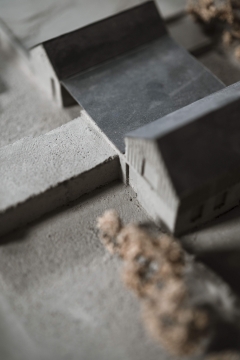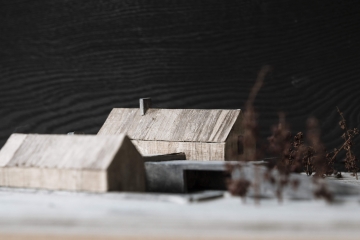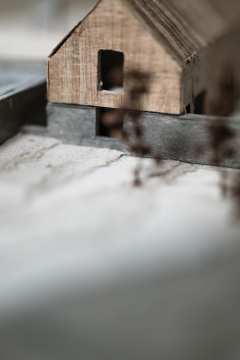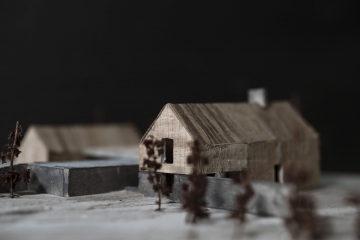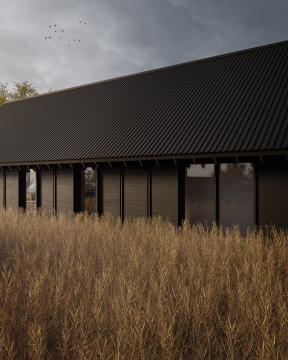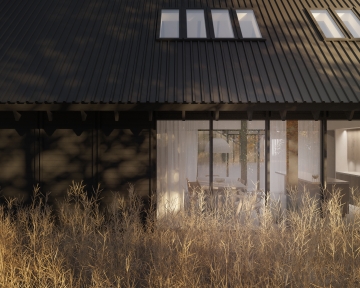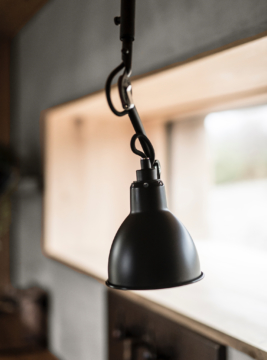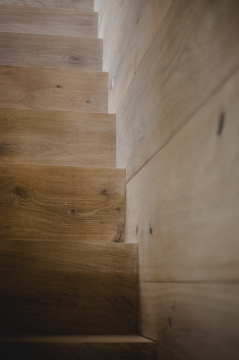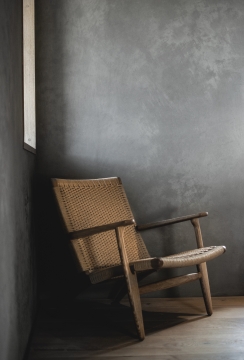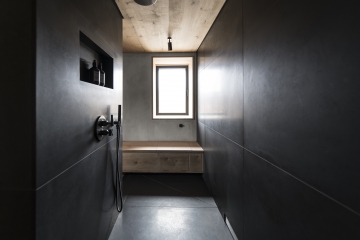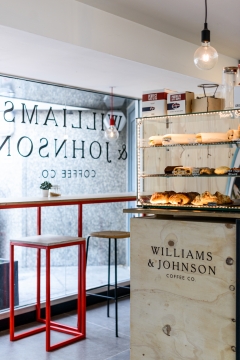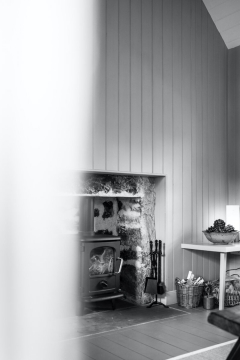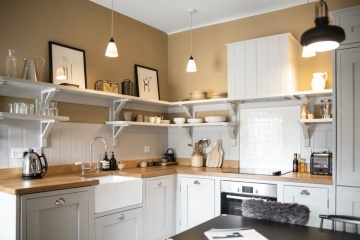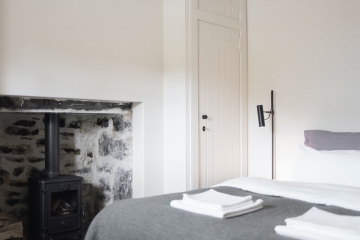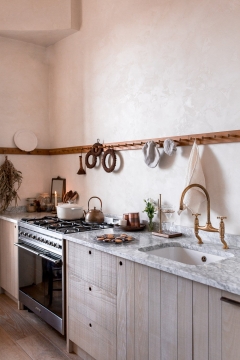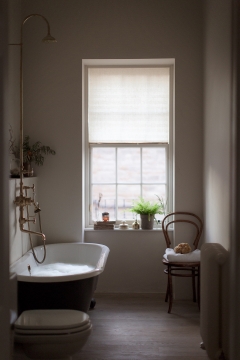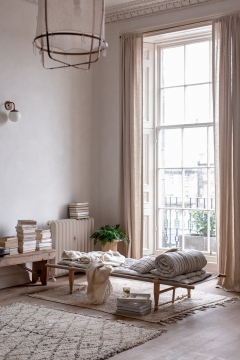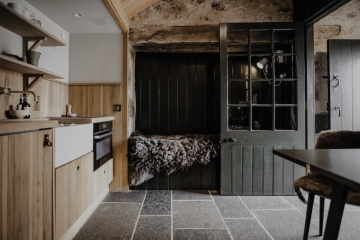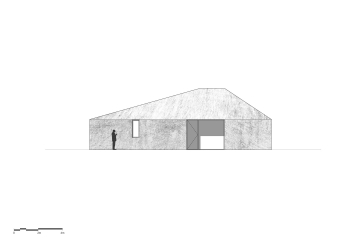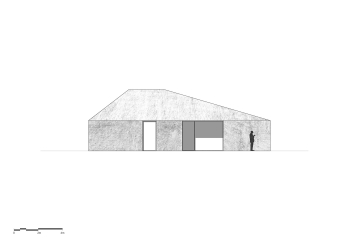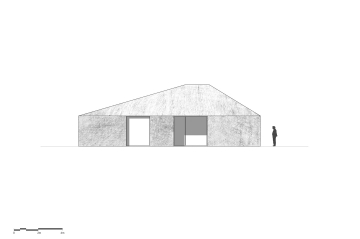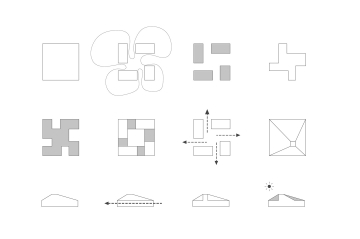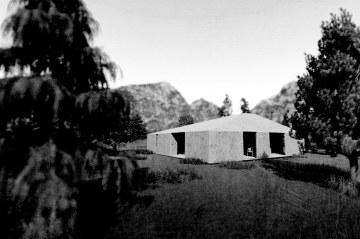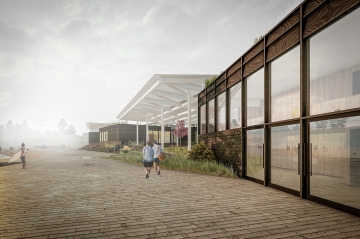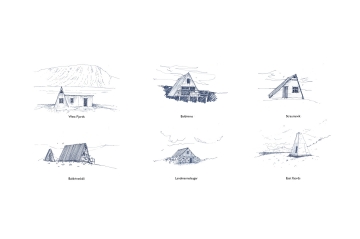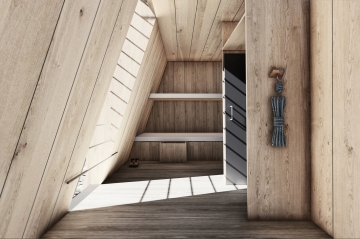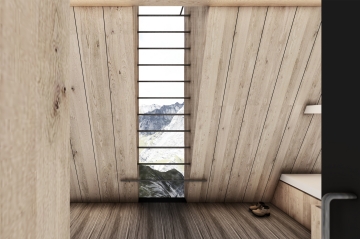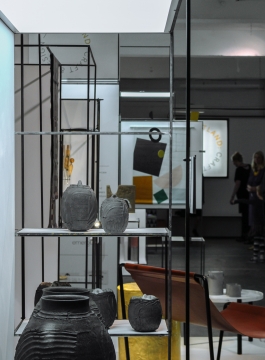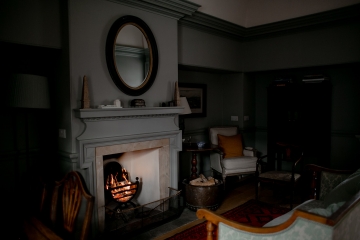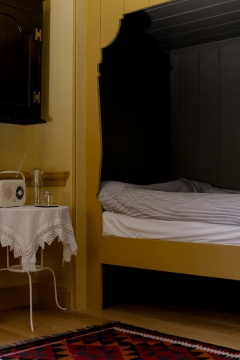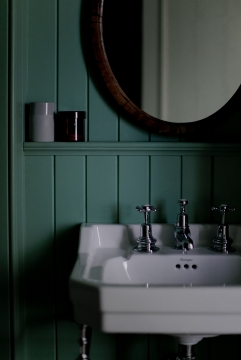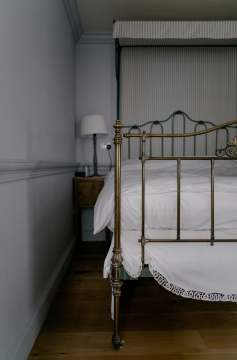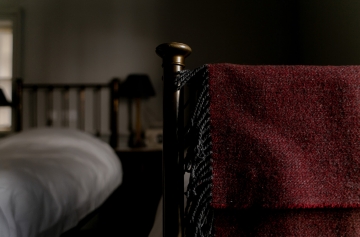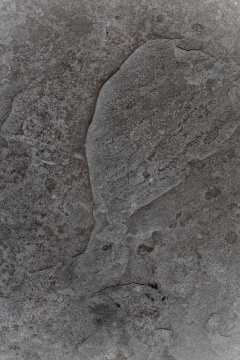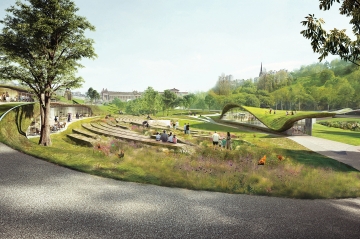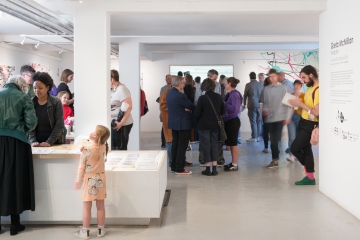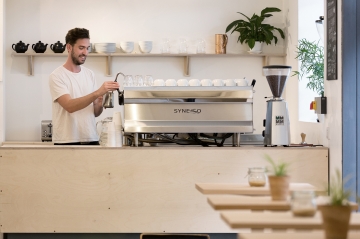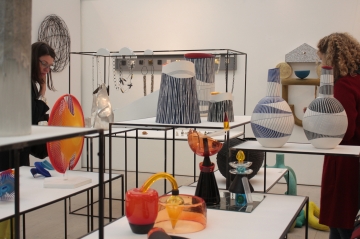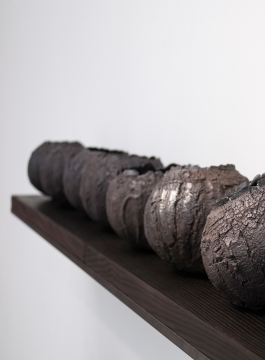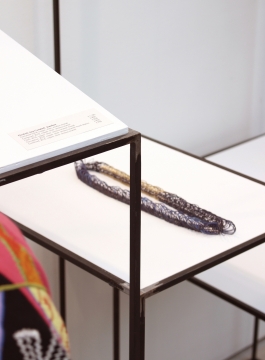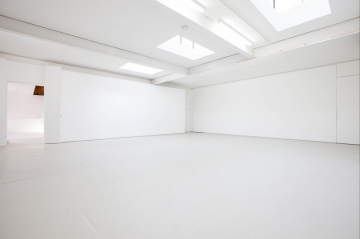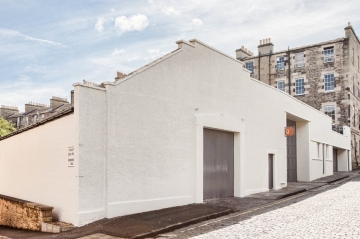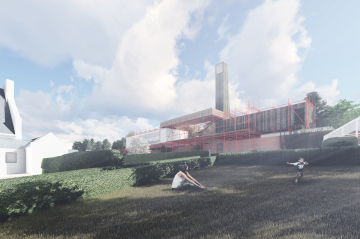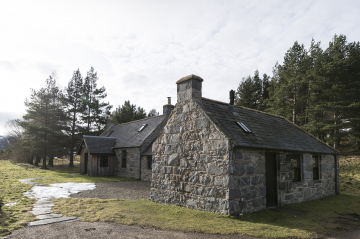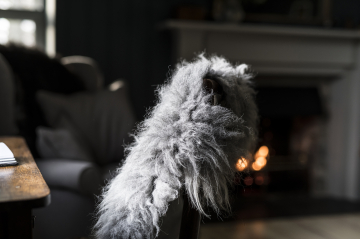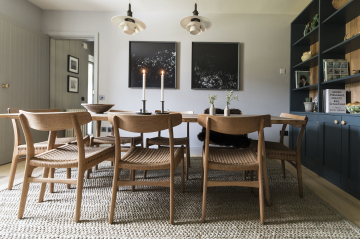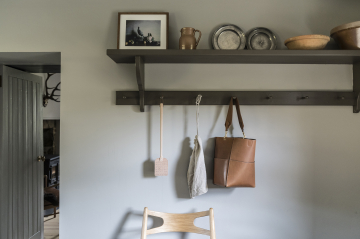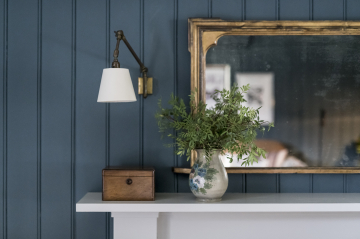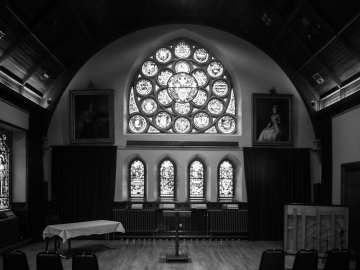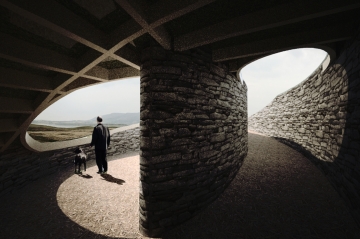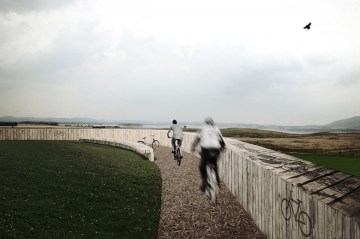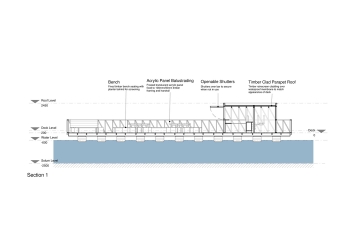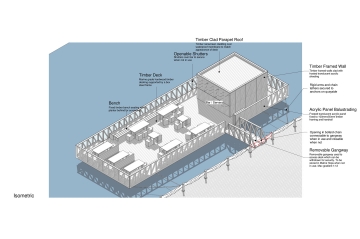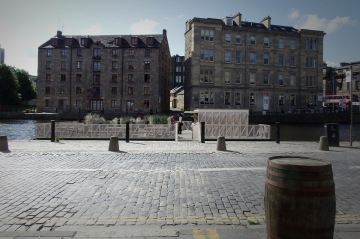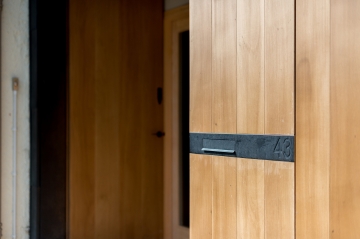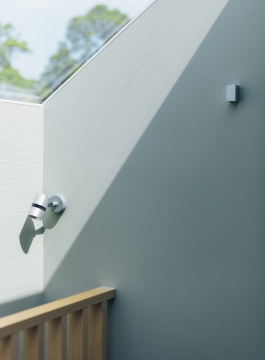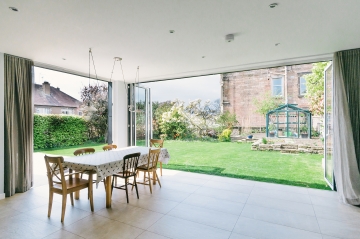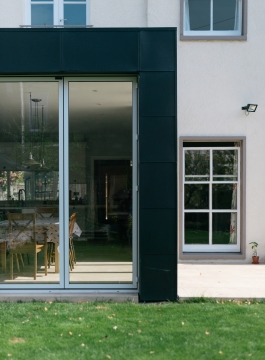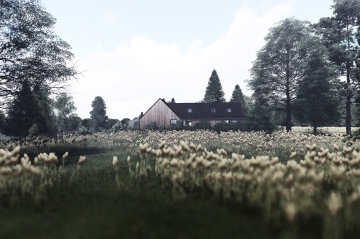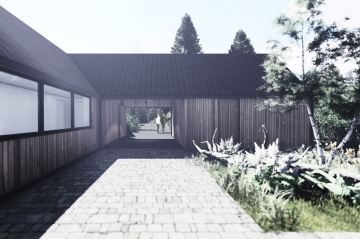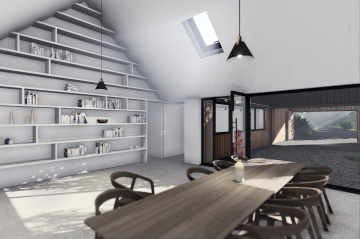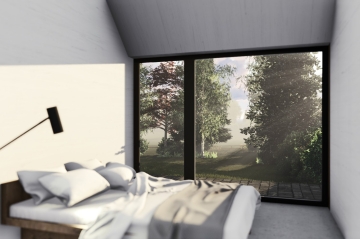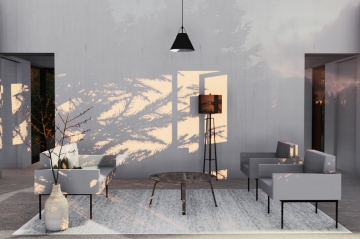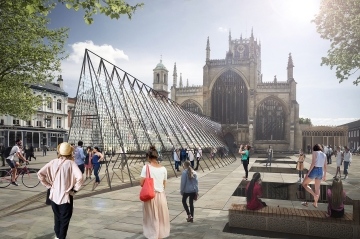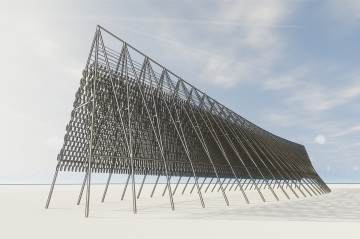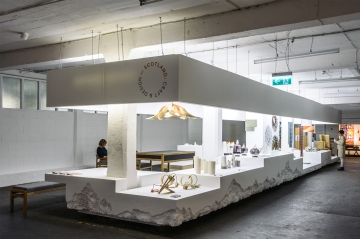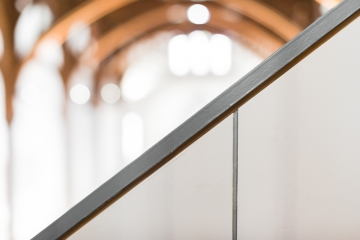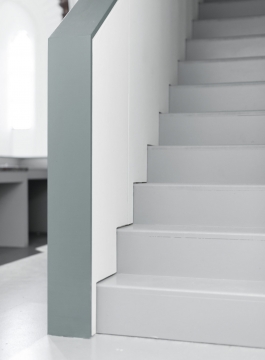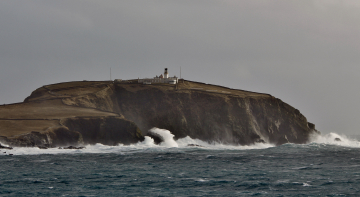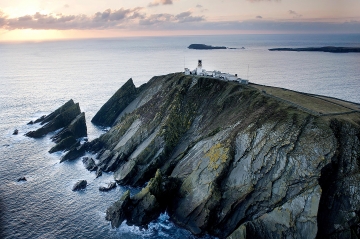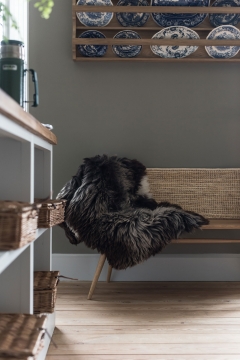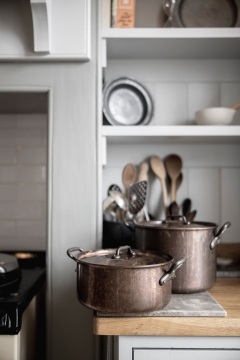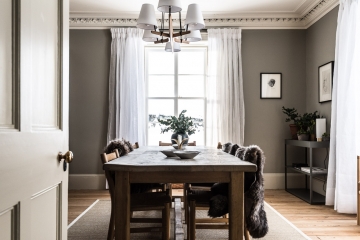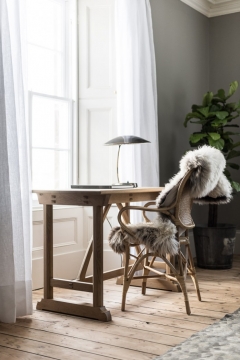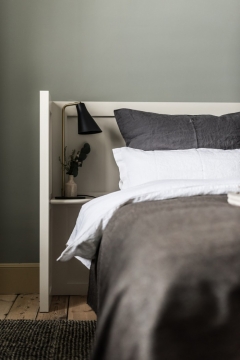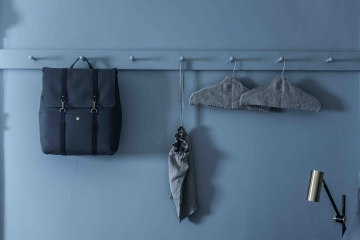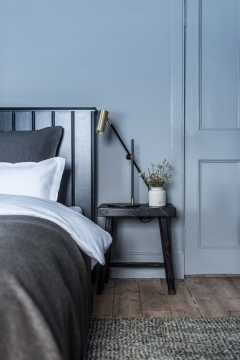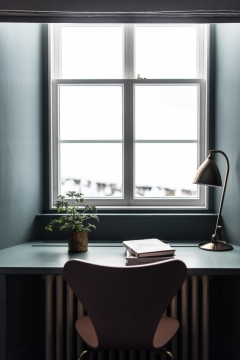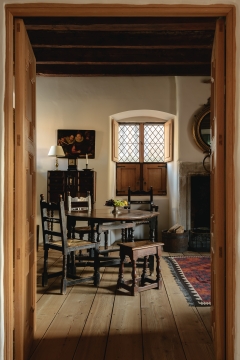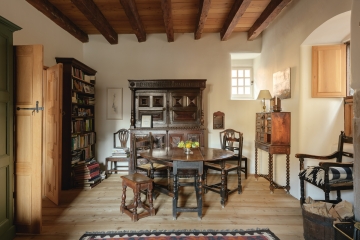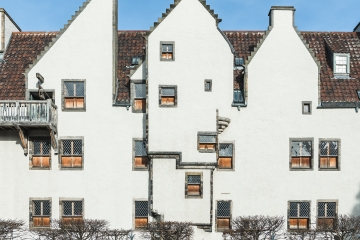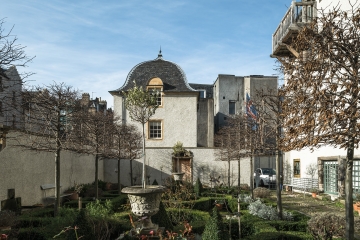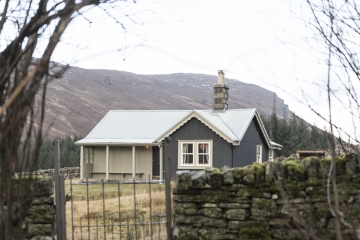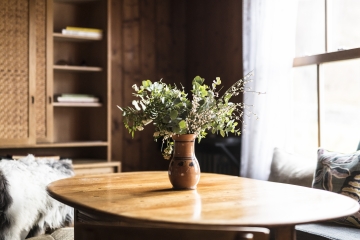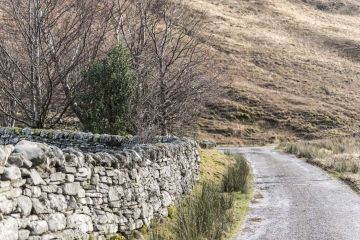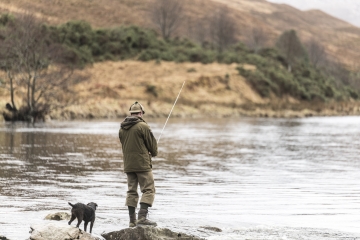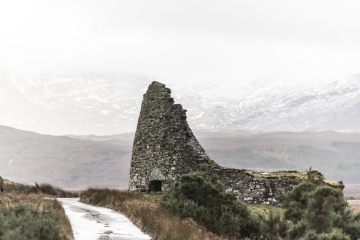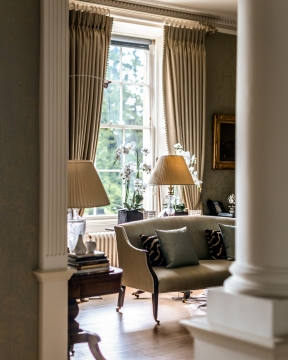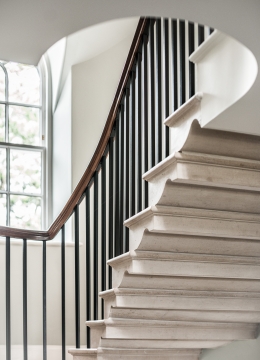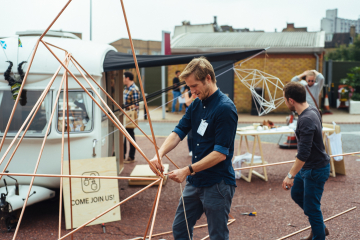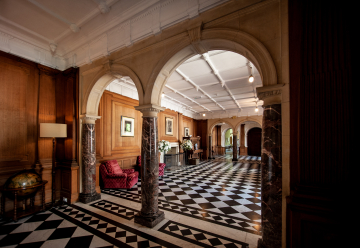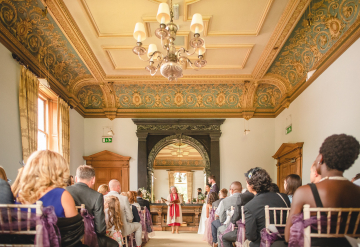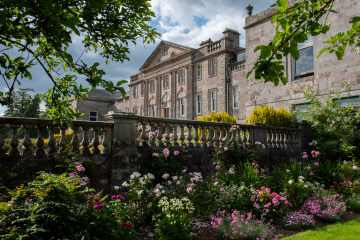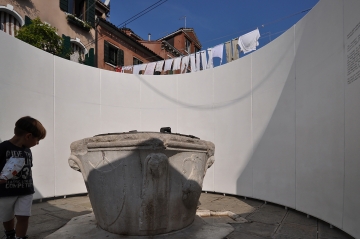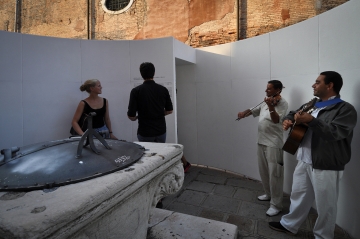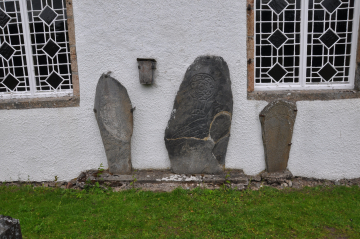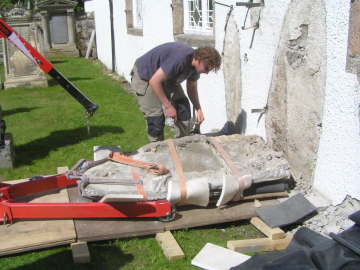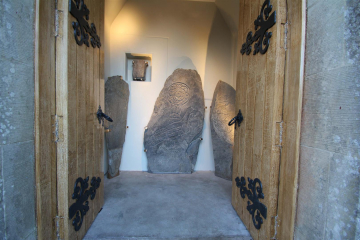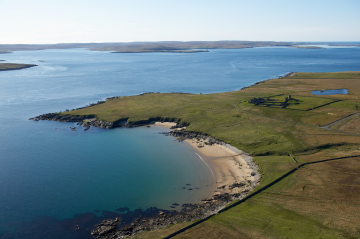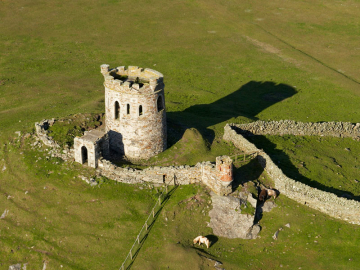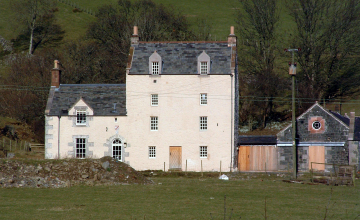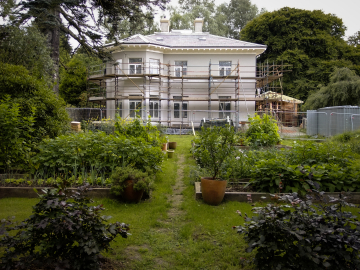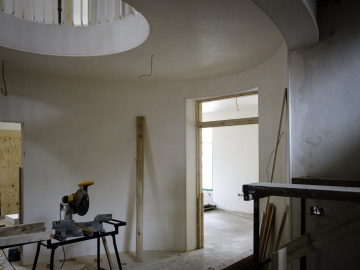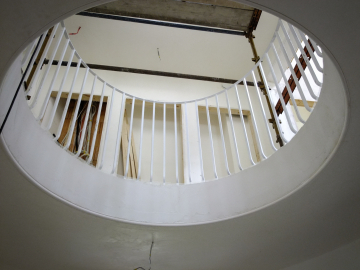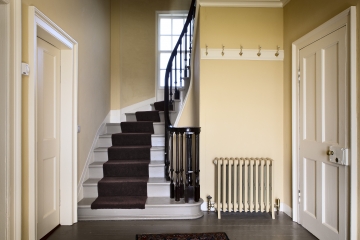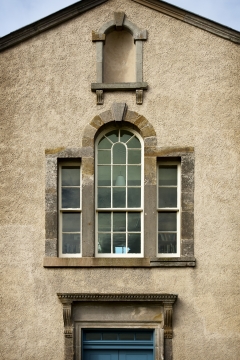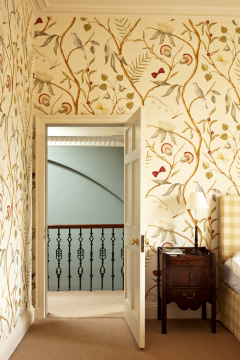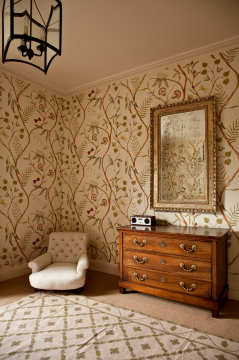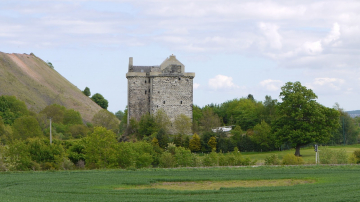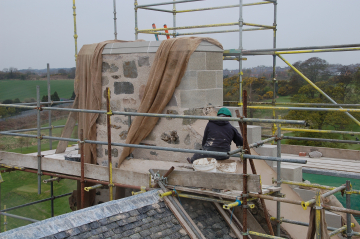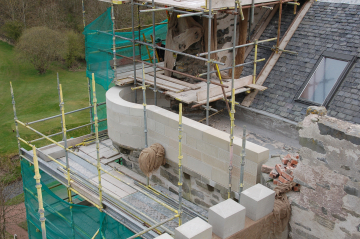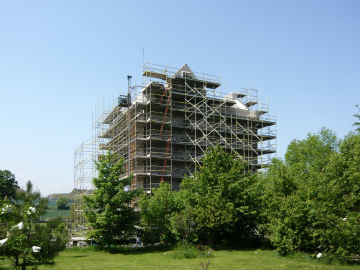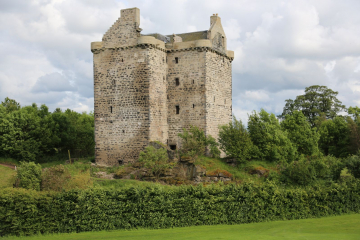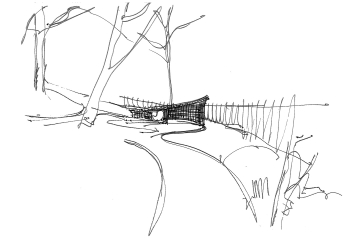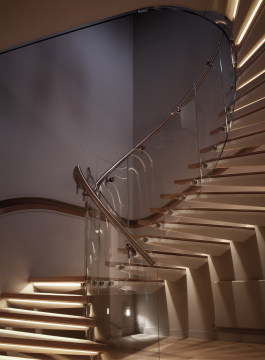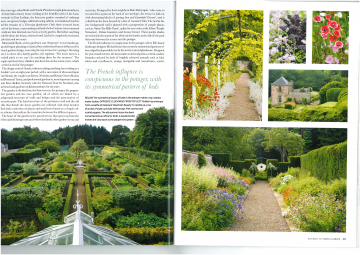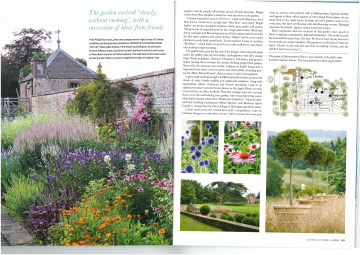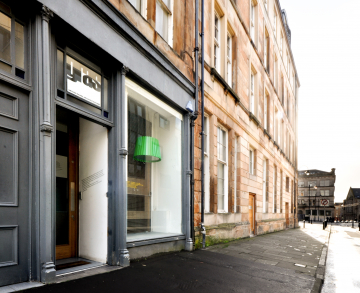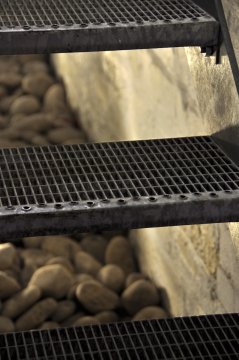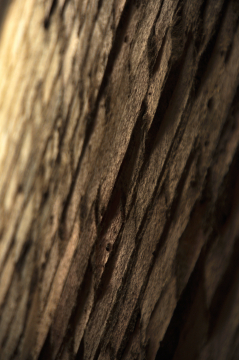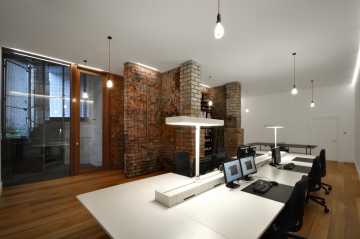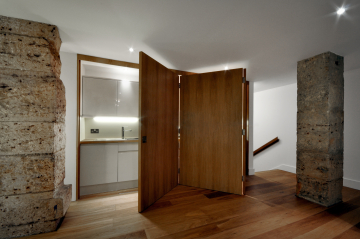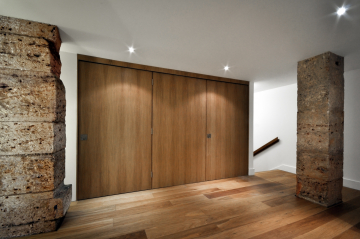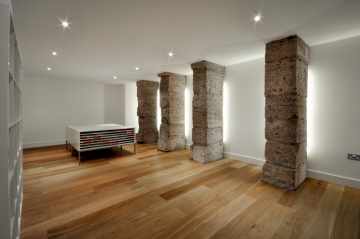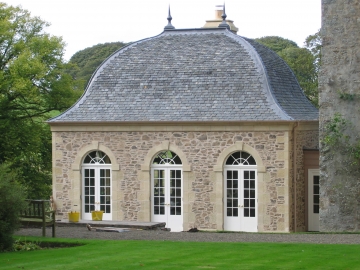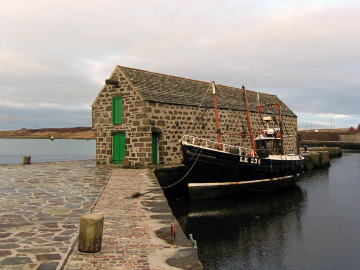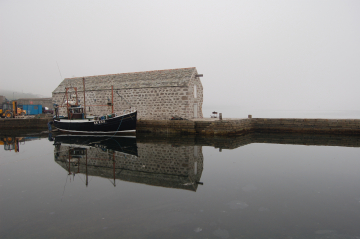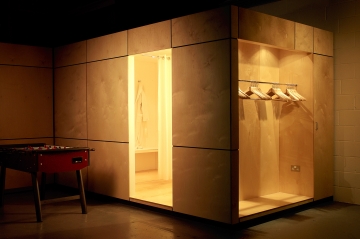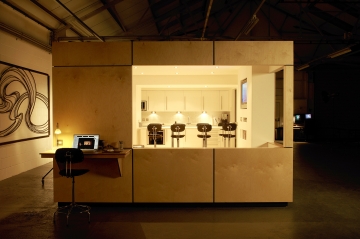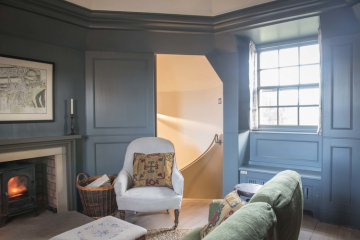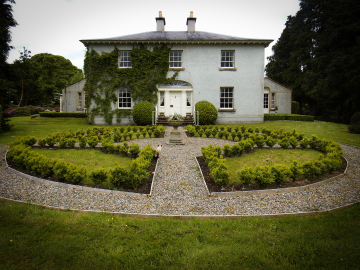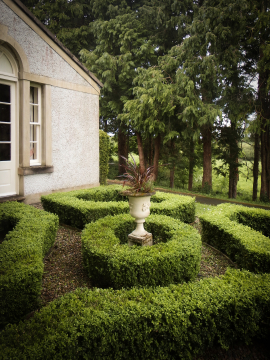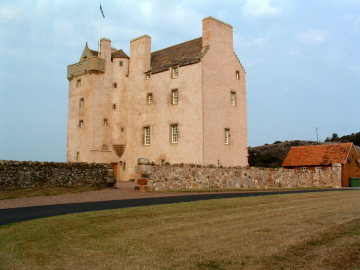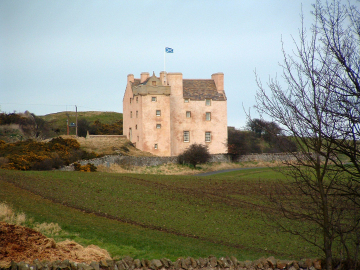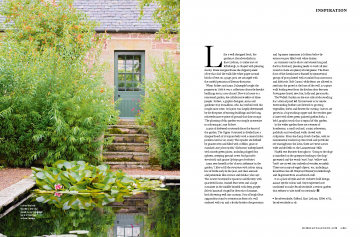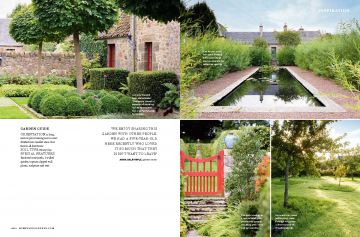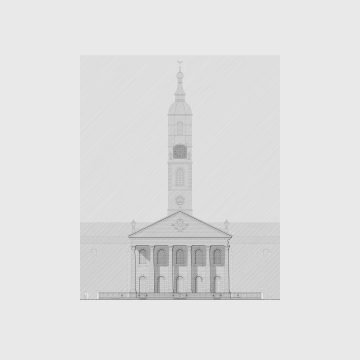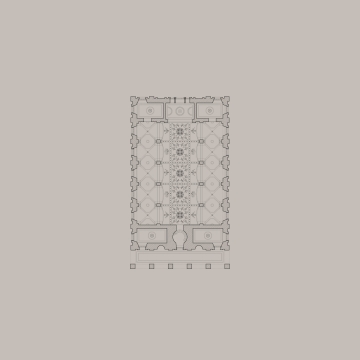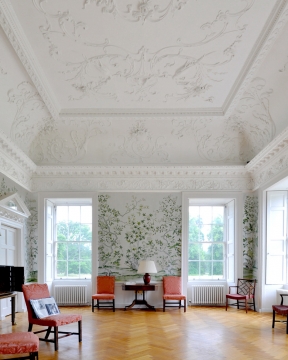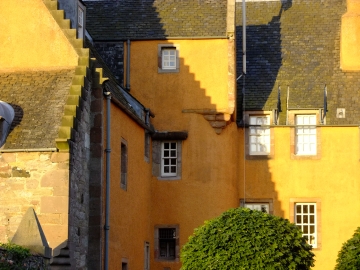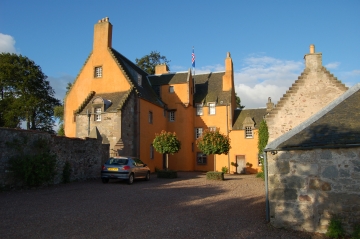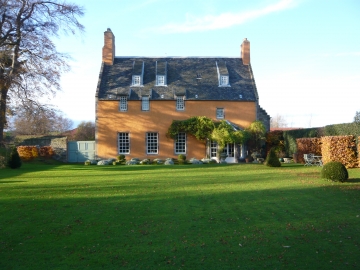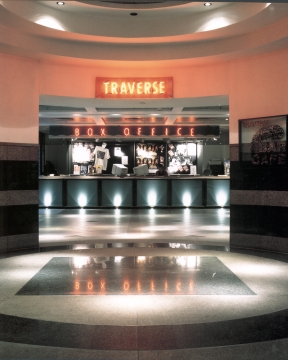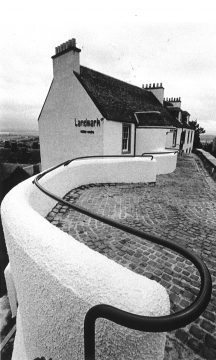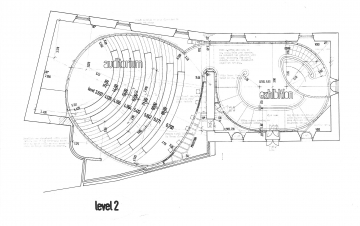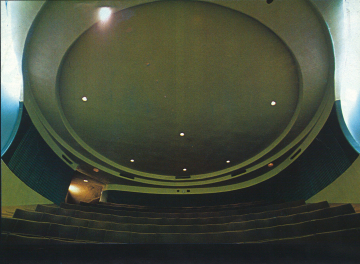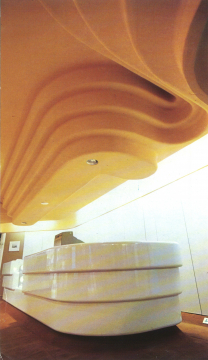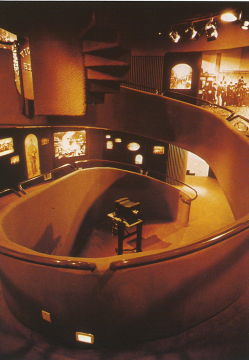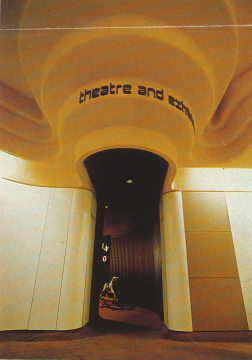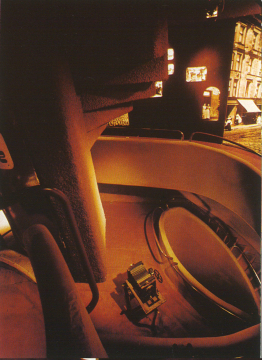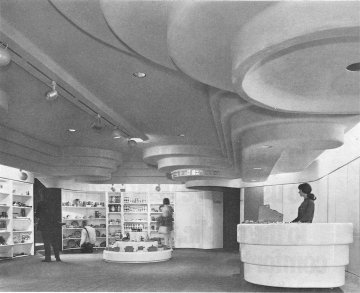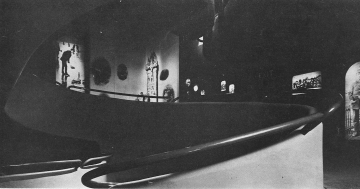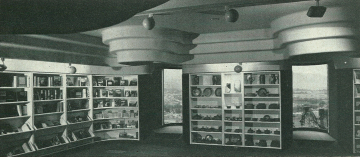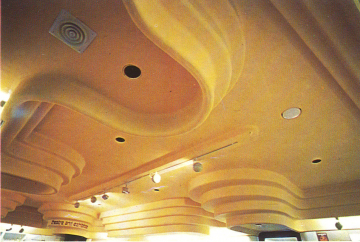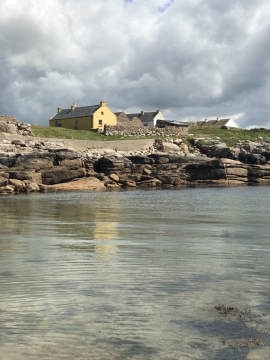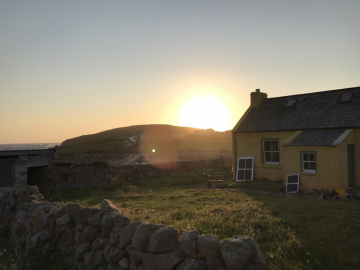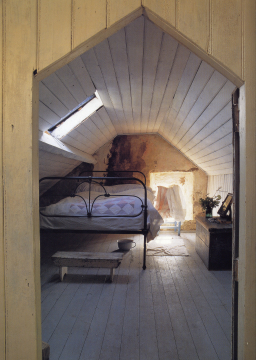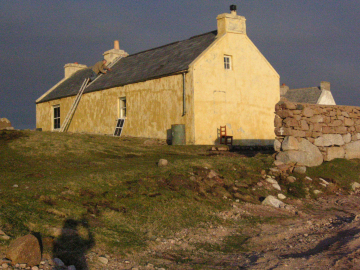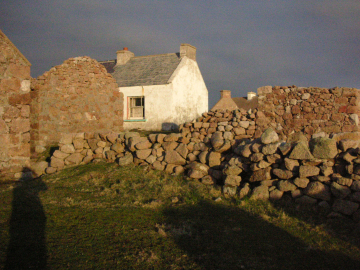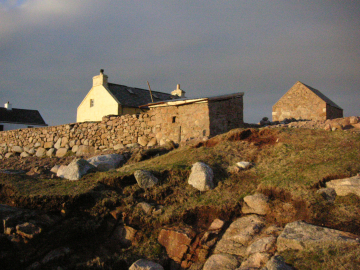GRAS worked closely with design-oriented clients in the heart of historic Gattonside on the River Tweed near Melrose. The project involved the careful refurbishment of a first-floor apartment, conversion of the attic, and reconfiguration of the living spaces. Throughout the process, the clients were actively involved and took on a key role in managing the project, ensuring their design vision was realised with precision.
The proposal introduced a new staircase to the attic, creating a spacious bedroom tucked neatly above the large living room, dining area, and kitchen. This bedroom features a generous walk-in wardrobe and storage, culminating in a bathroom. The design draws on an existing minimalist aesthetic, accented by industrial elements.
A thoughtfully curated material palette reflects the clients’ refined sense of style and commitment to minimising environmental impact. The interventions are realised in naturally finished larch and ash wood, subtly textured walls, and durable flooring. The project emphasised collaboration with local craftspeople and trades to ensure quality and attention to detail throughout.
The Tolbooth in West Wemyss is a rare example of Scotland’s civic architecture. Built in the early eighteenth century, and possibly incorporating earlier fabric, this two-storey building with its projecting clock tower has long held a civic presence on Main Street. One of only ninety tolbooths that remain across the country, this B-listed structure embodies the village’s status as a burgh of barony and its history as a centre of administration, trade and ceremony.
By the late twentieth century, unsympathetic repairs had accelerated the building’s decay. Cementitious harling and pointing, applied in a maritime context, had cracked and trapped moisture, leading to significant deterioration of the underlying stone. The first phase of conservation, led by GRAS in close collaboration with Graeme Brown Stonemason, set out to reverse this damage and secure the Tolbooth’s external fabric.
Scaffolding allowed for a close survey of the masonry, roof and tower. Cement harling was carefully stripped back to expose the underlying rubble and dressings, many of which showed laminations, erosion and previous failed repairs. Defective areas were indented or replaced with matching sandstone, informed by sampling from the Scottish Lime Centre Trust. Pinning, packing and comprehensive repointing were undertaken with lime mortars before the building was re-harled in a through-coloured lime render, reinstating a moisture-open breathable envelope. At the highest level of the tower, where the eaves course had delaminated beyond repair, new stone was cut and bedded to match the weathered originals, guided by structural input from Narro Associates.
Other repairs included the replacement of oversized copper roof panels, where star-cracking had occurred, with new sections of more appropriate scale; the installation of a new oak-studded entrance door made by traditional methods; and the repair of masonry and cobbled surfaces at the pend. The forestair was fitted with a new painted galvanised handrail in a period style to replace the badly corroded wrought iron.
The work was delivered through the combined expertise of Graeme Brown Stonemasons, Graciela Ainsworth Sculpture Conservation, Blake’s Roofing, Crown Traditional Craftsmen and Andrew Turner Blacksmiths, under the guidance of Morham & Brotchie as quantity surveyors. Every intervention was informed by detailed inspection, balancing the retention of historic fabric with carefully judged replacement where necessary.
The Wemyss 1952 Trust, long-term custodians of the Tolbooth, have played a central role in securing its future by committing to a phased programme of works. This first stage, though focused on largely unseen repair, represents an essential act of care and investment in continuity. By consolidating the external fabric, the project establishes the foundation for interior adaptation in the next phase, where historic features revealed during survey will be reinstated alongside a new residential use. In doing so, the Tolbooth is prepared not only for renewal but for a return of civic presence, reasserting its role as a landmark on Main Street and as a shared point of identity in village life.
The farmhouse was originally a three-bay farmhouse of three storeys constructed in the early 1700s. The property has been greatly altered and extended over the past 200 years. The western gable was repositioned in the 1700s (including at least one original stone skew-putt relocated), and in the 1800s an extension to the centre of the south elevation formed a new formal drawing room with bedrooms above. This transformed the plan from linear to T-shaped. The attic floor had fallen out of use and the stair to the attic was removed. An earlier single-storey extension to the north housed a dairy. This has two pan-tiled roofs (the main house is slated) and forms a distinctive elevation with rounded corners and a hipped pan-tiled roof, split to accommodate the main stair window.
The proposals included the removal of dilapidated lean-to outbuildings to the east; creation of a new stair to the attic to provide additional sleeping accommodation; re-organisation of the northern lean-to to include a larger rear entrance and coats area; relocation of the modern kitchen from the east wing to the centre of the house. Work beyond the house included the creation of a long new outbuilding along the east boundary to accommodate garden stores, ground source heating plant room and home offices, a new garage with gym and relocation of the main drive to enable reinstatement of the garden and improved access to the re-modelled north entrance.
GRAS is currently leading the sensitive refurbishment of a Category B listed Georgian residence in Edinburgh’s Stockbridge, reimagining domestic life through a lens of quiet purpose and measured elegance.
At the heart of the proposal is a study niche, discreetly embedded within a wall of bespoke joinery—designed as a space for stillness and focus, carefully calibrated to the pace and patterns of contemporary living. Created in close dialogue with our clients, the niche embodies a desire for an environment that is both introspective and architectural.
The material palette is restrained and textural: softened contours, layered finishes and moments of exposed hardwood lend warmth and tactility. Throughout the apartment, from reimagined bathrooms conceived as spa-like sanctuaries to flexible storage solutions shaped by modern routines, the project balances heritage sensitivity with personal utility, creating spaces that feel both grounded and quietly expressive.
GRAS was commissioned to undertake feasibility studies for retrofitting and extending this mid-century suburban home for a growing family with increasing spatial and environmental comfort requirements.
Whilst the project looked to make fabric and spatial improvements for energy, comfort and organisational reasons, it also used the opportunity to reconsider the existing building’s setting and, in particular, the flow of exterior to interior spaces, along with the figurative expression of the house through gable forms and eaves details.
The site consists of a late 15th century ruinous Tower House and a 17th century Doocot within a walled garden in Prestonpans. It is owned by the National Trust for Scotland but has been managed by East Lothian Council since 1972. Situated in a coastal area of a former mining town, the area has faced deprivation and a lack of investment over the years.
The project is publicly funded and the brief was developed in collaboration between the building owners, the management organisation and the community. The priority was to bring the structures into a good state of repair, improve public access to both buildings, and provide interpretation of the site in order to enhance the experience for current users, increase awareness of its significance and encourage more people to visit.
A light touch approach was important in order to maintain the character of the site and the proposals were distilled to concise architectural moves in order to make sense of the existing gardens and open up and improve the flow of the visitor experience, whilst protecting the future of the built fabric and landscape. Budget constraints and a conservation approach necessitated a very careful prioritising of works, including minimising maintenance.
This project is one chapter in the site’s history where a stabilised, revived and improved beloved heritage asset has been delivered back to its community, ready to be utilised to positively contribute to the common weal of the entire area. Rather than a comprehensive refurbishment, it is a collection of small precise interventions which together make a large impact.
Following the successful interior refurbishment of the buff concept store, GRAS embarked on a transformative journey with the clients, thoughtfully redecorating the office spaces within the A-listed former St Ninian’s Manse in Leith, Edinburgh. The client’s aim was to cultivate a serene oasis conducive to expanding the studio’s offerings towards contemplative well-being rituals. The project encompassed internal redecoration and bespoke furniture fabrication, drawing on GRAS’s fruitful collaboration with Edinburgh’s artisan, Daniel Brophy.
The chosen material palette for this understated intervention was neutral, tactile, and naturally derived. Marble paint was used for the lime-plastered internal stone walls, emphasising their elemental feel. Scottish Oak and Limestone were chosen the bespoke joinery, and powder-coated steel and painted timber for more conventional storage cabinetry. These choices seamlessly integrated with the historic fabric of the space, allowing GRAS to unearth and accentuate the lost domestic character of the former manse.
A series of vessels, designed by GRAS in collaboration with glass artist Edmond Byrne. Each piece is hand-blown, then while still hot, the form is baptised in cold water, shocking the mineral with a crackled texture. Asymmetry, light-play and textural depth define the vessels’ character, while subtly tapered shapes ensure functionality and stability.
The Glassblower’s Vessels are now available to purchase via thegatheringhand.com, with worldwide shipping or next-day collection from our studio at Custom Lane, Leith.
GRAS collaborated with Paper Foundation on a limited-run of handmade notebooks for the sister brand The Gathering Hand.
Paper Foundation is an arts and heritage organisation, based in the Lake District, specialising in the traditional production of fine handmade papers. Working closely with Paper-Maker, Tom Frith-Powell, we composed a quiet palette of natural papers that honour the traditional craft, which takes place across several distinct acts:
Natural cloth and rags of linen, hemp, cotton and abaca fibres are a local source of material for the paper-maker. Following this initial gathering, the rags undergo a series of shredding – first by hand and then by traditional Hollander beater. The fibres are slowly broken down into a fine pulp that is suspended in water to form a semi-homogenous mixture.
The milky liquid pulp is agitated and scooped up with porous moulds that allow it to settle in thin, fragile planes. Once pressed and dried, these planes mature into strong sheets of beautiful paper.
The cover stock presents a very simple traditional paper type: linen rag formed in the James Whatman style. The fine mesh of a Whatman “woven-mould” creates a more continuous, unbroken surface. Produced in a strong, 400gsm weight, this fresh paper is then pressed and dried between handwoven felts that wick away excess water and, in-turn, impart their mottled texture on to the fresh linen rag paper. When seen under raking light, the cover quietly tells its story.
Turning past the cover, the notebook’s inner-body is bookended by fine laid-paper, produced from abaca, cotton and hemp fibres. This fine paper compliments the linen rag stock softly and presents a paper-making-method that pre-dates the Whatman moulds. Laid paper is formed on a more sparse mould type, the “laid-mould”, that imprints its grid of wires onto the paper. Lifting the paper reveals this fine lattice of grid lines and, on occasion, the inclusion of watermarkings. The infinity mark, denoting papers of strength and longevity, is present on a handful of these books.
A small number of this edition is now available to purchase on The Gathering Hand website—thegatheringhand.com with free UK shipping, worldwide shipping, or next-day collection from Custom Lane.
Situated to the northern edge of the village of Tongue on the north coast of Scotland, the Burr’s of Tongue site lies on the North Coast 500 route. Our client, Wildland, approached GRAS to embark on a new approach to the development of the site. The first building we focussed on was Burr’s of Tongue General Store which had been previously ear-marked for demolition due to its poor condition and unsympathetic alterations.
The store had been lying vacant for years but was previously the heart of a business enterprise run by Peter Burr, which historically had served many communities in the north coast.
Our approach to sustainability (both environmental and social) was to retain as much of the existing fabric as possible through a careful conservation-led strategy to retain the building’s environmental, historical and community value. By embedding the site in its history, the project seeks to harness the strong collective memories that are very much still alive in the area.
The completion of the store marks the first phase in Wildland’s commitment to the regeneration of the site, with acknowledgement of the influence and community amenity that the Burr’s ecosystem provided to both the local and wider area.
GRAS was commissioned by a private client to prepare a full planning application for the conversion of two redundant barns at Gwendreath Farm, located in the rural, wooded landscape of Cornwall’s Lizard Peninsula, into a single residential dwelling. The barns sit within a mature setting, surrounded by dense shrubs and established trees on three sides, with a woodland valley extending northward down to Kennack Sands.
The two barns are distinct in character. The South Barn is a compact, two-storey structure constructed entirely of natural stone, while the larger North Barn is a single-storey, L-shaped building combining traditional stone and concrete blockwork. The design approach centres on a sensitive renovation that respects and enhances the existing setting, delivering the improvements required to transform the buildings into a contemporary family home that fulfils the client’s brief.
Careful attention is given to repairing and retaining original stonework, while new materials are selected for their natural qualities and agricultural aesthetic. This considered palette preserves the visual character of the barns and ensures the completed home sits harmoniously within its rural context.
GRAS was invited by Glenrothes Distillery to develop proposals for upgrading and refurbishing the on-site offices, welfare facilities, and sample room. Located in Speyside, northern Scotland, the distillery comprises a series of warehouse buildings set within an undulating landscape, which includes the water source essential to whisky production. The original distillery was established on the site of an old mill in Rothes in 1878.
The proposals focus on elevating the distillery’s functional spaces through the careful selection of high-quality materials, embodying a sense of discerning luxury. The design approach balances innate flair and considered elegance with a deep respect for the site’s authentic and grounded character. This subtle yet confident intervention aims to enhance the everyday experience of the distillery’s staff and visitors, maintaining the integrity of a heritage site while offering renewed vitality and refinement.
GRAS is leading a design team on behalf of the National Trust for Scotland, to develop an understanding of the Category A-listed Malleny House. Work is now underway to record the historic fabric, condition survey and inform planned fabric repairs to secure the future of the building. A team including AOC Archaeology have recently undertaken a LiDAR survey of the property both internally and externally from which a 3D model and high-resolution scaled orthographic images and elevational drawings will be produced.
The site has been Listed at Category A since 1971. The property is now surrounded by an area of housing, designated as Balerno Conservation Area. There are also the A-listed Doocot and C-listed Scott Burial Vault nearby. The earliest documentary evidence of Malleny estate is from around the 1280s. Malleny House was built around 1637 by the then owner Sir James Murray of Kilbaberton, Master of the King’s Works. Elements of an earlier house may have been incorporated into the fabric, which are thought to include the date stone of 1589, located in the kitchen of the present house . The Georgian Wing to the North was added around the 1820s. The date of the Southern range is assumed to be mid-19th Century. It is hoped the project will reveal more about this detail.
GRAS combined Scottish ash, concrete, and stainless steel to create the restrained and tactile interior of buff, a design-led manicure studio in Edinburgh. Sustainably sourced timber was layered with contemporary materials, transforming the Victorian stone-arched space into a refined and evocative environment. Custom-designed joinery pieces were carefully integrated to craft a harmonious interior that reflects the studio’s ethos and embodies a functional simplicity.
In light of ash dieback disease caused by the fungus Hymenoscyphus fraxineus, which is projected to affect up to 75 percent of Scottish ash, the project provided an opportunity to engage thoughtfully with the ecological and ethical considerations of material selection. The sourcing and fabrication of the joinery was the result of a close collaboration with Edinburgh-based designer and maker Daniel Brophy, reinforcing a commitment to responsible craftsmanship.
The design balances material integrity and sensory experience, offering a quietly confident space that resonates with clients and visitors alike.
GRAS collaborated with the Friends of Water of Leith Basin to deliver a new mural celebrating the life and work of Eduardo Paolozzi, the internationally renowned Scottish artist born in Leith in 1924. The original mural, installed in 2014 on the frontage of a vacant shop at 73 Henderson Street, had deteriorated beyond repair.
The new mural presents Paolozzi as an older man, set against a backdrop of familiar Leith landmarks rendered in a vibrant Pop Art style inspired by his own work. Created by artist Halla Groves-Raines, the mural was produced using durable marine-grade plywood and stainless steel fixings, ensuring longevity in the face of Edinburgh’s weather.
The project involved the careful removal of the existing mural and support structure, followed by the construction of a new subframe and the installation of the printed and mounted artwork using advanced scanning and fabrication techniques consistent with the original method.
Unveiled to the local community, the mural stands as a confident, contemporary homage that enriches the cultural fabric of Leith and continues to honour Paolozzi’s legacy in his hometown.
Competition proposal for the new municipal library building in Česká Lípa, Czechia. The ultimate function of a library is in question. More and more it is a place to connect with each other, transforming itself into a new social platform with knowledge in its centre. The proposal seeks to write a story about the place and its two historical structures co-occupying the site. One of the last fragments of the fortification wall left in the city runs through the site forming the main entry to the new library. The proposed building complements the existing architecture and tries to create a unified whole with it. Both in proportion and scale, and in the morphology used. The design works with rhythmically repeating symmetrical gable roofs and the massive mass of the buildings. Behind this heavy skin opens a new world filled with light from above and carefully framed views back towards the town showing it from new perspectives.
Located just south of the iconic Kyle of Tongue on Scotland’s north coast, Kinloch Lodge is a Victorian sporting lodge reimagined for the 21st century. What was a rather spartan and tired holiday home has been transformed into a luxurious oasis over several phases of work in conjunction with Wildland’s creative director, Ruth Kramer. The main house has been carefully repaired and upgraded inside using warm tones and natural materials, enhanced by the addition of a new conservatory to link the house and beautifully replanted gardens in all seasons. The kitchens have also received a full rethink, creating practical but beautiful workspaces befitting the carefully selected Scottish ingredients used to prepared the curated guest meals.
Outside, landscaping by Richard Preston Garden Design softly connects the main house with the collection of corrugated-iron clad outbuildings; each of which has been repaired and then reconfigured internally. While the smaller buildings contain necessary back-of-house facilities, including all new heating and power equipment, the larger Annex provides indoor space to play with room for film nights, yoga, as well as spa treatments.
This modest development offers compact living accommodation for two people within the grounds of a rural cottage in East Lothian. It evolves from an existing single-pitched rubble-stone and clay tile outhouse, expanding into three intersecting volumes crafted from reclaimed materials. These volumes step, twist, and shift in response to the natural topography, optimizing daylight and framing views.
The resulting form is rooted in its place yet possesses a timeless quality. Internally, the spatial proportions and arrangement provide just enough room for comfortable living and working, maintaining constant visual connection with the surrounding rural landscape of cliffs, river, forest, and fields.
A restrained material palette of concrete, oak, lime plaster, black steel, soft leather, and glass defines the interiors, enhancing the tactile and sensory experience while reflecting the simplicity and calmness of the setting.
GRAS was commissioned by Dumfries Historic Buildings Trust to prepare a conservation statement and feasibility study for Rosefield Mills, a Category B-listed nineteenth-century former tweed mill prominently located near Dumfries town centre. The building features a grand Venetian palazzo-style façade overlooking the banks of the River Nith but has remained empty and unused for many years.
Building upon previous studies and reports, GRAS’s work focuses on exploring viable options for repair and adaptive reuse that prioritise the conservation and retention of the existing fabric. Initial draft proposals have been prepared and issued for review and comment. These documents assess the building’s significance, identify the challenges it faces, and outline a concept for re-use based on a ‘festival tent’ approach—a large, open, and flexible space designed to accommodate a variety of community, cultural, retail, and commercial activities.
Photography by Martin Kerr and Natasha Huq.
This Georgian maisonette in Fitzrovia had suffered from a series of unsympathetic interventions, leaving the interior fragmented and disconnected from its architectural origins. GRAS was appointed to develop a design that would gently bring back the character while responding to the specific needs of a growing family. Informed by close research into Georgian and Regency domestic interiors, and shaped through an ongoing dialogue with our clients, the approach balances authenticity with comfort and use.
On the main floor, the drawing room was reimagined as the heart of the home. Original proportions were reinforced through the introduction of ordered mouldings and period detailing, designed to support the existing fabric without resorting to replication. The adjoining kitchen, compact but robust, was conceived as a working “mother’s kitchen”, with bespoke joinery accommodating modern appliances and layered domestic activity. Upstairs, the existing layout was reconfigured to include a shower room and two bedrooms. New timber panelling brings warmth and rhythm to these spaces, concealing storage and allowing the plan to breathe within its original constraints.
The project demonstrates how careful conservation and contemporary living can work in tandem. Through research-led design and restraint in detail, a once-altered interior finds a renewed sense of order, purpose and belonging.
Brough Lodge Trust worked with GRAS to develop a feasibility study for the creation of a retreat at Brough Lodge, a Grade A listed complex, of national importance, on Fetlar in the Shetland Islands.
The proposal seeks to create an event space within the exiting Lodge, along with new build bedroom wings for up to 50 guests. A look-out restaurant offers panoramic views of Fetlar and the surrounding islands, along with the historic folly tower which caps an iron-age Broch from which the Lodge got it’s name.
GRAS developed the proposals in close consultation with Historic Environment Scotland and The Shetland Amenity Trust to maintain the unique character and setting of the lodge, while securing a future of this historically and architecturally important complex.
GRAS completed accessibility improvements to the East Kirk of St Nicholas in Aberdeen on behalf of the Open Space Trust. This £350,000 project involved the construction of a wheelchair ramp and the provision of an accessible WC and kitchen within the Chapel of St Mary. The chapel, a late-medieval structure, forms the undercroft of the larger church, which was substantially rebuilt in the nineteenth century. These works represent an important step towards improving public access to the chapel while plans for a broader transformation of the East Kirk are developed.
During London Design Festival 2022 at Blue Mountain School, GRAS presented The Gathering Hand, the first collection of furniture and objects created in collaboration with leading European makers. Three product typologies emerge from tactile and evocative materials, shaped through a combination of traditional and contemporary techniques including bespoke joinery, mouth-blown glass and bead-blasted stone.
The processes celebrate the artisanal skills of our collaborators: Studio Corkinho, Namon Gaston and Edmond Byrne. The result is a series of sensory, functional tables, vessels and objects.
The pieces are available to purchase via thegatheringhand.com, with worldwide shipping or next-day collection from our studio at Custom Lane in Leith.
GRAS collaborated with artist Juli Bolaños-Durman on a commission for the Royal Edinburgh Hospital on temporary loan to the Scottish Parliament. The light boxes were designed to invite all audiences to come up close and indulge in the details of the glass sculptures and its shadows.
The material palette for the cabinets is simple – whitewashed oak veneered timber with brass detailing. The objective was to frame the glass installation and provide protected environment for the fragile pieces that could be observed from different angles, even with wheelchair accessibility in mind. Read more about the project via Juli Bolaños-Durman’s website.
A series of three tables merging scorched cork with beautifully crafted oak. The two materials—siblings of the Quercus plant family—come together in a balanced expression of tactility, nature, durability and tradition. Made together with Studio Corkinho, each cork tabletop is fired prior to pressing to bring out an earthy brown base. The surface then undergoes a heat-treating process, applied by hand, which intensifies the tone and texture. Finally, a matte bio-varnish is applied for protection. The cork’s depth and subtle complexity emerges as light passes across its surface.
The oak bases are constructed with housed tenon joints, beautifully executed by skilful carpenter. The oak is smoked for 24 hours before hand-assembly and final oiling.
The The Carpenter’s Tables are made to order. To enquire email info@thegatheringhand.com
The Gathering Hand is derived from GRAS’s five decades of passionate, hands-on creation, historically in the fields of conservation, architecture and interiors and from the practice interest in interdisciplinary design. Through The Gathering Hand, GRAS celebrates the innate human drive to make.
A family of objects expressed in elemental forms—cylinders, disks, hemispherical cuts—as an ode to the simple stone slab. The edges of the Portland stone are delicately softened by the bead-blasting processes and in turn the material’s surface expression is highlighted. A considered shadow gap under the Vase and Bowl elevates the volumes ever so slightly. The continual, hemispherical slice of the Bowl creates a gentle concave cradle for fruit or mementos; its bare surface mingles beautifully with passing light. The paired cylindrical Weights hold a level of ambiguity, their usefulness spanning limitless occasions.
GRAS debuted The Gathering Hand collection with an exhibition at Blue Mountain School during London Design Festival 2022. The Carpenter’s Tables and the Stonemason’s objects are made-to-order. For sales or exhibition enquires please contact info@thegatheringhand.com The Objects are now available to purchase via thegatheringhand.com, with worldwide shipping or next-day collection from our studio at Custom Lane, Leith.
GRAS has been appointed to sensitively upgrade, repair, and extend the village hall in East Lothian. The project aims to create a modern community hub that unlocks the building’s potential and welcomes a broader range of users. Partial funding has been secured from Fred Olsen Crystal Rig Wind Farm, and preparations for on-site work are underway.
The Literature House is the flagship project of the Edinburgh UNESCO City of Literature Trust. It seeks to unite two iconic Edinburgh buildings, John Knox House and the Scottish Storytelling Centre, to create a welcoming hub celebrating Edinburgh as a literary city and Scotland as a literary nation. The Literature House aims to be a vibrant place of encounter, offering event spaces, interpretive experiences, a café and meeting place, bookshop, and information centre.
The proposals require a sensitively crafted approach to address the complexity of the site and buildings, alongside a highly aspirational brief. Witherford Watson Mann and GRAS have collaborated closely on a feasibility study, developing a scheme to improve accessibility, enhance the flow between the two buildings, and upgrade their fabric and services. While the project currently awaits the next phase of development, the groundwork laid continues to inform future progress toward realising this exciting vision.
The existing two-bedroom dwelling on King Edward’s Road in London was extended to create a larger living area and incorporate an additional master bedroom. The design transformed what had been a dark and compartmentalised property into a bright, open, and spacious family home.
A carefully considered material palette was selected to enhance the sense of light and warmth throughout the space. Subtly textured plaster walls provide a soft backdrop, complemented by white oiled Douglas fir joinery that introduces natural warmth. Pale brickwork adds tactile interest, while accent features in warm dark wood, chrome, and matt black metal bring depth and contrast to the interiors.
The overall effect is a balanced and cohesive design that supports contemporary family living while respecting the character of the existing structure. Photography by Sustainable Kitchens captures the refined detailing and atmosphere of the completed home.
GRAS worked with Bostock Bakery to reconfigure their East Linton base, creating a new wood-fired pizza area and café seating. The design employed a simple palette of oak and reeded glass to form seating booths and tables, finished with understated upholstery. The circular Bostock logo was reimagined as dowel details incorporated into the seats and tabletops, while triangular wall panels referenced the cuts made in pastry when shaping croissants.
GRAS collaborated with S+CO to explore innovative design solutions for social spaces in response to the pandemic. The project features a thoughtfully selected palette of materials including blackened steel, plywood, brass, and oak. Polycarbonate screens were designed and fabricated in Leith, Edinburgh, and have been carefully installed at multiple locations across the UK to enhance safety while maintaining aesthetic quality.
The Log Store and Cart Shed project are two buildings for a highly regarded interior designer client based in Yorkshire. The Log Store contains storage at ground floor and a large home office at the upper level, which the client will use as his base when in Yorkshire. The Cart shed includes covered parking and storage at ground floor with flexible use space and guest accommodation at first floor.
GRAS worked closely with the client to develop a refined design that takes reference from the Yorkshire Sided timber barns and stone Field Barns which characterise this part of the Yorkshire Dales. The project forms part of a larger master plan for the estate which will see the building of a new farm house and steading alongside the conversion of an agricultural shed in to art gallery and workshop spaces.
The proposed family dwelling is located in Uig, a small village at Timsgarry on the Isle of Lewis. The house sits on an exposed site with immersive coastal views towards the southwest. The massing of the development is divided into three volumes containing the house, annex accommodation and garage which helps to break up the overall scale. The staggered arrangement of these elements references the asymmetric plans that are typical in the area, while the inclusion of prominent chimney stacks also evokes the local vernacular.
The building’s orientation on the site takes into consideration the views, sun path and prevailing winds. The main spaces are oriented to take the full advantage of the main southwest panoramic view and to allow morning and evening sunlight to enter. The main entrances to the house and annex on the north facades are protected from the southeast prevailing winds.
The material palette for the property responds directly to the built heritage of the immediate surroundings, whilst also aiming to provide a modern take on the farmhouse dwelling. The proposed cladding is a mixture of textured, painted wet-dash render on the lower part of the facades, with lighter timber above. The materials are distributed across the development to create a sense of scale more characteristic of the area. The pitched roofs of all three volumes are covered with corrugated metal sheets reminiscent of typical agricultural buildings.
The Lake House is a bespoke family home located on the Finger Lakes in upstate New York. The client engaged GRAS to design a residence capable of accommodating both a parent couple and their extended family, including children and grandchildren.
GRAS approached this challenge as a typological exploration of the evolving North American home, with particular attention to the suburban model. The design navigates the complex brief of creating a home that can comfortably expand and contract, functioning both as an intimate space for two and a larger gathering place for up to fifty people.
The project draws on a rich dialogue between domestic and vernacular architectural traditions, tracing influences from the earliest periods of Western settlement in America through to contemporary design. This cross-pollination of styles imbues the Lake House with a distinctive character. It aims to create an American suburban home informed by European and Scottish architectural heritage, blending cultural references to craft a unique and layered living environment.
The design of the new library has the ambition to become a local sub-center located between the inner and outer bypass of the city of Olomouc, in the Nové Sady housing estate. At first glance, the introverted building opens into the housing estate through a newly designed outdoor space, which carries with it a claim to clarify and recultivate the surrounding environment so that it is possible to create a dignified pre-space for newly emerging public institution.
The library building looks modest on the outside, but it attracts with its elegant timber façade of the 1st floor extension, which suggests the uniqueness of the internal function. It offers generous spaces and accommodating gestures to enrich social life, culture, education, and concentration. The ambition of the design was not to create an architectural icon, but to focus on the harmonious connection of building with its environment and especially the general logic and functionality of the entire space.
This ground-floor retail space for vegan fashion brand Treen is located in the heart of Stockbridge, Edinburgh, close to the surviving façade of a nineteenth-century market hall. The interior was reimagined by GRAS to reflect Treen’s commitment to sustainability, using a palette of warm, natural materials and a design language rooted in tactility, calm, and flow.
The project began with a process of removal and rediscovery. Layers of previous alterations were stripped away to reveal the softly curving perimeter of the original grocery store, along with its varied surface textures and rhythms. These gently revealed forms guided the redesign. Subtly textured clay plaster was applied to the walls, both recovered and new, giving depth and softness to the light. A bespoke blackened-steel railing traces the curves of the plan, creating a continuous line that connects the rooms and invites movement through the space.
Fixtures and furniture were designed in close conversation with local craftspeople, using Scottish ash treated with natural oils. Shelving, rails, and countertops were made to be touched. The material choice speaks to Treen’s values, while the layout encourages a sense of calm exploration. Every detail was developed through a close and collaborative process, with the client at the centre of each conversation. The result is a quiet and expressive retail interior, rooted in care, context, and connection.
This project involved the renovation and remodelling of an eclectic house overlooking Granton Harbour and the Firth of Forth. The property holds historical significance as the former home of the harbour’s chief engineer, who monitored the harbour’s construction from this vantage point.
The extensive proposals reconfigured the internal layout, notably relocating the kitchen to the centre of the house. This move not only enhanced the spatial flow but also opened up the interior to take full advantage of the spectacular views across the Forth. The redesign successfully unites the original farm cottage with its later Victorian extension, creating a coherent and connected home.
The project carefully balances respect for the building’s layered history with a contemporary approach to living, allowing the character of both architectural phases to coexist within a functional and visually engaging environment.
The Knab site occupies a substantial portion of a headland forming the eastern part of Lerwick, the capital of Shetland. Until recently, it was home to the former Anderson High School campus, which included several important listed buildings. With the completion of a new school campus, the site has become vacant.
GRAS was first appointed by Shetland Islands Council in 2017 to prepare a preliminary report assessing the significance of the listed buildings on the site as part of a wider masterplanning exercise. This report also identified suitable options for the future reuse of these heritage assets.
Following this, GRAS was commissioned to secure planning permission, listed building consent, and building warrant for the demolition of various modern structures on the site, including several linking corridors connected to the listed buildings. The project included the sympathetic infilling and making good of openings created by these demolitions, ensuring the listed buildings were properly protected.
Subsequently, GRAS was engaged to prepare a detailed report on the proposed ‘mothballing’ of the listed buildings. This report outlined recommended measures to minimise damage and deterioration during the period in which the buildings remain vacant and unused, helping to safeguard their fabric and significance for the future.
GRAS was appointed to develop proposals for the redevelopment of West Princes Street Gardens, situated at the heart of Edinburgh’s World Heritage Site. The project required a continuous commitment to assessing and minimising the impact of all new works on the site’s heritage assets. This included reviewing and updating the existing Conservation Management Plan and Statement of Significance, as well as preparing a detailed Heritage Statement for early submission to the City Council’s planning authority.
In addition, GRAS advanced a detailed conservation and repair scheme for the three garden shelters located along the upper terrace. These Category B listed concrete shelters, dating from 1948, represent an early and rare example of modernist architecture in Edinburgh. As the only such structures within the Gardens, their preservation demands sensitive and carefully considered intervention.
The work demonstrates a rigorous and balanced approach to heritage management, addressing the requirements of redevelopment while respecting the architectural and cultural significance of the Gardens.
The interior design scheme for the refurbishment of the restroom facilities focused on maximising space, improving hygiene, and incorporating sustainable solutions. A uniform colour palette is punctuated by bespoke white basins and stainless steel faucets, creating a clean and modern aesthetic. Custom-designed lighting, created and fabricated by GRAS, enhances the spaces with curated illumination while ensuring energy efficiency. Commissioned neon artwork adds a soft, artistic touch, offering a visual respite within the interior.
Photography by Jaroslaw Mikos.
GRAS was appointed to upgrade and convert two flats back into a single townhouse, including a new rear extension to accommodate a swimming pool and spa facilities. Originally subdivided into flats in the 1960s, a key intervention was the reinstatement of the first flight of the central staircase in stone, restoring a sense of architectural continuity. Additional works included the installation of en-suite bathrooms for all bedrooms and the fitting of new hardwood parquet flooring throughout.
Caisteal Bharraich is a dramatic and historically significant scheduled monument that sits high above the Kyle of Tongue in Sutherland. The exact date of the rectangular tower’s construction remains uncertain, but there is significant evidence suggesting the earliest possible construction date was around the first half of the 15th century. Later records show that surprisingly few alterations have been made since this time. However, during the winter of 2015 large sections of the monument suffered severe weather damage and GRAS was commissioned to stabilise and consolidate the ancient monument.
Situated in the village of Tongue, Sutherland, in the shadow of the iconic Ben Hope, Lundies looks over its stone walls and gardens towards the ancient ruins of Caisteal Bharraich and the dramatic Kyle of Tongue. The former 19th-century manse has been meticulously repaired and sensitively adapted to create accommodation in the form of three period-inspired guest suites and an attic-level apartment. The creative team at conservation and hospitality organisation Wildland were deeply involved in all aspects of the project, from defining a clear, ambitious vision to sourcing and commissioning unique pieces of furniture and artworks at completion.
The Cassette is the second in a series of retail spaces designed and built by GRAS for Waverley Mall in the centre of Edinburgh. Located in a previously overlooked and dimly lit area, the project introduces a bright and inviting intervention that transforms its immediate surroundings.
The design makes use of a carefully curated material palette. Soft pink timber cladding brings warmth and tactility, while a chunky terrazzo countertop, made using reclaimed marble, adds texture and visual weight. A brass frame with integrated lighting supports a custom neon sign, providing a sense of identity and clarity within the larger mall context.
The Cassette is both functional and expressive. Every element was fabricated with precision, combining off-site production with on-site assembly. The result is a self-contained retail environment that is adaptable, engaging and visually distinctive. It redefines a corner of the mall through thoughtful detailing and the imaginative reuse of space.
HRBR is a custom-built retail display designed for the reception of Custom Lane, a gallery space and café located in the harbour district of Leith. The project takes its name from the surrounding area, drawing a quiet connection between the object and its context within Edinburgh’s historic working waterfront.
The design follows a modular system, developed through the multiplication of standard cabinet dimensions. This approach allows the display to be easily reconfigured, adapting to different scales and types of content. Open trays and moveable shelves invite a layered play of transparency and shadow, while the weight and geometry of the oak base units provide a strong visual and structural anchor.
Crafted from naturally ebonised oak with reflective satin-brass framing, the piece balances texture and precision. The dark matte timber gives depth and richness, while the brass components bring moments of light and contrast. Together, these materials shape a freestanding object that is minimal and flexible in character.
HRBR was developed in close collaboration with Edinburgh-based designer and maker Daniel Brophy. It functions as both furniture and exhibition infrastructure, supporting a curated programme of products, artworks and materials from across the Custom Lane community. The project reflects an ongoing interest in modularity, clarity and the dialogue between design and making.
Traquair House is a large fortified country house dating from the fifteenth century and is believed to be the oldest continuously inhabited house in Scotland. Its core is a three-storey tower house constructed around 1492. Over the sixteenth and seventeenth centuries, the building was progressively enlarged and extended, resulting in its distinctive and architecturally complex form.
GRAS has maintained a long-standing relationship with the estate, overseeing multiple phases of alteration and repair across the house and its associated buildings.
The most recent commission involved a detailed investigation and condition assessment of the external harling and stone masonry on the house’s exterior walls and other architectural features. Based on this survey, GRAS prepared a comprehensive set of recommendations for repair. Following the appointment of a specialist contractor, an extensive programme of conservation and repair works was agreed upon and successfully carried out.
GRAS completed a contemporary extension and refurbishment of a family home in Corstorphine. The ground floor was extensively reconfigured and extended to create a spacious kitchen, family room, and dining area, featuring large slim-profile sliding doors opening onto the garden. The first-floor extension adds an additional bedroom and is designed as a simple sculptural form clad in tiles that match the existing roof.
Moffat is a small town of approximately 2,500 residents located in the district of Annandale within the Scottish Borders, roughly twenty-one miles north of Dumfries. The town’s development primarily took place during the late eighteenth and early nineteenth centuries as a spa resort. During this period, Moffat experienced significant redevelopment, with a number of hotels and inns constructed in the town centre to accommodate a growing influx of visitors.
The Moffat Conservation Area encompasses the town centre and extends northeast to include parkland along the Annan Water. To the west, it covers predominantly nineteenth-century residential areas. GRAS was first appointed by the Moffat Community Council in late 2018 to prepare a Conservation Area Character Appraisal and Management Plan. This document provided the basis for an application to the Scottish Government’s Conservation Area Regeneration Scheme (CARS), which successfully secured funding for the area.
Following this, GRAS received several further commissions, including the development of proposals to refurbish and adapt Archbald Moffat House, a Category B listed building dating from the late eighteenth century. These works aim to support the sustainable use and preservation of this important historic asset within the town’s evolving heritage framework.
GRAS reimagined a former mall tourist office into a vibrant, temporary space for the Fruitmarket Bookshop. The space was dramatically transformed by exposing the existing concrete slab ceiling and floor, introducing new seating, and installing bespoke lighting to enhance the interior atmosphere.
The design embraces a language of minimal intervention, with the introduction of mild steel counters and plywood wall panels. These simple, carefully considered materials allow the bookshop to showcase its collection effectively while providing dedicated spaces for reading, events, and administration.
A new visual and physical connection was established between the adjacent W&J café and the bookshop, encouraging visitors to linger in thoughtfully designed seating areas that overlook the mall atrium. The project balances a raw industrial aesthetic with warmth and functionality, supporting the bookshop’s role as a cultural hub.
Photography by Jaroslaw Mikos.
GRAS developed a bespoke lighting design and interior scheme for the refurbishment of the retail unit at Waverley Mall. Employing a minimal language of colour and light, the design transformed the previously unused space into a fresh and contemporary backdrop. This neutral setting highlights the unique character of independent retailers and their pop-up installations, allowing their products to take centre stage.
Photography by Jaroslaw Mikos.
Constructed around 1810, Eriboll Church is a historic kirk overlooking Loch Eriboll on the North Coast 500 route. Before GRAS’s involvement, the building was unused, in poor condition, and lacked vehicle access and utilities. GRAS was appointed to undertake a comprehensive upgrade and repair of the entire structure.
The church is once again available for occasional services, welcoming both local residents and visitors. Internally, the building has been sensitively enhanced through the discreet installation of new building services, the reinstatement of original plastered finishes, and the addition of two new windows in the nave to increase natural light.
Externally, a thorough programme of repairs has been carried out using traditional materials appropriate to the historic fabric. To support access while respecting the sensitive setting, a discreet new car park and landscaping were introduced, carefully designed to minimise visual and environmental impact.
BE Residence is a proposed new home for a growing family in Northern Ireland. It was conceived as a modern farmhouse drawing on the vernacular form and groupings of existing properties throughout the region.
The gentle slope of the site allows the building to hunker down into the landscape so it appears unimposing on approach from the north. The south, east and west elevations, however, open up to frame long views and maximise natural light throughout the day.
The building comprises several distinct but permeable volumes containing a variety of different functions, which are connected by an open central living space. The positioning, orientation, elevation and arrangement of forms allows uninterrupted views from and between these spaces and towards the surrounding open fields. A series of open-air terraces slotted in between offer unique views whilst allowing sunshine and shelter from the wind to be found. These terraces border the fields on all sides without walls or fences, gently connecting the house to the expansive, open landscape.
The house is split into three volumes, breaking the programme into the main two-storey family wing, the single-storey guest wing, and a connecting element in between that houses the kitchen, living and dining areas. Extended fingers of landscaping and stone retaining walls interact with the slightly sloping ground to help root the dwelling within the landscape. A single-storey garage projecting from the central link introduces the house on arrival as a stone wall that extends through the building to bridge the inside and outside.
As a direct response to the built agricultural and residential heritage of the immediate surroundings, the main material palette for the dwelling comprises stone rubble walls, untreated timber and a corrugated metal roof.
RB Residence is contemporary building in a rural setting, which embodies a clear departure from the traditional notion of a farmhouse. Inspiration for the building’s form and materiality came from the agricultural vernacular of the adjacent farm buildings and those found throughout the Tweed Valley. The new accommodation is conceived as a reinterpretation of these utilitarian sheds and barns, built from readily available and low-cost materials such as rough-sawn timber, mild steel and profiled metal sheet roofing.
The house’s primary orientation follows a northeast to southwest axis, which is typical of agricultural and industrial buildings along the length of the Tweed Valley. On approach, the property appears as a simple, low-slung pitched roof, built in corrugated sheet metal and supported by a functional steel and glass frame – a ubiquitous form throughout the Borders. Overhanging eaves soften the building’s edge, blurring the threshold from inside to out and heightening engagement with the surrounding landscape. Beneath the eaves and the projecting gable roofs, a continuous terrace extending around the perimeter of the house creates a series of covered spaces of varying scales and outlooks.
Continuous timber walls running the length of the house are broken by sliding screens that can be drawn aside to reveal floor-to-ceiling glazed openings. These glazed screens also slide away so that living spaces can be opened up to the terraces on all elevations. This series of internal, covered and external spaces combined with the layered façade provides adaptability to suit seasonal uses. A rational plan with generous circulation both inside and out provides a series of single- and double-height linked spaces, each with their own character, scale and framed views across the fields to the Cheviot Hills. Glazed gables provide focused views to the farm steading and to the forested areas to the northeast.
Located at the southern end of the Kyle of Tongue in Sutherland, Kyle House occupies an elevated site with uninterrupted views in all directions. The humble, peaceful, low-energy house is built to last for generations and is perfect for two people to live slowly and comfortably while immersing themselves in the dramatic, natural setting. The building dates from the early to mid 19th century and is believed to have been built using stone salvaged from the nearby iron-age Dun Mhaigh broch.
Kyle House is part of Wildland, an ambitious 200-year project established by Anne and Anders Holch Povlsen, which aims to protect and restore large parts of the Scottish Highlands through a process of careful conservation and re-wilding. At the beginning of the project, the derelict house consisted of a stone shell with an asbestos roof, which was windowless on three sides and had lain disused for two decades. Anne Holch Povlsen and Swiss-based interior designer Ruth Kramer developed a vision for the building that brings together the best of Scottish and Scandinavian design to create a special and emotive work of architecture.
The second premises for this speciality coffee roastery and café in Edinburgh was designed using a simple palette of natural materials. Oiled plywood brings warmth and tactility, while lacquered surfaces and colourful powder-coated steel add clarity and precision. The space balances utility and atmosphere, creating a welcoming backdrop for everyday rituals.
The Bothy is one of several buildings carefully revived by GRAS as part of the wider Killiehuntly project, a working farm and guesthouse located within the Cairngorms National Park. Positioned at the end of a row of traditional stone outbuildings, the structure would once have housed farm workers and remains closely tied to the history and daily life of the estate.
Formed from two modest dwellings joined into a single footprint, the plan follows a linear arrangement. A central kitchen links the rooms, with a sitting room at one end and sleeping areas set along the length of the building. GRAS undertook a considered upgrade of the structure, retaining much of its original character while introducing warmth, practicality and craft.
Timber-lined interiors bring a sense of softness, balanced by exposed stone and limewashed surfaces. A narrow corridor, defined by a single stone wall, connects the spaces with clarity and rhythm. Built-in bunk beds, developed in close collaboration with the creative team at Wildland, were fabricated by Bodan Workshops in Edinburgh, alongside a number of bespoke joinery pieces that respond to the compact nature of the plan.
To the rear, a small walled garden has been planted with herbs and seasonal flowers. It offers a quiet place to sit and gather, with views out to the surrounding farmland and hills. Like the other buildings at Killiehuntly, The Bothy has been gently renewed through a process rooted in care, context, and craft.
This first-floor flat in a 19th-century building in Edinburgh’s historic New Town had suffered from several unsympathetic alterations before being carefully refurbished by GRAS in close collaboration with our design-led clients, Nina and Craig Plummer. Original features were delicately revealed and new elements thoughtfully introduced throughout the property, which was built in 1878 to house a church hall and offices. An expanded kitchen and enlarged opening onto the living space retain the sense of the original layout through the addition of panelled double doors that fold back to reveal crafted pieces of furniture by designer Sebastian Cox for deVOL Kitchens.
Highly curated new details sit beautifully alongside time-worn elements, whether existing or introduced. The flat has been attentively updated to reflect the slow-living philosophy promoted by Nina and Craig through their online homewares store, Ellei. The flat also serves as a studio used for styled photoshoots of Ellei’s products, so the design had to encapsulate the values of thoughtful homemaking. The renovation project retains the bright and spacious feel of the rooms along with a sense of building’s history, whilst providing spaces that are suited to a contemporary, considered way of living.
Geordie’s Cottage is one of several buildings revived by GRAS as part of the wider Killiehuntly project in the Cairngorms. Originally occupied by workers at Killiehuntly Farm, the cottage is a traditional Highland but and ben, typical of the modest rural dwellings found across the region. Over time, it had been altered and adapted, and GRAS’s work focused on upgrading the structure while retaining its original character and scale.
Two small extensions were added to support the rhythm of contemporary life. One forms a simple entrance vestibule, while the other houses the kitchen. These additions allowed the interior to open out more generously, creating a practical and comfortable arrangement of rooms. On the ground floor, there is a large sitting room with exposed stonework, two bedrooms, and a bathroom. A timber-lined stair leads up into the attic space, where a twin bedroom and adjacent shower room are tucked beneath the roof pitch.
The interiors are defined by the use of timber linings and a warm, earthy palette. Materials were chosen for their simplicity and familiarity, with traditional techniques used throughout the work. In the sitting room, a wood-burning stove is set into the stone wall, offering both heat and a quiet focal point for gathering. The layout and details remain true to the modest scale of the original house, but are lifted by a sense of care and craft in every element.
Geordie’s Cottage continues the broader Killiehuntly approach of bringing traditional buildings into new use through thoughtful upgrades, sensitive construction, and a deep respect for the rural setting.
Part of the wider Killiehuntly Farm complex in the Cairngorms, the steading building once served as a working part of the agricultural landscape. Over time, the structure had deteriorated and was being used for storage and farm use. GRAS undertook a careful process of renewal, returning the building to its original U-shaped form, arranged around a cobbled courtyard that sits quietly at the heart of the site.
Each wing of the steading was adapted to support the needs of the contemporary estate. One side now houses the laundry and estate office, with a meeting space that serves both practical and communal functions. To the rear, within the footprint of the original hayloft, a compact self-catering retreat has been introduced. The plan is modest and efficient. A small kitchen and shower room are tucked into the lower level, while a large bedroom and sitting space occupy the upper floor. A new Douglas fir stair links the two levels, bringing warmth and light to the interior.
As with the other buildings at Killiehuntly, the material approach balances care and restraint. Lime-plastered walls and exposed timbers frame each space, preserving the agricultural character of the building while accommodating comfort and simplicity.
To the side of the courtyard, the original water wheel has been carefully repaired. New oak blades and a replacement launder were fabricated and installed by Knockando Blacksmiths, who also cast new metal sections to complete the structure. The restored wheel now turns once again, linking the present life of the steading to its working past.
The project draws together utility, craft, and quiet atmosphere. It adds another layer to the evolving story of Killiehuntly, where traditional buildings are reimagined with care for their context, materials, and memory.
Pre-fabricated modular house type suitable for a variety of sites in the Scottish Highlands. The principle ambition of this project is to create a series of high quality dramatic but functional spaces which have a strong relation with their natural surroundings in every direction and make effective use of natural light and ventilation. The square plan means the building can be sited in many different locations without significant alteration while the plan can be easily rotated or mirrored to suit different orientations and access points. The living / dining room is the largest space, located centrally and connected via covered external spaces to each of the four external elevations. This space is connected directly to each of the surrounding internal spaces: study / library, art studio, kitchen and the main bedroom. Each of these spaces can be opened to the surrounding wilderness and living spaces or they can be closed to create more intimate, private spaces. The large glazed openings to the main living space provide dramatic, framed views to the surrounding loch and woodland and a large roof-light allows clear views to the sky above.
The building has a simple, rational plan and utilises common tried and tested materials and techniques to create a unique, sculptural building. The outer walls consist of a well insulated timber frame, cedar clad construction which weathers naturally over time allowing the building to gradually blend in to its surroundings as a result of local weather patterns. The roof is also constructed using a well insulated timber frame, clad with lapped cedar boards as is commonly found in the traditional buildings of Scandinavia. The continuous timber cladding on all external faces gives the building a clear sculptural identity.
GRAS collaborated with Wavegarden Scotland to develop a concept design for the retail and surf school facilities at the artificial wave pool in Ratho Quarry. The proposal features a cluster of timber-clad blocks arranged beneath an oversailing roof. This composition creates a series of interconnected internal and external spaces designed for dining and socialising. A meandering route flows from the country park to the water’s edge, weaving through the building and evoking the natural movement of sand dunes within the landscape.
Formal in design, Thistleborough draws inspiration from Ireland’s rich tradition of indigenous neo-classical architecture. This proposed Palladian-style country house, located south of Crumlin, Northern Ireland, encompasses approximately 1,380 square metres. The design integrates the main dwelling with ancillary accommodation, including a swimming pool, creating a cohesive estate that balances classical elegance with contemporary living.
The architectural language reflects the symmetry, proportion, and restrained detailing typical of Palladian ideals, while responding thoughtfully to the surrounding landscape. The project aims to establish a timeless residence rooted in heritage yet equipped for modern domestic life.
A stands for a basic symbol of shelter.
A is a new landmark of Icelandic mountains offering a refuge to hikers.
A provides shelter for up to ten people simultaneously along with self-generated hot water and electricity.
A embraces the traditional design of A-frame huts recognizable in Iceland and forms its own language.
A is a perfect shape for withstanding the harsh climate of Iceland, resisting wind and snow.
A is an adaptable architectural framework, not a single design.
The design took the form of a ‘skeletal’ assemblage. Individual frames were customised for the artist and created a boundary encapsulating display pieces. The frames were joined to create a continuous structure which lightly floats within the room, allowing viewers to move in and out of the space – becoming part of the exhibition itself. Varying dimensions and heights allowed for for the framework to be re-usable and recyclable in the future elsewhere.
This proposal seeks to create a highly functional, flexible and adaptable series of structures which reflect the creative energy and diversity of the Fringe Street Events, while providing the conditions to maximise the engagement and enjoyment of visitors. These structures will be designed and built with a consistently bold visual style, connecting all components from entrance gate to market stall to stage.
The physical configuration and appearance of each backdrop, stage or entrance gate can be simply configured to suit the ever-changing performers’ requirements by manually rotating, sliding or moving components. The alteration of the structure is at first functional: to provide a backdrop which best suits a specific performance; to provide some shelter from the rain; or to communicate a new message to reflect the day’s activities. When extrapolated over the length of the street, these alterations will have playful and surprising results.
Introducing an element of augmented reality to the structures, the experience gains another layer where the visitors can navigate through the events and find more information about the ongoing events.
Through constant engagement by performers, visitors and even changes in the weather, the whole structure is in a continuing state of flux: never the same twice; interchangeable hour by hour, day by day and year by year. Feeding off one another, the structures, performers and people become a hypnotic theatrical performance. As well as their energetic and lively existence, the structures also provide places of calm and escape where one can retreat from the crowds for example via an elevated platform, to observe and watch as the entertainment continues below.
The Pavilion is a newly built, self-contained three-storey house within the curtilage of Lamb’s House in Leith. Built in the style of early 18th century garden pavilions, with an iconic ogee roof, the compact tower sits comfortably alongside the recently restored 17th-century Lamb’s House and its two-storey office extension. The romantic little building took three years to complete and now provides self-catering accommodation in the heart of the medieval Leith Conservation Area.
The Pavilion was built with impeccable attention to detail using locally sourced or reclaimed materials. The house was designed upside down, with the living areas on the top floor and the bedrooms below, which adds to the Pavilion’s uniqueness. The structure overlooks a south-facing walled garden that was inspired by the romantic gardens of the Italian Renaissance. With parterres, pleached hornbeams, roses and seasonal flowers, it provides the perfect setting for a drink or alfresco supper.
The property’s interior combines early 18th-century style with Scandinavian influences. The rooms feature a calming colour palette and are furnished with elegant antique pieces, perfectly in keeping with the main house. The living room on the top floor features a vaulted ceiling and an open fireplace that enhances the period feel. Other highlights include a bedroom with a timber-lined box bed, and the main bathroom’s freestanding cast-iron bath with a hand shower and traditional Victorian sink.
To book a stay at Lamb’s Pavilion see lambspavilion.com
GRAS worked with US-based design practice wHY and engineering firm Arup on the winning proposal to revitalise a nationally-important site in Edinburgh’s West Princes Street Gardens. As one of the city’s most famous landmark locations, there was a great responsibility to reimagine this historic place through a design that is both innovative and respectful to the people, wildlife, landscape and heritage of the Scottish capital.
The competition-winning proposal comprises an organic landscape-focused scheme that respects the historic setting but also animates the Gardens through the introduction of a new undulating promenade together with improved access from nearby Princes Street and sculptural seating with dynamic open views. The space could be used throughout the year to host an array of cultural, musical and artistic events and activities, with world-class facilities in the shadow of Edinburgh Castle. The Quaich Project would also encourage daily use by residents and enhance connections between Edinburgh’s Old and New Towns through improved pathways and activation of this underused site.
Inspired by the Gardens’ geology and history – from the volcanic forces to the man-made energy of the Victorian pleasure garden – the design subtly integrates the new visitor centre and pavilion into the folds of the landscape, allowing the castle to remain the main visual focus. The ‘quaich’ concept was informed by the topography of the land, which mirrors the bowl of a typical Scottish ‘sharing cup’. The scheme would increase the amount of green space relative to hard surfaces within the Gardens and is, in the team’s words, “human scale with moments of drama… activating four layers of meaning within the Gardens: botanical, civic, commemorative and cultural.”
Conceived by GRAS, Custom Lane is a collaborative platform created to identify, support and celebrate emerging world-class design in Scotland. Occupying part of a 19th-century Custom House in the heart of Leith, Custom Lane aims to provide Scotland’s most engaging, enriching and enjoyable work environment for designers and design-led makers. Working closely with the Scottish Historic Buildings Trust, which manages the site on behalf of the City of Edinburgh Council, GRAS has overseen the transformation of the previously inaccessible building into a vibrant creative hub.
Following the success of the 2016 showcase at London Design Fair, GRAS was re-commissioned by Craft Scotland and Emergents to design and build a stand for use at various shows throughout 2017-2019, including the Collect event at London’s Saatchi Gallery. GRAS developed a modular and reusable structure that provided a platform for each designer to showcase their own work, while also presenting the collective as a cohesive whole. The display was conceived to be highly engaging and elegant in its own right, reflecting the showcase’s focus on craftsmanship and design, while being subservient to the work being presented.
Gayfield Creative Spaces was an arts hub based in and around a former tyre depot just off Gayfield Square in Edinburgh. Between 2013 and 2017, it hosted a dynamic programme of exhibitions, residencies, events and workshops, supporting artists, designers and makers working across disciplines.
GRAS was invited to transform the building into a series of galleries, studios, workshops and adaptable event spaces. The ambition was to support collaboration and exchange by creating a framework that could respond to different scales and types of activity.
Prior to the work, the building was composed of several distinct but disconnected spaces, each shaped by its industrial past. The challenge lay in bringing these parts together without compromising their individual character. Rather than impose a singular vision, the approach was one of careful alignment—finding ways for the spaces to work together through minimal but precise architectural interventions.
Throughout the process, the proposals were refined and reduced, with every decision tested against the practical needs of the brief. New connections and shared facilities were introduced using a simple and consistent palette, allowing the spaces to operate as a cohesive whole while retaining the richness of their varied forms.
The result was a flexible and purposeful venue that enabled a wide range of creative practices to take root. By working with the grain of the existing building, the project allowed it to adapt and evolve, supporting a vibrant and responsive arts community in the heart of the city.
The aim of this project was to interrogate the notion of a building as a product rather than a process. By allowing visitors the chance to see Hill House as they have never seen it before, the Hill House Visitor Centre would have demanded an alternative perspective on the nature of permanence, the role of conservation and the future of Hill House. In collaboration with Invisible College / NVA, our proposal was to invite the public to engage in the story of a building as it emerges through its period of construction, use, and ultimate disassembly. Set alongside the planned conservation works on Hill House, this would have proven an engaging, thought-provoking and progressive critique on the future of Mackintosh’s buildings, and indeed all existing buildings.
Positioned along the back wall of the garden, the Hill House Visitor Centre provides a visible and accessible gateway to the grounds from both the traditional gated entrance and the carpark to the rear. From atop the garden wall, the visitor would experience a side of Hill House not usually acknowledged, while also enjoying a view of the River Clyde beyond the rooftops of Helensburgh. In contrast to the sculptural mass of Hill House, the Visitor Centre comprised a skeletal structure of scaffolding that sits lightly on the ground, stepping over the wall and bridging the carpark and garden; woodland and house.
Low cost, readily available and easy to assemble: traditionally, scaffolding is the parasite that clings to a building, In this instance, however, the scaffolding itself is the host, with the voids between the poles providing the spaces into which building boxes are nested. A definitively temporary architecture, this building is modular, demountable and adaptable. Its fragmented form allows the existing trees to remain standing in the voids of the structure, and encourages new growth to interact with the building over the temporary period of its existence.
The Isle of May Light Beacon is a Scheduled Ancient Monument situated on the Isle of May in the centre of the Firth of Forth. Constructed around 1636, it is Scotland’s earliest purpose-built lighthouse and is believed to be one of the oldest surviving lighthouse structures in the world. Over time, the building fell out of use, and traditional repair materials were replaced by more economical short-term solutions. Combined with a reduced maintenance workforce, these factors led to a gradual deterioration of the structure.
In response to growing concerns about the beacon’s condition, GRAS was appointed to conduct a detailed survey and develop recommendations for its conservation and repair. Following the granting of Scheduled Ancient Monument consent, GRAS worked closely with Historic Environment Scotland and specialist conservators to deliver a comprehensive programme of works that secured the building’s long-term future.
The project faced significant logistical challenges due to the remote location, harsh weather, and tidal conditions. Additionally, construction periods were restricted to certain times of the year because the Forth Islands are designated a Special Protection Area. Despite these constraints, a carefully planned schedule of works was completed, including masonry repairs, re-harling, application of limewash, replacement of defective joinery, and the delicate conservation of the armorial panel above the entrance.
The project required a collaborative and well-informed approach involving multiple stakeholders with sometimes competing priorities. Extensive research, meticulous pre-planning, and phased execution were essential to its success, alongside rigorous on-site quality control to ensure the highest standards were maintained throughout the works.
Kennels Cottage is situated in the Cairngorms National Park offering breath taking views of the Glen with its ancient Caledonian Pine forest and the hills beyond. The Cottage was refurbished internally to upgrade the previous tartan inspired interior to a refreshing cool contemporary feel with an eclectic mix of the best of well-known design items and original Highland architecture.
The space holds a carefully selected range of handmade Scandinavian furniture with a bespoke and curated collection of Scottish handcrafted fixtures. This includes the oak kitchen table, bunk beds with oak ladder, built in display shelves and pitch pine boarding made from reclaimed floorboards. Slim underfloor heating has been installed and reclaimed floorboards were re-laid. The kitchen and utility room includes polished flooring made from Caithness slabs, handcrafted fitted units and oak worktops.
To create a more cosy and comforting interior the living room has been lined with wood-panelling which surrounds the open fire. This now contemporary interior combined with elements of the original mid Victorian cottage reflects the Scottish traditions of hunting and sheltering people from the harsh but stunning natural climate, representing comfort and warmth. Kennels Cottage is part of Wildland projects.
Interior design by Ruth Kramer and photography by Martin Kaufmann.
Lerwick Town Hall, a Category A-listed civic building dating from 1883, is the most important public building in Shetland. GRAS was commissioned to deliver an ambitious £1.2 million conservation and repair project focused on safeguarding the building’s nationally significant collection of secular stained glass windows. These windows were designed and created by several leading makers of the late nineteenth century.
Over many years, the stained glass had suffered significant damage from the harsh salt-laden maritime environment. Previous conservation attempts included the application of flexible polycarbonate sheeting to the exterior, but this measure proved insufficient to protect the glass from ongoing deterioration.
To address these challenges, the project adopted the traditional isothermal glazing approach. GRAS, in collaboration with Cannon MacInnes, developed and installed a newly patented non-ferrous isothermal glazing system tailored to the unique technical demands of the building and its environment. This system isolates the historic glass from external conditions while allowing full adjustability and accessibility for future maintenance.
In addition to the glazing improvements, the most severely deteriorated masonry around the window openings was carefully removed and replaced with salt-resistant stone possessing high cohesive strength. This material was selected to ensure enhanced longevity and resilience against the extreme maritime climate.
These technical advancements, combined with the introduction of sensitive interpretation for visitors, have not only opened the building to a wider public but have also increased visitor numbers in the area. The project has significantly improved the long-term prospects of Lerwick Town Hall and strengthened its role as a cultural and architectural landmark in Shetland.
Pause then enter beneath turf canopy, emerge and encounter a panorama at the top of the hill. Turn back on yourself and take shelter for a moment on a bench held by the land and roofed by its fauna.
A contemporary cave, it’s mouth framing the view of Loch Leven and the landscape surrounding.
A woven hollow on the hill’s prow providing time to pause think and observe; still, windless shelter. The calm eye of refuge and outlook in an otherwise exposed landscape.
GRAS were selected to submit proposals for a new lookout and rest stop on the Loch Leven Heritage Trail in Fife. The viewpoint is designed to encourage visitors travelling in either direction to pause to rest, appreciate their surroundings and contemplate their journey. When approached from either direction, it first becomes visible as a dry stone wall edge to the path. As the banks either side of the path rise up, the ground gently falls leading the visitor down into a broch like entrance wide enough for cyclists and pedestrians to pass. Timbers laid across the path heighten the senses and advise cyclists to slow or dismount on approach. As the path descends into an enclosed passage, the distant view is obscured and the eye is drawn to the textures of the stone walls and wall-growing fauna either side and the timber framed earth roof overhead. A 180 degree turn in the passage brings the visitor to a cavernous, sheltered space with a large single aperture cut from the undulating roof to frame the distant view with a ribbon of timber. Here visitors can sit on a long bench beneath a cantilevered roof and admire the panoramic view or interpret their surroundings with the pictograms and text etched into the timber ribbon running the full perimeter of the aperture. The space is large enough to hold a small group but small enough to feel intimate with one or two people. The nature of the two paths meeting in a sheltered space encourages visitors to engage with one another.
The viewpoint is located on a natural slope, which is dug away to form the enclosing space. Drystone retaining walls form the vertical edges while a timber frame supports the wild, grassy landscape which runs over the top of the enclosure. On one side the ground plane rises to form a covered space while on the other side it drops, to reveal the view and bring the small scale flora and fauna to a height where they can be easily viewed alongside the accompanying interpretative information.
The form is principally derived by the fold in the path and the natural fall in the landscape, but is inspired by ancient Scottish forms of construction such as Holms and Brochs and later blackhouses and crofts. Its organic, sinuous form references natural forms of construction such as cocoons and the weaver birds nest to create an organic enclosure, appropriate for peaceful contemplation.
In 2017 GRAS have submitted a planning application for River Craft: a new floating platform that is as an expansion to the Malt & Hops pub on the Shore, Leith, Edinburgh. The proposal was for the installation of a new floating deck (18.5 m x 6.3 m) to the eastern edge of the Water of Leith basin, directly opposite the pub, which can accommodate additional seating, a servery, storage space and an accessible WC. The expansion will also benefit from additional sunlight for a longer period of the day. Its distinct aesthetic will provide enhanced marketing opportunities to help improve the long term sustainability of the establishment while adding to the creative capital of the area.
The servery will specialise in the provision of locally sourced beverages, including craft ales, and in the cooler months will be used as a test brewery. It is hoped that in time the deck will act as a catalyst to develop the production of craft ales, cordials and tonics as part of the Shore Brewery project which is currently being developed locally.
The timber clad deck will be supported on a box iron frame, encasing ballasted floats. Around the perimeter will be fixed a timber-framed balustrade clad in flush-finished translucent acrylic. This will provide some shelter from low level breeze while maintaining views to the surrounding basin and associated wildlife and ecological habitat. The aesthetics of the timber-framed balustrade will continue around the platform to form the servery, store and accessible WC on the north side. The structure will be moored against the dock with fixed arms which are capable of moving up and down with the slight changes in water level.
Although the design is not specifically nautical, the overall form is inspired by local barges and Leith’s history as a port. The finishes throughout have been kept intentionally restrained, using only simple forms and modern architectural detailing. As such the proposal is respectful of the character and architecture of the surrounding area and is designed to be striking but not dominant.
River Craft has been designed locally and will be built by local craftsmen. The aspiration is that it will contribute positively to the community, further enhancing the vibrancy and diversity of the area while developing a local business to meet growing demand.
This detached private house has experienced considerable change over time, including the addition of several flat-roofed extensions to the north side and its division into two separate apartments. These later extensions were constructed to a poor standard and suffered from significant water ingress, dampness, and dry rot.
The project involved reconfiguring the internal layout and extending the main body of the house to create healthier and more functional living spaces. The previously unused roof void was converted to provide new sleeping accommodation, enhancing the overall capacity of the home.
By improving the spatial arrangement and connections within the house, the design now fosters a stronger relationship between the interior and the surrounding garden. The result is a home better suited to the needs of modern family life, offering improved comfort, flow, and adaptability.
In 2017, GRAS secured planning and building warrant approvals for a new four-bedroom PassivHaus-standard dwelling in Gifford, East Lothian. Construction began on site this year, with the house set to become one of the first buildings in East Lothian to achieve the Gold Label certification for sustainability under Scottish Building Standards.
The building is arranged in an F-shaped plan, featuring a long south-facing façade that maximises solar gain and an internal courtyard that provides sheltered outdoor space. The exterior is clad in sustainable timber supplied by Scotlarch, chosen for its environmental credentials and durability. The roof is finished with standing seam zinc sheeting, complemented by magnesium-coated galvanised rainwater goods to ensure longevity and low maintenance.
The building fabric is constructed from closed panel, twin-stud timber-frame walls and roof assemblies. These are fully insulated with pumped cellulose insulation, which combines excellent thermal performance with high thermal mass. This approach ensures outstanding heat retention and air-tightness, critical to achieving PassivHaus certification.
The timber frame is supported on a fully insulated passive floor slab designed to minimise thermal bridging at wall and floor junctions. The slab system also removes the need for traditional concrete footings, contributing to a more efficient and sustainable foundation solution.
Together, these design and construction strategies enable the dwelling to meet rigorous energy efficiency targets while delivering a comfortable, healthy living environment. The project represents a significant step forward in sustainable domestic architecture within the region.
Thaxton is a newly developed urban village centre located near Lisburn in County Down. Comprising a total of ten buildings, the project delivers thirty-eight residential units alongside a commercial area featuring a supermarket, petrol station, offices, a health centre, and a pharmacy.
The design adopts a formal layout that establishes a strong urban character across the site. This, together with a classical architectural approach and buildings of a substantial scale, positions Thaxton as a landmark development within the region. The scheme aims to create a vibrant and cohesive community hub that balances residential and commercial uses within a refined and timeless setting.
In 2017, GRAS was invited by RIBA and Hull City Council to submit an expression of interest for the creation of an ambitious and bold temporary outdoor structure in Hull city centre. The resulting installation, launched in August 2017, was designed around four core principles: collaboration, purpose, response to context, and materiality.
The North Ship proposal celebrates Hull’s collective cultural identity, acknowledging its rich history as a major trading hub, fishing and whaling port, and industrial city. This project reflects on these layered histories at a pivotal moment for the city, while also envisioning a future shaped by cultural renewal in a post-industrial era.
Development of the proposal involved close collaboration with the artist collective ~in the fields, based on Scotland’s west coast. Their work focuses on natural phenomena and captures poetic moments within autonomous, cocoon-like systems. Drawing inspiration from archival materials, environmental themes, and ephemeral artifacts such as lost cinematic forms, their installations are modular in appearance, responsive to their surroundings, and frequently powered by solar energy.
Together, GRAS and ~in the fields crafted a structure that resonates with Hull’s heritage while projecting an imaginative vision for its cultural future.
GRAS created the central stand for the inaugural Scotland: Craft & Design pavilion, which celebrated the best in Scottish contemporary craft at London Design Fair 2016. Working to a brief set by our clients, Craft Scotland and community interest group Emergents, we produced a monolithic display element that showcased the work of 22 emerging and established designers and makers from across Scotland. The custom-made stand immediately attracted the attention of visitors to the exhibition, with its physical mass and integrated lighting drawing people towards the centre of the space and encouraging them to explore the various works on show.
Craigmillar Community Arts Centre is a category B-Listed former church in the West of Edinburgh. With the help of Big Lottery funding, the charity’s aim was to re-engage with the local community, providing an arts and community hub for the area. GRAS worked closely with CCA to focus on creating a more practical building, with a significant architectural intervention, including a new mezzanine, upgraded kitchen and WC facilities and improved accessibility throughout.
Dating from 1819 and Category ‘A’-Listed, Sumburgh Head Lighthouse was designed by the famous Scottish engineer, Robert Stevenson, and is recognised as one of the country’s finest industrial heritage buildings. The project involved the conservation, repair and adaptation of the complex of lighthouse buildings to create a first class ‘destination’ visitor attraction. The development includes a visitor centre focusing on the wildlife and unique history of the site, as well as a holiday and visitor accommodation and offices for the RSPB, all with improved access and parking. The collection of existing buildings, by their nature, turn their back on the harsh elements and huddle together as an inward looking group providing little opportunity to truly experience the place in anything but good weather. Newly-created space offers a sense of setting by allowing the maximum view and experience of the dramatic surroundings from a warm and dry space, regardless of the weather.
Drawing inspiration from existing WWII structures on and around the site, the education centre comprises of a 180° curved glass frontage to a newly formed concrete ‘bunker’, perched on the cliff edge, providing uninterrupted panoramic views from Bressay to Fair Isle. A ground source heat pump was installed to provide heating to the entire site and an array of solar panels contributes a significant portion of its energy requirements. Funding for the project was provided by the RSPB, Historic Scotland Heritage Lottery Fund, Scottish Government, Wolfson Foundation and the Shetland Development Trust. The Sumburgh Head Lighthouse project has received several awards and commendations, including Shetland Environmental Award 2014 Special Mention of the Jury in the Europa Nostra Awards 2016, Commendation in the Civic Trust Awards 2015, in the Conservation category, Highly commended in the Placemaking Awards 2015 for Best Use of Heritage in Placemaking.
Killiehuntly is a luxury self-catering property belonging to a collection of extraordinary restored retreats that form part of the Wildland conservation project. The large 19th-century farmhouse and steading form the centrepiece of a rural estate in the Cairngorms National Park. All buildings have been carefully restored under GRAS’s direction with the use of local, natural materials and traditional skills. The interiors have been sensitively upgraded for contemporary living, whilst retaining historic architectural features and character throughout. The farmhouse opened in spring 2016 as a serviced holiday let, with its various outbuildings serving as additional accommodation. The restoration included returning the original water wheel to working order, providing a strong reference to the agricultural heritage of the farm.
Lamb’s House is one of the finest surviving examples of a merchant’s house in Scotland and is now the most significant building of its age in Leith. The house, built in 1610, is category A-listed and lies within the medieval core of the Leith Conservation Area, close to the old harbour. Despite having suffered many inappropriate alterations over its long life, the form and essential character of the house remained intact and many of its original features survive today. These include the stone turnpike stair, fireplaces, slop sinks and most of the original pine beams.
Saved from demolition and partly restored by the 4th Marquis of Bute in 1938, Lamb’s House was given to the National Trust for Scotland by Lord David Stuart in 1958. The restoration was completed and the interior adapted for use as an old people’s centre, with the addition of a hall extension in 1960-62. In April 2010, GRAS’s directors acquired the building from the NTS. Its condition was poor, heavily vandalised and very institutional.
Strathmore Lodge is a self-catering retreat set at a gentle bend in the Strathmore River, just before it flows into Loch Hope. Built in the early 1920s, the lodge is one of a series of corrugated tin houses found across Sutherland, long associated with Highland utility and vernacular resilience. Its revival formed part of Wildland’s wider conservation ambitions and marked the first step in a broader effort to care for and adapt these modest yet distinctive structures.
The lodge accommodates up to six guests and is made up of three double bedrooms, a shared bathroom, a kitchen, and a compact living room. The layout remains simple and familiar, with each room carrying the quiet imprint of the building’s age. Inside, grey-painted floorboards and timber-clad walls create a calm and comforting atmosphere. Original features have been retained where possible, giving the interiors a sense of continuity. Furnishings and artworks from the early twentieth century have been carefully introduced, lending the space a layered, bohemian character that sits gently within the fabric of the house.
Externally, a palette of muted earthy tones allows the building to settle more naturally into its windswept setting. The works included a small rear addition and subtle upgrades to improve insulation and comfort, carried out as part of a phased and respectful process. The lodge remains true to its origins while quietly accommodating the needs of contemporary living. It stands as a thoughtful example of how renewal can take place without erasure, allowing traces of the past to remain present in the everyday.
Glenfeshie Bothy was carefully upgraded and extended to include an access stair to the attic space, increasing its capacity for the walkers who use it. The roof was replaced, fully insulated, and lined internally with Douglas fir boards. A new stone extension was constructed using traditional techniques to accommodate the internal access stair, which was also crafted from Douglas fir. This extension provides additional storage space for the bothy.
The two ground-floor rooms received new flooring throughout and had new stoves installed following the rebuilding of the chimney. New doors and windows were fitted throughout the building. The toilet facilities were fully modernised and expanded to provide two toilets instead of one.
This project involved the remodelling of a Category A listed Georgian villa that had been substantially altered and extended over the course of two centuries. The approach focused on re-establishing spatial coherence within the historic plan while accommodating the needs of contemporary family life.
A central intervention was the repositioning of the main stair to regain clarity in circulation and introduce daylight into the core of the building. A new four-storey pen-checked stair, constructed in limestone, was inserted to rise through all levels of the house. At each landing, new windows were introduced, bowed in plan and bow-topped in elevation, bringing natural light into the interior and establishing a formal order to the previously irregular rear façade.
Elsewhere, the internal arrangement was improved through the rationalisation of secondary spaces and the reconfiguration of principal sleeping accommodation. The kitchen and informal dining areas were combined to form a generous, connected space suited to contemporary patterns of use.
The project carefully balanced the retention of significant historic elements with the introduction of new interventions that align in scale, proportion, and material character with the original structure. The result is a coherent and well-functioning family home that respects the architectural language of the Georgian villa while supporting its continued occupation and use.
A single cord or rope is passed through tubes of varying lengths, cut and arranged to create a triangulated shape, and is pulled tight so that the cord is acting in tension and the tubes are compressed.
The route through the tubes is planned so that it can be accomplished in one pass without doubling back and is then used to lash a surface to the frame. We refer to them as ‘Himmeli inspired tubular structures.’
Although currently offering limited facilities, the Scatness archaeological site attracts over 8,000 visitors annually. As the site’s popularity grows, there is an increasing recognition of the need to both consolidate and protect the archaeology and provide permanent interpretive and visitor facilities.
This proposal aims to create a distinctive heritage destination and first-class visitor attraction where the archaeological remains are fully enclosed and safeguarded. The design allows visitors to engage directly with the process of discovery, offering a unique opportunity to witness history being unearthed and interpreted within a carefully controlled environment.
This shortlisted proposal for a new Scottish national donor memorial was developed for a site within the Royal Botanic Garden Edinburgh. Conceived as a place of reflection and quiet gathering, the design responds to the significance of organ and tissue donation through form, material and landscape.
The proposal centred on the use of woven reinforcement bar, a material typically associated with the early stages of construction. Here, it was reinterpreted through a craft-based approach, borrowing techniques from traditional willow fencing to form curved, interlaced walls. These gently rise from the ground to create a sheltered, open-ended enclosure for seating and contemplation.
At the point where the woven rebar meets and binds together, the metal would be gilded to mark the profound moment of connection and generosity the memorial seeks to honour. Within the space, a simple oak bench is supported by the curved metal structure, offering a quiet place to pause. The lower edges of the walls extend into the landscape to form shallow planted terraces, gradually transitioning into the wider garden context.
Planting and surface materials were developed in dialogue with the horticultural team at the Botanic Garden, ensuring that the proposal was both ecologically appropriate and visually integrated. The scheme was presented to a working group composed of donor families and recipients, whose reflections informed its ongoing refinement.
This project sought to express a sense of quiet strength, using modest materials and a simple architectural language to create a meaningful and enduring place of remembrance.
GRAS collaborated with the owners of Springkell to sensitively upgrade and convert this Category A listed house into a distinctive wedding venue with guest accommodation. The project aimed to secure a sustainable use for the building, providing a steady income stream to support its long-term care.
A discreet intervention was carried out to address a dry rot outbreak threatening the structure, carefully protecting the building’s exquisite plasterwork ceilings and panelling. Further phases are planned to reinstate the currently unused service wing and basement, with works scheduled to commence as funding becomes available.
Photography by Duncan Ireland.
Lissan Demesne, Cookstown, is an estate owned by a charity for the benefit of the local community. When GRAS became involved, the whole property was in poor repair after decades of declining fortunes. Following a Feasibility Study, GRAS completed emergency repairs at Lissan House and a Conservation Management Plan of the estate. Major phase 1 works then followed, involving external restoration and internal upgrading of the house, improvements to access and parking, construction of an adventure play area, and collaboration with an external consultant to provide discreet interpretation. GRAS worked with key stakeholders to retain Lissan’s character as a unique family home and provide visitors with an insight into the history of its occupants. Phase 2 works, for the repair and conversion of the adjacent outbuildings to form further visitor facilities will recommence when funding becomes available.
The Galleria Temporanea, or Transient Gallery, formed part of Scotland’s contribution to the International Architecture Exhibition during the Venice Biennale in 2012. The mobile pop-up gallery explored the significance of everyday functional objects that create or enhance a sense of collective identity across the communities that use them. It presented these often forgotten or overlooked artefacts in a gallery-like environment to celebrate their history and encourage debate on the relevance of such shared functional objects in past, present and future communities.
Often operating without official consents, the gallery was erected in minutes and remained in situ for approximately one hour in each location, before being dismantled as quickly as it arrived. The project was made possible through extensive experimentation and collaboration with artist Tim Taylor, along with joiners, stone masons and fabricators whose expertise contributed significantly to the outcome. The project was delivered on a very low budget and was built, transported and erected by GRAS in various locations in Venice, before returning to Scotland for use during events in Edinburgh and Glasgow.
In Venice, the Galleria Temporanea was installed around the disused wells that dot the city, temporarily isolating, framing and objectifying them as important works of architecture. The design responded to the Biennale’s theme of ‘Common Ground’ which invited architects to reflect on “continuity, context and memory” in the discipline of architecture. The gallery consisted of several interlocking panels featuring an outer surface made from rough, hand-carved polystyrene. The heat-sealed polystyrene evoked the aged surfaces of the stone wells and the walls were topped with a smooth upper course into which the project’s title was carved in a capitalised Roman-style font.
Pitsligo Castle is a scheduled ancient monument and a category ‘A’ listed building. It consists of a large roofless courtyard castle dating mainly from the 15th and 16th centuries, set in approximately four acres of grounds within which is a walled garden and woodlands. The castle has been largely ruinous for a great many years now and although some consolidation and stabilisation works were undertaken in the late 1980s much of it remains in a parlous condition. GRAS were first appointed by the Pitsligo Castle Trust in 2004 to prepare a Conservation Plan on both the castle and the nearby Peathill Kirk, with which it has close historical associations.
Following the offer of a generous repairs grant from Historic Scotland, we were appointed by the Trust in 2009 to implement the first phase of a carefully prioritised programme of repair and consolidation works. These works comprised the removal of corroded shoring, scaffolding and heavy vegetation growth, the installation of new support structures, extensive masonry repairs and selective repointing works. Further phases of repairs are planned in the future subject to funding.
Inveravon Church, located near Ballindalloch in Moray, is home to four Class I incised Pictish symbol stones dating from approximately the sixth century CE. These stones feature some of the earliest known examples of Pictish carving, including multiple representations of the ‘Pictish Beast,’ one of the most recognisable and enigmatic motifs in Pictish art.
Previously mounted into the external face of the church’s south wall, the stones were exposed to the effects of the Highland climate, particularly the damaging freeze-thaw cycle. Their placement also contributed to moisture ingress through the wall, raising concerns for both the stones and the building fabric. In consultation with conservation specialists, a decision was taken to relocate the stones to a more stable internal environment within the church.
Following careful conservation and documentation, the stones were removed from the external wall and repositioned in the north porch of the church, where they are now protected from environmental stress. New interpretation panels were installed alongside the display, allowing visitors to better understand the cultural and historic significance of the carvings.
This project reflects best practice in the conservation of early carved stones, balancing the need for public access and interpretation with long-term preservation. The relocation safeguards an important part of Scotland’s early medieval heritage within an architectural setting that continues to serve the local community.
On the Isle of Vaila, Vaila Hall, a late seventeenth-century castellated mansion, has undergone comprehensive conservation. Minor alterations and sensitive additions were incorporated to transform the historic building into a distinctive private residence set within the dramatic Shetland landscape.
Alongside Vaila Hall, Mucklaberry Tower, a nineteenth-century two-storey square-plan Baronial reconstruction, was refurbished to serve as a secluded retreat. Additionally, the nearby Arts and Crafts farmhouse known as Cloudin received a full refurbishment and was carefully harled to provide protection against the harsh Atlantic weather.
Together, these works reflect a thoughtful approach to conserving and adapting a group of architecturally and historically significant buildings, ensuring their ongoing use within a challenging coastal environment.
Brough Lodge, Fetlar, is undergoing a phased restoration project, orchestrated by the Brough Lodge Trust. Built in 1825, this highly unusual category A-listed gothic mansion has lain empty and unused in a very exposed environment since the 1980’s and has a great many conservation needs. The aim is to restore and creatively re-use the building as a mixed-use commercial venue, focusing on hosting short courses and activities involving the arts and environmental themes.
Brough Lodge will benefit the local community by maximising the potential for development of the tourist market, expanding knowledge and understanding of Fetlar’s cultural background and creating new jobs and economic diversification: essential to the island’s long-term survival and future development. The first phase of carefully prioritised conservation and repair works was completed in 2016 with generous funding from Historic Environment Scotland and Shetland Amenity Trust.
The category A-listed former Dowanhill Church was built in 1865 with interiors and stained glass by Daniel Cottier. The building is owned by a charitable trust, FACT, whose aim is to advance the arts and heritage for the benefit of the local community. GRAS has worked over many years with FACT to convert this church in Glasgow’s West End into a sustainable and vibrant theatre, arts and wedding venue, restaurant and bar.
An initial priority was to carry out urgent repairs and follow these up, as grant funds became available, with full conservation repairs. The timing of the later repairs has had to be balanced with adaptations to the building to enable sustainable uses to emerge combining commercial activities with cultural uses. We have also had to find creative solutions to meet statutory safety standards without compromising the character and original fabric of the building. This involved creating a bar and restaurant in the smaller building, thus generating an income stream capable of supporting funding applications for the repair and upgrading of the main building. Afterwards, comprehensive repair of the external fabric was undertaken. This was then followed by a major engineering project to create a basement below the auditorium, expanding the useable floor area as well as improving functionality and operational needs. Conservation phases have included restoration of the original decorative scheme and the fine Willis organ.
This category ‘A’ listed building, the first ‘Palladian’ style house to be built in Scotland, dates from the late seventeenth century. By the early 1990’s, gutted by fire, and a derelict shell, it was acquired by the Scottish Historic Buildings Trust (SHBT). Work started on its restoration in 1993 and continued in phases as grant funding became available.
The final phase was completed in March 2001 with assistance from Historic Scotland and the Heritage Lottery Fund. The restoration of this building demonstrates the adaptability of a 300 year-old house to provide modern office accommodation and function rooms. Groves-Raines Architects was appointed by the SHBT in 2011 to carry out a detailed condition survey, prepare a prioritised schedule of repairs and provide a fully costed 20 year forward maintenance plan covering both the building fabric and services.
This project transformed a seventeenth-century Category B listed farmhouse and steading range into a comfortable and contemporary family home. The work included the careful conservation and re-instatement of historic elements, notably the original tower house and mill wheel, both integral to the site’s heritage.
New accommodation was sensitively introduced within the existing steading buildings, connected by lightweight architectural elements designed to minimise intervention and preserve the overall integrity of the courtyard. Alterations to the steading fabric were limited, prioritising the retention of its character and spatial arrangement.
The resulting residence balances dignity with practicality, providing modern living spaces within a historic setting. The project exemplifies how thoughtful adaptation can extend the life and use of important rural buildings while respecting their architectural and cultural significance.
Arguably the finest ecclesiastical building in Shetland, the Category B listed St Magnus Church was designed by Alexander Ellis of Aberdeen and constructed between 1863 and 1864. The bell tower was added in 1899 by Inverness architect Alexander Ross. The church is primarily styled in the early pointed Gothic tradition, with detailing that reflects the influence of the Arts and Crafts movement, especially evident in the design of the tower.
Inside, the building boasts a range of distinguished features, including an open timber roof supported by scissor trusses spanning the nave. The church also houses a remarkable collection of stained glass windows created by the renowned architect and designer Sir Ninian Comper.
Following a successful grant application to the Heritage Lottery Fund and Historic Environment Scotland, GRAS was appointed to oversee a comprehensive programme of internal and external repairs. This included major structural work to the tower, complete re-roofing, and extensive conservation of stone masonry, stained glass, and internal finishes. The project was delivered with care and expertise, ensuring the long-term preservation of this significant architectural and cultural landmark.
Completed in 2010, Station Road House was the first home in Ireland to achieve a Category 6 (Excellent) environmental rating and comes close to passive house standards. Designed to sit comfortably within a conservation area, the house draws from traditional Tuscan forms to align with the character and scale of its nineteenth-century villa neighbours. High-performance detailing is paired with a considered material palette, quietly combining energy efficiency with lasting architectural presence.
Belmont House is an A-listed Georgian country house, constructed in 1775 on Unst, the most northerly of the Shetland Isles. By the late twentieth century, Belmont had fallen into severe dereliction, with extensive loss and deterioration of both internal and external fabric. Recognising the significance of the building, the Belmont Trust was formed in 1996 with the explicit aim of conserving and securing the future of this architecturally important house.
The conservation strategy followed a rigorous philosophy of minimal intervention, aiming to protect surviving historic fabric and limit unnecessary disturbance. Original architectural elements were carefully repaired and consolidated, with every effort made to preserve surviving materials and features. Salvaged or reclaimed materials were sourced and introduced where original elements had been irretrievably lost, ensuring visual and material consistency with the existing fabric.
All conservation works, including detailed interior finishes, joinery, plasterwork and decorative surfaces, were undertaken by a dedicated team of local tradespeople from Unst. Their specialised knowledge of traditional construction methods and techniques ensured that the work remained authentic and appropriate to the character and historical context of the house.
The project received considerable support from multiple heritage bodies and charitable agencies, including Historic Scotland and Shetland Islands Council. The successful conservation of Belmont House now secures its future as a significant example of Shetland’s architectural heritage, demonstrating best practice in sensitive adaptation, skilled craftsmanship, and informed conservation methodology.
Photographs by Mark Sinclair
Niddry Castle is a scheduled ancient monument and a Category A listed building. It comprises a large and imposing late fifteenth to early sixteenth-century L-plan tower house. After many years of abandonment and decline, the castle had become largely ruinous by the late twentieth century, with only limited repair work carried out.
In 2006, GRAS was appointed by the new owners to conduct a detailed survey of the building and assess the extent of repairs and remedial works required. GRAS also prepared and submitted an application to Historic Environment Scotland for grant funding, which was successfully awarded, providing generous support for the project.
Following the securing of necessary consents, a comprehensive programme of external and internal conservation and repair was undertaken. Key works included the rebuilding of the gable walls and parapets, extensive masonry repairs, and the complete renewal of the roof covering. These careful interventions respected the historic fabric and architectural significance of the castle.
The project was completed in 2010, returning Niddry Castle to full occupation and securing its long-term future as an important part of Scotland’s built heritage.
This new housing development received planning permission and listed building consent as part of an enabling strategy to support the restoration and reconstruction of the seventeenth-century Sydserf House in East Lothian. The scheme features a new ‘steading’ complex inspired by the original nineteenth-century farmstead on the site.
Comprising five new dwellings arranged around courtyards and gardens, the development responds sensitively to the historic setting while providing contemporary homes. The design carefully balances heritage considerations with modern living requirements, ensuring the ongoing preservation of Sydserf House by securing its wider estate’s viability.
Designed in collaboration with architect Nicholas Groves-Raines, this composting area and garden store is conceived as an organic extension of the surrounding garden. Its form grows naturally from the woven edging of the garden paths, drawing inspiration from traditional basket weaving and hazel hurdle techniques. The structure is crafted using woven reinforcement bar and weathering Corten steel, creating a tactile and sculptural presence within the landscape.
The design embraces a five-ton boulder situated on the site, incorporating it as a central element that anchors the building within the garden’s topography. Positioned at the furthest corner of the garden, the structure provides a focal point for visitors and offers interest to walkers along the adjacent Water of Leith Walkway.
The project exemplifies how craftsmanship and materiality can transform a functional element into a distinctive architectural feature that responds sensitively to its context.
Photographs copyright Dan Farrar.
In collaboration with Castlehume Golf & Leisure and Nick Faldo, GRAS developed the masterplan for the International Championship Course, Spa Hotel, golf village, and waterside apartments located on the shores of Lough Erne and Castlehume Lough in Enniskillen. The development includes approximately eighty-eight new holiday homes designed to complement the surrounding landscape and heritage.
Design inspiration was drawn from the historic estates of Castlehume and Ely Lodge, ensuring the village sits comfortably within its natural setting. The layout reflects the balanced hierarchical organisation characteristic of eighteenth-century estate planning, with carefully arranged spaces that promote a sense of order and connection to the wider landscape.
The site gained notable recognition when it hosted the inaugural ‘Duel on the Lough’ event in July 2009, a celebrated match between Padraig Harrington and Rory McIlroy. This event highlighted the course’s status as a world-class venue and reinforced the masterplan’s success in creating a distinguished leisure destination.
The project involved the careful reinstatement of missing period features in a distinguished Greek Revival house, alongside essential repairs and the introduction of modern services. The cast iron balustrade of the main staircase was carefully conserved, while panelled doors and cornices were reinstalled where required to maintain the architectural integrity of the interiors.
The works included re-roofing and extensive masonry repairs to secure the building fabric. The finely carved entrance doorway was sensitively conserved, with severely eroded elements fully replaced to preserve its historic character.
New interventions were designed to enhance contemporary living while respecting the house’s classical form. These included the creation of an open-plan kitchen and morning room, as well as the addition of a large glazed garden room featuring timber lining and an encaustic tile floor.
To complement the period detailing, new decorative etched glass panels were designed and incorporated into various doors and windows, adding a bespoke layer of artistry that unites the historic and new elements.
GRAS were approached to reconfigure and amalgamate two A-listed properties into one at Royal Terrace in Edinburgh. The brief was to create a two story dwelling with 3 public rooms, 4 bedrooms and a large dining/kitchen linked by a new stair. As it was the most significant alteration to the property and pivotal to the success of the project the client was keen to explore the possibility the clients were keen to explore the possibilities of the stair. Positioned at the heart of the house the stair linking the two levels together allows as much light as possible into the lower ground floor level.
Inspired by the work of sculptors Locky Morris and Barbara Hepworth, the proposal endeavoured to abstract the floor surface to form a sculptural, flowing spiral. The conventional spiral stair plan has been twisted so that the leading edge of each tread runs perpendicular to the tangent of the central void, meaning that visually, each tread tapers into the next creating a continuous timber surface when viewed from above. In order to achieve this complex geometry while allowing light to pass through the structure, each tread is supported on a unique cantilevered steel profile tapering in plan and section. While forming a single solid surface when viewed from above, the profile of the treads mean that each step is viewed as an individual element from below: visually reminiscent of turbine blades or a wing profile. The light flows between the steps and creates different qualities of light and form when viewed from any point in the space. A central glazed balustrade is supported from the end of each cantilevered tread, while a recessed handrail runs around the perimeter wall.
GRAS were invited to design the SIX awards and exhibition which features the best work from the future stars of Scottish architecture. It showcases young talent and offers a rare opportunity to see work from all six of Scotland’s schools of architecture together. The SIX 07 exhibition aims to give a sense of importance and permanence to the student work through the use of digital media and by referencing to protective archiving systems. Where traditionally student work is presented on gallery walls, each school’s work is presented centrally within six polished storage units. Images of the work are projected in an interactive format on top of the units with hard ‘archived’ copies of the work stored in six sliding drawers.
The pieces are intended to be highly interactive and their positioning in the centre of the gallery encourages interaction and discussion between audience members. Each box can be dismantled into a series of components suitable for transport to the six schools of architecture throughout Scotland. The exhibition was commended in the Best Exhibition category at the Scottish Design Awards in 2008.
Photography by Andri Haflidason.
Designed by architect Charles Wilson, Park Circus represents a departure from Glasgow’s rigid grid layout, taking full advantage of its elevated site with sweeping views over the city. Constructed around 1860, the townhouse at No. 18 features interiors by William Leiper, a leading figure of the Gothic Revival in Scotland. Leiper’s contribution is evident in the rich decorative detail, including elaborate plaster ceilings, carved timber panelling, and stained glass windows that survive throughout the principal rooms.
Originally built as a private residence for a transatlantic cotton merchant, the property was later converted to office use and suffered from neglect over time. GRAS was appointed to carry out the sensitive conversion of the Category A listed building into six apartments and an associated mews property. The design approach was guided by a commitment to retain the integrity of the original plan while upgrading the building to meet contemporary standards of comfort, safety, and environmental performance.
The existing central stair remained in use, providing access to the new apartments and preserving the building’s spatial hierarchy. Essential services, including kitchens, bathrooms and building services infrastructure, were integrated with minimal disruption to the historic fabric. Key features, such as ornate plasterwork, joinery, and glazing, were carefully repaired and conserved.
Fire separation and a sprinkler system were introduced to meet current building regulations, with these interventions coordinated to avoid conflict with the building’s character. The result is a considered residential conversion that secures the long-term future of this important Glasgow townhouse, while respecting its architectural and historic significance.
This project involved the careful transformation of a listed country house, parts of which date back to the seventeenth century, with significant nineteenth-century additions. Previously operated as a hotel, the property was converted back into a private family home through a comprehensive refurbishment of the main house. Extensive stripping out was required to remove unsympathetic alterations, arrest ongoing decay and rot, and introduce modern building services. These interventions combined to create a comfortable, functional home while respecting the historic fabric.
The project also included sensitive adaptation of the nineteenth-century stable block, which was altered and restored to provide staff accommodation and a flexible party room. Additional conservation work was carried out on ancillary buildings, including the nineteenth-century Lodge House, which was extended with a new timber-framed addition. Repairs and restoration were also completed on the historic doocot, apple house, and greenhouse, securing their long-term preservation and enhancing the estate’s architectural ensemble.
Together, these works demonstrate a holistic approach to conservation and adaptation, balancing heritage values with the demands of contemporary living.
This project involved the careful repair and conversion of a derelict listed eighteenth-century cottage located adjacent to Cameron Toll shopping mall and car park. The cottage holds historical significance as the childhood home of Arthur Conan Doyle. It was gifted to the Cockburn Conservation Trust, who commissioned GRAS to conserve the building fabric and adapt the house for use by Dunedin School, a charity dedicated to educating pupils with additional support needs.
The work focused on preserving the original materials and architectural features while sensitively upgrading the building to provide a functional learning environment. Repairs included masonry consolidation, timber repairs, and careful attention to internal finishes, ensuring the character of the cottage was maintained throughout.
Funding for the project was provided in part by the Heritage Lottery Fund, the City of Edinburgh Council, and fundraising efforts by Dunedin School. The completed project offers a valuable community resource while safeguarding an important element of Edinburgh’s architectural and cultural heritage.
Originally bought by Nicholas Groves-Raines and Kristin Hannesdottir in the 1980’s the basement was a disused part of a B-listed city centre tenement block in the Tron area of Glasgow. The flats above were developed and sold but the basement lay disused for over twenty years until GRAS was formed in October 2006. GRAS took occupancy in the small ground floor shop and began work developing the space beneath them.
For four months GRAS acted as tenants, architects, clients, project managers and often labourers, allowing them to view the project in detail from a number of different viewpoints. Great efforts were made to maximise the available floor area and ceiling height while trying to retain as much of the dramatic character of the space. The unassuming shop front entry at 11 James Morrison Street leads through the reception areas, at the rear of which an industrial mesh stairwell, lit from below leads down to the lower ground level studio space where five backlit sandstone columns stand complimented by clean white walls and a slate grey floor. The floor steps down from here to a sequence of double height studio spaces centred on large brick buttresses, lit by a full height glazed door to the commonly owned garden at the rear of the building. The resulting space is unexpected by the visitor and full of hints of Glasgow’s history, from the hand made brick walls to the remnants of Glasgow’s historic street frontages now hidden far below ground level.
This stone-built pavilion, completed in 2006, extends the domestic life of Cakemuir Castle into the surrounding garden. Topped with an elegant ogee roof, the new structure accommodates a dining room and ancillary spaces, opening out to the landscape while maintaining a quiet architectural dialogue with the adjacent buildings. Positioned between a Georgian wing and the original 16th-century towerhouse, the pavilion is designed to sit comfortably within its historic setting—complementing rather than competing.
The castle itself was built by Adam Wauchope, advocate to Mary Queen of Scots, and is rich with architectural detail and layered history. Over the centuries, its form has evolved, yet the spirit of the place remains. The new addition continues this tradition of sensitive adaptation, contributing a thoughtful and lasting presence.
Photography via jamesedition.com
Hay’s Dock forms part of the Shetland Museum and Archive in Lerwick and is one of the most significant surviving elements of Shetland’s maritime infrastructure. Constructed in 1815 by the trading firm Hay and Ogilvy, the dock represents a rare and early example of industrial harbour engineering in the Northern Isles.
The project involved the repair and conservation of the dock basin, the timber finger pier, surrounding quayside, and the adjoining nineteenth-century boat-building shed. As the oldest surviving man-made dock in Shetland, the works required a careful balance of technical repair and heritage sensitivity. Traditional materials and methods were used throughout, including lime-based mortars, timber carpentry and hand-forged wrought iron fixings, ensuring compatibility with the original fabric and long-term durability in the exposed coastal environment.
The conservation of the boat shed and dock infrastructure formed an integral part of the wider Shetland Museum development, re-establishing Hay’s Dock as a working waterfront and a focal point for education, boatbuilding and cultural events. The project was delivered with the support of the Heritage Lottery Fund, Historic Scotland, Shetland Islands Council and other stakeholders, reflecting its regional importance and the collective effort to preserve Shetland’s maritime heritage.
Today, Hay’s Dock continues to serve as both a functional harbour and a public space, linking past and present through active use and careful stewardship.
Nisbet Wylie Photographs commissioned the practice to design studio and office facilities within an existing 350 square metre industrial unit. The brief included the creation of a meeting room, WC, lounge, kitchen, and dressing room, all integrated while preserving the character of the original building.
The design approach left the existing structure largely intact, with new facilities housed within two free-standing timber-framed boxes constructed from beech plywood. These carefully positioned volumes divide the space into defined areas for studio work, exhibition, and circulation, while maintaining a sense of openness throughout.
Each timber box is equipped with its own heating, lighting, ventilation, and entertainment systems. This autonomy allows the units to operate independently from the main industrial space, reducing energy consumption and increasing operational flexibility.
The materials were used largely in their natural, unaltered state to minimise waste and reduce construction time. This approach also celebrates the industrial heritage of the building, with the exposed timber surfaces and simple construction expressing the raw authenticity of the original unit.
Photography by Nisbet Wylie Photographs.
The Category A-listed Kirk of St Nicholas in Aberdeen is one of Scotland’s most significant and oldest ecclesiastical buildings. The Open Space Trust, a local charity, aims to develop a visionary project that reconnects the former East Kirk with the heart of Aberdeen and provides a versatile public space for the city’s residents.
GRAS has collaborated with the Trust over several years to prepare for a comprehensive scheme to reconfigure the interior of the historic church, enabling a range of new occupants and uses. Prior to any physical works, an extensive study and internal archaeological investigation were carried out. This work revealed remarkable insights into the building’s history, including the discovery and careful excavation of numerous burial sites within the church.
Following these investigations, an initial phase of external repairs and conservation was undertaken to stabilise the building’s fabric. This involved replacing inadequate roof slating with a new lead sheet covering, extensive treatment of dry rot, and the careful repair and replacement of all stained and leaded glass panels and their associated tracery stonework. Repairs were also made to the granite stonework, pointing, and cast-iron elements to ensure the structural integrity and longevity of the building.
GRAS is currently engaged in the design and creation of an internal crypt to house the reinterred remains excavated during the archaeological works. Additional projects include the relocation and replacement of the heating plant to the church’s steeple. Meanwhile, GRAS is working closely with Aberdeen City Council and other stakeholders on funding applications and consultations to support a major future refurbishment and reconfiguration of the entire East Kirk.
The project exemplifies a careful balance of heritage conservation, archaeological sensitivity, and thoughtful adaptation to create a living, meaningful space for the community.
Rock House, located at the foot of Calton Hill, is an important site in the history of photography. It was once the home of Octavius Hill, the artist and early photographic pioneer who, alongside Robert Adamson, helped to establish the foundations of modern photographic technique in the mid-nineteenth century. The site originally included both the house and the adjoining studio where Hill and Adamson produced some of their most celebrated work.
GRAS was appointed to carry out a comprehensive upgrade of the main house, alongside the design and construction of a new structure on the site once occupied by the photographic studio. The project involved the careful refurbishment of Rock House, with sensitive internal alterations to bring the building up to contemporary standards while respecting its historic character and significance.
The new building, named The Minnow House after one of Hill and Adamson’s prints, is a compact belvedere set just below the main house. Its traditionally detailed exterior features an ogee-profile roof and finely scaled stonework, allowing it to sit comfortably among the varied architectural forms of Calton Hill. While modest in size, the interior is both inventive and refined. The octagonal living space on the upper floor offers expansive views across Parliament House, Arthur’s Seat, and Princes Street.
Designed to meet modern building standards while drawing from historic precedent, The Minnow House provides self-contained accommodation with a distinctive character. The project as a whole reflects a careful balance between conservation and contemporary design, reinstating the architectural coherence of this significant site while contributing a new, contextually sensitive addition to Edinburgh’s East End.
This new-build private residence, located on the edge of Gullane Golf Course, is designed in the Italianate manner, drawing from classical proportions and detailing. The building is carefully positioned to take full advantage of its elevated site, offering expansive views across the course and towards the surrounding East Lothian landscape.
Traditional materials were specified throughout, including natural stone, lime render and high-quality timber joinery. The architectural language is defined by balanced symmetry, deep eaves, and carefully crafted cornices and mouldings, all contributing to a sense of permanence and refinement.
Internally, the plan is arranged to respond to both the site and the needs of contemporary domestic life, with principal rooms oriented towards the views and informal living spaces opening onto garden terraces. The result is a house that combines the formality of classical architecture with the warmth and practicality of a modern home.
Drumskew is a new-build private house located on the site of a former farmhouse, positioned on an elevated plot with expansive views over the surrounding countryside. The design responds directly to both its setting and the memory of the agricultural building it replaces, balancing outward views with an internal focus on a sheltered, south-facing courtyard.
The building is arranged to frame the landscape while creating a sense of enclosure and refuge within. Carefully proportioned openings capture key views, while more private spaces open onto the courtyard, offering protection from the elements and a calm focal point at the heart of the plan.
The architectural language draws from local building traditions, with pitched roof forms, natural materials and a restrained use of detail. The result is a house that sits comfortably in its rural setting, reflecting the character of the region while meeting the needs of contemporary life.
Constructed around 1575, this L-plan tower house is a scheduled monument and a Category A listed building of national significance. Having stood in a ruinous state for many years, the structure required extensive consolidation and repair before any adaptive reuse could be considered.
Following a rigorous application and assessment process, Ancient Monuments Consent was granted for its conversion to a private dwelling. The project was undertaken in close collaboration with the Ancient Monuments Division of Historic Scotland, ensuring that all proposals were informed by a careful understanding of the building’s archaeological, architectural and historical value.
The work involved the reinstatement of lost internal features, including stone vaulting, floors, and a new stair, guided by surviving fabric and comparable precedents. Traditional lime-based mortars, hand-worked stone, and appropriate timber detailing were used throughout. Every element of the construction was carried out using materials and techniques compatible with the original structure, with minimal intervention to surviving fabric.
The completed project respects the character and complexity of the original tower house while securing its future use. It stands as an exemplar of how scheduled monuments can be repaired and adapted through thoughtful design and skilled conservation practice.
Broadwoodside Steading is a highly successful adaptation and conversion of a Category B listed farm steading located near Gifford in East Lothian. The original buildings date primarily from the late eighteenth and early nineteenth centuries and once formed part of a working agricultural complex. The project involved careful repair, sensitive conservation, and well-considered new construction to create a generous family residence with extensive guest accommodation and equestrian facilities.
The architectural approach prioritised preserving the robust character and essential form of the historic stone buildings. Masonry walls were repaired using traditional lime mortars, while the roofs were renewed with natural Scottish slate and pantiles to maintain the original rural aesthetic. Internally, the spaces were adapted to provide comfortable modern living while retaining the scale, proportion, and texture of the existing structures. The layout carefully balances openness with the enclosure typical of historic farm buildings, ensuring that contemporary interventions sit harmoniously alongside the original fabric.
To unify the otherwise fragmented cluster of buildings, a series of new architectural elements were introduced with great care and restraint. A prominent arched gateway marks the principal entrance and frames the central courtyard, creating a coherent and welcoming arrival sequence. A newly constructed doocot draws on local vernacular forms, providing a visual link to the agricultural heritage of the site. A loggia offers sheltered outdoor space, while an ogee-roofed garden room completes the ensemble with a refined yet contextually appropriate addition.
Together, these interventions provide cohesion and clarity to the complex, supporting a modern family lifestyle while celebrating the site’s layered history. Broadwoodside Steading stands as an exemplary example of how historic farm buildings can be sensitively adapted, extended, and brought back into use through thoughtful design and skilled craftsmanship.
.
Hopes House, located in the Lammermuir Hills of East Lothian, was built in 1823 for the Hays of Yester by James Burn of Haddington. Now a private shooting lodge, the house forms part of a wider estate set within a remote upland landscape.
GRAS was appointed to undertake the full refurbishment of the original house, upgrading the accommodation while retaining the architectural integrity of the early nineteenth-century structure. Internally, works focused on the renewal of finishes, services and fittings throughout, with careful attention given to the building’s historic character and rural setting.
To the rear, the existing service wing was entirely redesigned and rebuilt to provide improved support spaces, including a catering kitchen and modern staff accommodation. The new wing follows the footprint of the previous structure but introduces greater clarity in plan and a more refined relationship with the main house.
Within the adjacent walled garden, two new pavilions were constructed with ogee-profile roofs, providing additional staff quarters. These small buildings adopt a traditional form and sit discreetly within the sheltered garden walls.
External works included hard and soft landscaping, the introduction of a new tennis court, and the installation of a fountain to enhance the setting of the house. The project balances functional requirements with architectural continuity, ensuring that Hopes House remains both historically grounded and fit for purpose.
The Eric Liddell Centre was a competition winning entry for the conservation and conversion of the redundant B-listed North Morningside Parish Church into a local community centre founded in memory of the Olympic gold medallist. The owners are a care charity, set up by the four congregations of the local churches, who work to provide alternative services to vulnerable people including those with dementia.
The project involved a radical intervention within the protected church nave to provide the required accommodation; creatively inserting a bold new structure within the existing building to create a reception, café, offices and flexible new rooms and suites that are available to hire to generate income and therefore ensure the project’s long-term future. GRAS and the structural engineers collaborated closely on this significant intervention, which additionally allows for closer enjoyment of the fine William Wilson stained glass windows, to ensure that the external shell of the building and the local conservation area remained unaffected by the development. All of the existing fabric of the building, including the glazing, was also carefully conserved and repaired as part of the grant-funded works. This marriage of imaginative reuse, conservation and upgrading has created a successful community hub that is welcoming, practical to manage and sustainable.
St Andrew’s Church in the East end of Glasgow is of immense architectural significance, having been designed in 1739 by the architect Allan Dreghorn and built by the master mason Mungo Naismith. It is considered one of the best classical revival churches in Britain and is A-listed. Glasgow Building Preservation Trust’s main aim was to restore the church to its former glory but in order to make it sustainable, additional facilities were needed. As the church sits on an island site at the centre of St. Andrews Square, no additional structure could be added. Thus the bold decision was taken to excavate under the existing building to achieve the space required.
The Church was opened to the public on St Andrew’s Day, 30th of November 2000, as a centre for traditional Scottish music, song and dance. St Andrew’s Church was awarded the Dynamic Place Award in 2001, Europa Nostra Diploma in 2001, Glasgow Institute of Architects President’s Choice Design Award in 2001, Civic Trust Award in 2002. and RICS award in 2003.
Arniston House is a significant example of early to mid-eighteenth-century Scottish classical architecture. Designed by William Adam and completed in the 1750s under the supervision of his son, John Adam, the house underwent later interventions by both John and Robert Adam. These works introduced a more refined internal arrangement, most notably in the drawing room and dining room, which represent the architectural culmination of the Adam family’s involvement at Arniston.
By the 1950s, prolonged water ingress had resulted in extensive decay, leading to widespread dry rot and the loss of much of the ornamental plasterwork, joinery, and finishes within the principal reception rooms. The damage rendered these interiors largely unusable and at significant risk.
With grant support from Historic Scotland, a programme of repair and reinstatement was undertaken. This work included the removal of damaged fabric, detailed archival research, and the reconstruction of key architectural features using traditional materials and techniques. Surviving elements were consolidated, and missing components were replaced following historic precedent, with careful attention paid to proportion, materiality, and finish.
Now under the stewardship of the Dundas-Bekker family, Arniston House is once again accessible to the public. The conservation project has reinstated the architectural integrity of the principal interiors and ensured the long-term viability of one of Scotland’s most important domestic classical buildings.
This project involved the repair and conservation of the listed external fabric alongside a complete internal reconfiguration to support contemporary living and working. The original timber roof structures, which had deteriorated beyond repair, were carefully dismantled and replaced using appropriate materials and detailing to match the character of the existing building.
Internally, the space was redesigned to introduce greater light and openness while preserving the proportions and rhythm of the historic structure. The layout was adapted to accommodate both domestic and workspace functions, with new finishes and services integrated discreetly within the retained envelope.
The result is a thoughtful combination of restoration and renewal, preserving the architectural integrity of the listed building while creating a flexible and modern interior.
Goblusk House sits on the southern banks of Lower Loch Erne, its form shaped by classical precedent and a deep connection to its setting. The design draws inspiration from Palladio’s Villa Forni-Cerato, reinterpreting its symmetry and proportion for a contemporary family home. Further influences were taken from a nearby Victorian Italianate mansion, lending a regional continuity to the architectural language.
At the heart of the house, a dramatic elliptical stair winds upwards beneath a glazed cupola, anchoring the plan and drawing natural light deep into the interior. This central volume creates a strong sense of procession and orientation, around which the living spaces are arranged. Externally, crisp stone detailing and carefully modulated façades lend the building a quiet dignity, sitting with confidence in the open landscape
Liberton House is a Category A listed fortified house dating from the late sixteenth century. It served as the home of the Groves-Raines family and the offices of Groves-Raines Architects until their relocation to Lamb’s House in 2010. After a prolonged period of neglect, the building was severely damaged by fire in 1991, leaving the structure gutted and the gardens overgrown.
Since then, careful conservation and repair works have been undertaken to return the house to use as a comfortable modern residence and professional workspace. The restoration involved consolidating the historic fabric, repairing masonry and timber elements, and sensitively adapting internal spaces to accommodate contemporary needs while respecting the building’s architectural significance.
The surrounding gardens have also been thoughtfully revived, featuring a beautifully designed Renaissance-inspired layout that complements the character and history of the house. Liberton House now stands as a successful example of how a historic building can be carefully renewed to support both living and working, while preserving its cultural and architectural heritage.
Tollcross House, designed by David Bryce and completed in 1848 for the Dunlop family, is a Category A listed building set within Tollcross Park. At the turn of the twentieth century, it was adapted for use as a local museum. After falling into dereliction, the house was purchased by Groves-Raines Architects in 1992 for a nominal sum.
In collaboration with the National Trust for Scotland, the building was carefully conserved and converted into thirteen flats designed specifically for elderly residents. The project balanced the preservation of the house’s historic character with the provision of accessible, comfortable modern accommodation. This sensitive adaptation secured a new future for Tollcross House while contributing to the local community.
The Traverse Theatre, founded in Edinburgh in 1963, has long been recognised as a pioneering force in contemporary Scottish drama. Its early relocation to the Grassmarket in 1969 presented a unique opportunity for GRAS to craft a bespoke flexible seating system tailored specifically to the evolving needs of experimental theatre. This early intervention demonstrated a commitment to adaptable design that respects both performance and audience experience.
When the Traverse moved to Saltire Court in 1992, GRAS revisited and refined its approach. The studio theatre incorporated a modified version of the original seating, maintaining intimacy and versatility, while a wholly new system was engineered for the larger 350-seat auditorium. This innovative solution allowed the space to transform fluidly and support diverse staging configurations while fostering closer connections between actors and audience. The seating became an architectural element in its own right, carefully considered, functional, and integral to the theatre’s creative ethos.
Beyond the performance spaces, the Traverse’s award-winning bar has become a cultural landmark in Edinburgh’s city centre. It offers a vibrant gathering place where artists, audiences, and communities intersect. Together, the architecture and interiors articulate a layered narrative of innovation, collaboration, and place-making that continues to shape Edinburgh’s cultural identity.
The project exemplifies how careful design can both enable artistic expression and enrich the public realm, reaffirming the Traverse Theatre’s role as a vital wellspring of Scottish theatre.
Edinample Castle is a Category A listed 16th-century towerhouse overlooking Loch Earn in Perthshire. When the Groves-Raines family acquired it in 1985, the building stood as a roofless shell, long neglected and partially collapsed. Over six years, the castle was carefully brought back to use, with traditional oak roof structures reinstated, masonry consolidated, and a large Victorian extension reworked to better suit the original form. Completed in 1991, the project returned the building to use as a family home and safeguarded its future.
Originally built by ‘Black’ Duncan Campbell of Glenorchy after acquiring the land in 1584, Edinample reflects the defensive and domestic characteristics of late Scottish Baronial architecture. Corbelled turrets, crow-stepped gables, and thick rubble walls mark its historic form. The work on the castle marked one of the studio’s earliest conservation projects, setting a precedent for the craft-led, context-sensitive approach that continues to shape its work today.
In 1990, Nicholas Groves-Raines and Alan Murray, working in collaboration with artist Alan Johnston, were selected to represent Scotland in an international exhibition held in Friesland, the Netherlands.
The brief brought together architects and artists from across Northern and Nordic Europe. Each national team was invited to design an autonomous pavilion that explored the relationship between architecture and art. The curators posed a complex question: “Develop and present an environment in which a personal, architecture creates the optimal ambiance for an equally personal art or develop a process of collaboration in which the two disciplines find expression in a fully integrated work of art.”
The Scottish pavilion balanced restraint with clarity. Johnston’s drawn interventions were set within a calm and carefully proportioned architectural frame. Rather than merging disciplines, the pavilion allowed both art and architecture to remain distinct while closely attuned to one another. It created a contemplative space that invited focus and reflection. This early project shaped an ongoing interest in interdisciplinary work and the potential for built form to express meaning through atmosphere, context and material precision.
Annanhill House is a magnificent A-listed Georgian residence on the outskirts of Kilmarnock, originally built for the Dunlop family. The earliest parts of the house date from around 1700, with significant alterations carried out in the 1820s that gave the building its present classical form.
By the late twentieth century, the house had fallen into disrepair. Years of neglect had left the structure deteriorating, and many of its architectural features were at risk of being lost. In 1989, a major programme of restoration and conversion was undertaken. The work carefully preserved the building’s historic character while adapting it to accommodate six generously proportioned dwellings.
As part of the wider vision for the site, a new development was introduced within the grounds. Designed in a Georgian style to reflect the character of the main house, the new ‘stables’ development created twenty additional homes. The layout and detailing were designed to form a coherent setting that complemented the restored mansion.
The project offered a balance of preservation and renewal, securing the future of a significant historic building while bringing new life to the estate.
The successful repair and conservation of Bankton House marked the culmination of a long campaign to protect this important historic building from vandalism and decay. Constructed around 1700, the house suffered devastating damage when it was gutted by fire in 1966. Reduced to a roofless shell with the loss of all internal features, the structure stood vulnerable for many years.
Over an eight-year period, careful work was undertaken to rebuild the house, employing traditional materials and detailing that were sympathetic to the original design. The process involved extensive research and skilled craftsmanship to reinstate architectural features lost in the fire, ensuring fidelity to the building’s historic character.
Bankton House, together with its two distinctive pavilions, now forms a prominent landmark visible from the north side of the A1 near Tranent. The project was supported by Historic Scotland and the East Lothian Enterprise Trust, reflecting its significance within the region’s architectural heritage.
The project demonstrates the value of sustained commitment and sensitive intervention in rescuing vulnerable heritage assets, securing Bankton House’s place within the historic landscape for future generations.
Forter Castle stands at the head of Glenisla, guarding the entrance to the Balloch Pass to Glenshee and the Moncea Pass to Braemar. Built in 1560 by the Ogilvies of Airlie, the tower house occupied a strategic position in the Highland landscape. It was inhabited for only eighty years before being sacked in 1640 during the Covenanting Wars, after which it remained unoccupied and in ruin for more than three centuries.
By the time the Pooley family purchased the site in 1988, Forter Castle had been reduced to a roofless shell, with no surviving internal features. The stone vaults, staircases and timber floors were all lost, requiring extensive archival research and on-site investigation to reconstruct the original layout and architectural details with historical accuracy.
The rebuilding process took two years and was carried out with support from Historic Scotland. Traditional materials and techniques were used to reinstate the form and character of the sixteenth-century structure, while carefully integrating modern services to enable long-term use. The project returned Forter Castle to its former presence within the landscape, ensuring its survival as both a private home and a significant part of Scotland’s built heritage.
This project involved the change of use and careful repair of a derelict late nineteenth-century brewery to create twenty-two new townhouses and apartments. The former industrial building, long vacant and in an advanced state of disrepair, was reimagined as a residential development that retained its original character while supporting a new pattern of inhabitation.
The scheme reinstated the building’s internal courtyard and walled garden, restoring the spatial relationships that once defined the site. New architectural elements were introduced in timber, drawing inspiration from the building’s early industrial aesthetic and complementing the robust masonry fabric. Openings were carefully repaired or adapted, and the retained structure was upgraded to meet contemporary standards of performance and comfort.
The result is a considered integration of old and new, where the historical identity of the brewery remains legible within a high-quality residential setting. The project was recognised with a RIBA Award for Scotland in 1988 and received a commendation from the Edinburgh Architectural Association in 1987.
This early James Adam townhouse, located in Glasgow’s Merchant City, was constructed in the 1790s as part of a formal terrace. By the early 1980s, it was the only surviving structure on the row and had fallen into an advanced state of dereliction. The building was roofless, with the top floor entirely lost and much of the internal fabric deteriorated beyond repair.
GRAS was commissioned to stabilise and adapt the building for new use, combining careful repair of the historic fabric with a considered programme of adaptive reuse. The project retained the scale and proportion of the original townhouse while introducing new internal layouts to accommodate a bar, restaurant and guest rooms. The building reopened to the public in 1985 as Babbity Bowster and has since become a well-established part of the city’s social and cultural life.
The project received widespread recognition for its contribution to urban regeneration and architectural conservation. Awards include the Europa Nostra Silver Medal and the RIAS Regeneration of Scotland Award in 1986, followed by a Civic Trust Award in 1987. Babbity Bowster remains a strong example of how derelict heritage buildings can be brought back into meaningful use through considered architectural intervention and long-term stewardship.
Balfour House, located near Cameron Toll in Edinburgh, is a retirement housing development completed in 1983 for Viewpoint Housing Association. The building comprises 49 flats arranged over four storeys, designed to provide comfortable and accessible accommodation for older residents.
A distinctive polychrome brick design deployed to balance visual interest with urban context. The primary construction uses red brick, enlivened by yellow brick detailing along lintels, cornices, and quoining around windows. This use of contrasting brickwork creates a subtle patterning that articulates the building’s structure and openings.
The façade composition is notable for its dynamic interplay of horizontal and vertical elements. Window glazing emphasizes horizontal lines, while the structural framework rises vertically along each bay. This vertical emphasis culminates in triangular balconies at the uppermost level, adding sculptural interest and enhancing the building’s rhythm.
Described in The Buildings of Scotland: Edinburgh by Gifford, McWilliam and Walker as “ingenious polychrome flats,” Balfour House stands as an example of thoughtful late twentieth-century housing design that combines traditional materials with considered contemporary form. It contributes positively to the residential character of the Cameron Toll area while providing well-designed homes tailored to its community.
The principal rooms at No. 3 Charlotte Square are part of Robert Adam’s celebrated Georgian masterplan for Edinburgh’s New Town. When the house was first completed in the 1790s, the main interiors lacked the elaborate ornamentation and refined plasterwork typical of Adam’s designs. Ceilings were left as plain boarding without moulded detail.
Following a programme of archival research, a new ornamental plaster ceiling was designed to reflect Adam’s original intentions. Working drawings recreated the classical motifs such as interlocking guilloches, paterae and acanthus leaf mouldings, with careful attention to correct proportions and relief. Master plasterers executed the work using traditional lime putty and horsehair plaster applied over timber laths. Each decorative element was cast from bespoke timber patterns, scribed on site for precise jointing and finished with a fine lime wash to match the surrounding surfaces.
The completed ceiling now restores the full complexity of Adam’s aesthetic and brings No. 3 into alignment with the richly detailed interiors found elsewhere in Charlotte Square. The project demonstrates how rigorous research, skilled craftsmanship and appropriate materials can reinstate historic architectural form and enhance the conservation of an A-listed landmark.
Peffermill House in Edinburgh, built in 1636 by Edward Edgar and his wife Margret, is one of three fortified houses rescued from dereliction by the Groves-Raines family. After years of neglect and vandalism, the house was carefully conserved and adapted in 1981, allowing the family to move in while sharing the ground floor with their architectural practice.
The surrounding grounds were subsequently transformed into a series of distinct gardens, including a water garden, flower garden, vegetable garden, and wild garden. These cultivated spaces complement the historic character of the house and provide a varied landscape for both private enjoyment and public appreciation.
In 1995, the house was sold. Today, part of the property operates as holiday accommodation, continuing to offer visitors a connection to this significant piece of Edinburgh’s architectural heritage.
The listed three-storey eighteenth-century Castle Hotel in Stirling is situated on the cliff edge beside the castle’s esplanade. In 1971, the building was converted into the Landmark Interpretation Centre, a facility dedicated to Scottish history. Given the dilapidated condition of the former hotel, a bold and contemporary architectural approach was required to signal its new purpose.
State-of-the-art materials and construction techniques were employed to create a new foyer, a ramped exhibition space, and a panoramic auditorium. These modern interventions introduced a fresh spatial experience while respecting the historic structure. A distinctive feature of the project is the addition of three replacement ‘capsule’ bay windows. These new bays provide expansive panoramic views across the surrounding landscape, visually connecting visitors to the region’s heritage.
The project successfully balanced the building’s historic significance with a forward-looking design language, enabling the Castle Hotel to be reimagined as a vibrant cultural destination.
In 1969, Nicholas Groves-Raines purchased a small stone cottage on Gola Island, located two miles off the coast of County Donegal. Set within a clachan of now mostly abandoned dwellings, the cottage sits within a striking Atlantic landscape shaped by weather, remoteness, and time.
Over several decades, the building has been gradually and sensitively upgraded. The approach prioritised the retention of original features and materials, avoiding unnecessary interventions and preserving the character of the cottage and its surroundings. Essential services such as running water and electricity were introduced with care, allowing for greater comfort while respecting the integrity of the building.
The result is a modest and much-loved retreat that continues to serve as a gathering place for the family. The cottage offers shelter, stillness and a strong connection to both place and tradition, quietly reflecting the value of long-term stewardship and careful, context-driven adaptation.
